
Contents
Agreement
Between
UNITED STATES
PATENT & TRADEMARK OFFICE
AND
THE TRADEMARK SOCIETY
National Treasury Employees Union, Local 245
EFFECTIVE DATE:
December 22, 2000
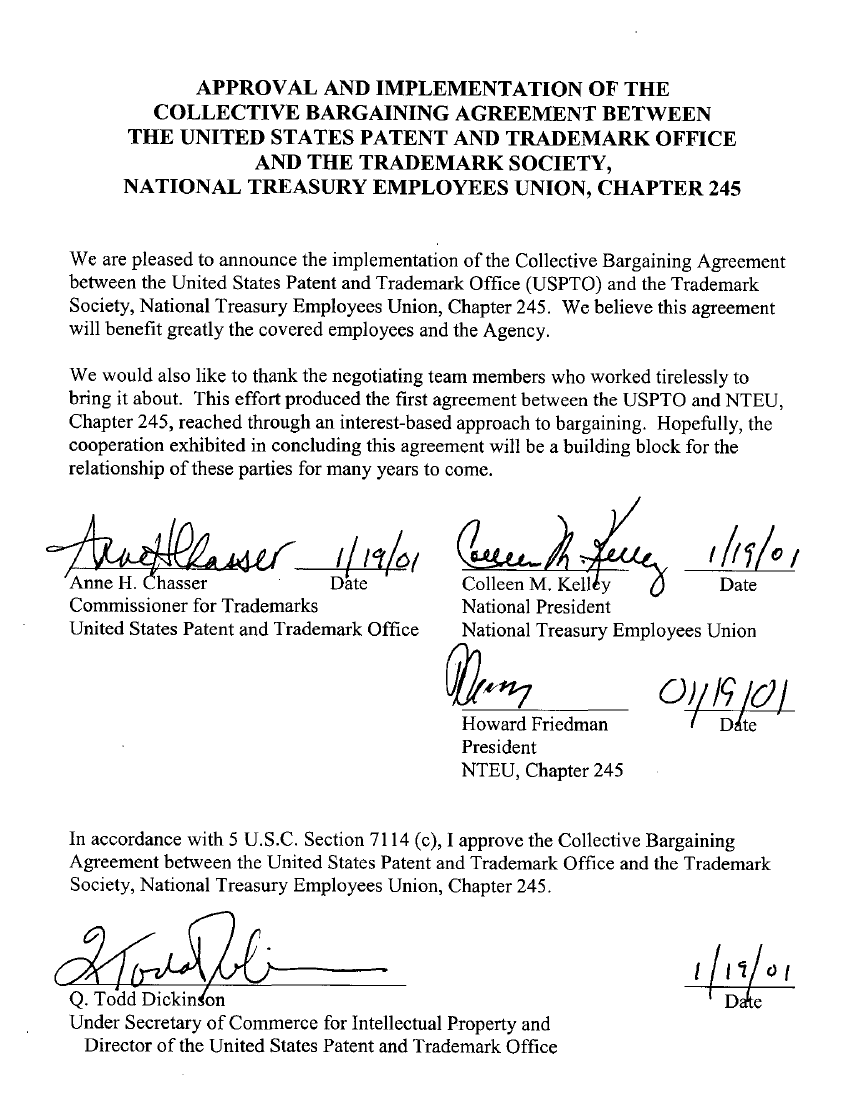
1

TABLE OF CONTENTS
RTICLE 1
PREAMBLE
A
4
ARTICLE 2
RECOGNITION AND REPRESENTATION 5
RTICLE 3
PRECEDENCE OF LAWS, REGULATIONS
A
6
RTICLE 4
DEFINITIONS
7
GHTS
A
ARTICLE 5
MANAGEMENT RI 9
RTICLE 6 MANAGEMENT OBLIGATIONS
A 10
RTICLE 7
EMPLOYEE RIGHTS
A
12
RTICLE 8
EMPLOYEE OBLIGATIONS
16
RTICLE 9
UNION RIGHTS
A
18
RTICLE 10 UNION OBLIGATIONS
A
A 20
RTICLE 11
GRIEVANCE PROCEDURE
22
RTICLE 12
PROMOTION AND REASSIGNMENT
A
30
RTICLE 13 PERFORMANCE APPRAISAL
A
A 37
RTICLE 14
PHYSICAL FACILITIES
42
OVERTIME
A
ARTICLE 15 47
RTICLE 16
UNION REPRESENTATION AND OFFICIAL TIME
48
RTICLE 17
UNION FACILITIES
A
51
A
ARTICLE 18 LEAVE 53
RTICLE 19
CAREER DEVELOPMENT DETAILS
62
RTICLE 20
REPRODUCTION AND DISTRIBUTION
A
64
RTICLE 21
DURATION
A
A
65
RTICLE 22
PROFESSIONALISM
66
RTICLE 23
PART-TIME EMPLOYMENT
A
A
68
RTICLE 24 CHILD CARE
A 71
RTICLE 25 OUTSIDE EMPLOYMENT
A 72
RTICLE 26
WORK SCHEDULES
74
RTICLE 27
RECEIPT OF PAY
A
A
81
2

ARTICLE 28
AUTOMATION 82
RTICLE 29
EQUAL EMPLOYMENT OPPORTUNITY
A
83
RTICLE 30
REDUCTION-IN-FORCE
85
RTICLE 31
PERFORMANCE BASED AWARDS
A
86
RTICLE 32
DUES WITHHOLDING
A
A
90
RTICLE 33
IMPACT AND IMPLEMENTATION BARGAINING
94
RTICLE 34
TRIAL PERIOD EMPLOYEES
A
96
RTICLE 35
DISCIPLINARY ACTIONS
A
A
97
RTICLE 36
ADVERSE ACTIONS
100
RTICLE 37
PARTNERSHIP
A
103
PPENDICES
A
A
DEX
IN
3

Contents
Article 1
Preamble
WHEREAS the Congress has found that experience in both private and public
employment indicates that the statutory protection of the rights of employees to organize,
bargain collectively, and to participate through labor organizations of their own choosing
in decisions which affect them, safeguards the public interest, contributes to effective
conduct of public business, and facilitates and encourages the amicable settlements of
disputes between employees and their employers involving conditions of employment;
and
WHEREAS the public interest demands the highest standards of employee performance
and the continued development and implementation of modern and progressive work
practices to facilitate and improve employee performance and the efficient
accomplishment of the operations of the Government; and
WHEREAS the well-being of employees and efficient administration of the Patent and
Trademark Office are benefited by providing employees an opportunity to participate in
the implementation of personnel policies and practices affecting the conditions of their
employment through the labor organization of their choice; and
WHEREAS the participation of employees should be improved through the maintenance
of constructive and cooperative relationships between labor organizations and
management officials; and
WHEREAS subject to law and the paramount requirements of public service, effective
labor-management relations within the Federal service require a clear statement of the
respective rights and obligations of all parties:
THEREFORE, labor organizations and collective bargaining in the Civil Service are in
the public interest.
The following articles and such supplemental agreements as may be made shall constitute
the Collective Bargaining Agreement by and between the U.S. Patent and Trademark
Office and the Trademark Society. It represents an attempt to state clearly the respective
rights and obligations of the parties. This is necessary if the parties are to deal with each
other effectively.
4

Contents
Article 2
Recognition and Representation
Section 1
In accordance with exclusive recognition first granted under Executive Order 10988 on
October 25, 1963, and continued under Title VII of the Civil Service Reform Act of
1987, 5 U.S.C. 7101, et seq., and as amended, the Office hereby reaffirms the recognition
of the Union as the exclusive representative of the employees in the bargaining unit as
follows:
All professional Trademark Attorneys and Examiners within the framework of the
Trademark Examining Operation of the Patent and Trademark Office and Interlocutory
Attorneys within the Trademark Trial and Appeal Board.
Not included are the following:
(1) Management officials or supervisors; (2) confidential employees; (3) employees
engaged in personnel work in other than a purely clerical capacity; (4) employees
engaged in administering the provisions of Title VII of the Civil Service Reform Act of
1978; (5) members of the Trademark Trial and Appeal Board.
Section 2
The parties agree that the terms and conditions of this Agreement apply only to
employees and positions within the bargaining unit.
Section 3
Upon a showing of need by either party and at the request of either party, an amendment
of the bargaining unit shall be considered. Nothing in this section shall preclude either
party from seeking a clarification of unit from the Federal Labor Relations Authority.
5

Content
Article 3
Precedence of Laws, Regulations, Past Practices and Past Agreements
Section 1
In the administration of all matters covered by this Agreement, the Union and the Office
are governed by the following:
A. Existing and future laws;
B. Government-wide rules and regulations in effect upon the effective date of this
Agreement;
C. DOC rules and regulations in effect upon the effective date of this Agreement and
not in conflict with this Agreement;
D. Government-wide rules and regulations and DOC rules and regulations issued
after the effective date of this Agreement that do not conflict with this Agreement.
Section 2
This Agreement supersedes all previous agreements and past practices in conflict with
this Agreement. Past practices not in conflict with this Agreement shall continue, absent
written notification by either party of their intent to discontinue or modify a particular
practice. Upon the request of either party, the parties shall bargain over the change as
required by law or this Agreement.
Section 3
To the extent that provisions of the Patent and Trademark Office published regulations
and policies are in conflict with this Agreement, the provisions of the Agreement will
govern. Otherwise, published regulations and policies of the Office will govern.
Section 4
Copies of any such laws, regulations or policies referred to above in the possession of the
Office shall be available for inspection and study by the Union upon request.
6

Contents
Article 4
Definitions
In the interpretation and application of this Agreement, the following words or terms
shall have the following definitions:
1. "The Office" shall mean the U.S. Patent and Trademark Office.
2. "Department" shall mean the U.S. Department of Commerce.
3. "The Union" shall mean the Trademark Society, NTEU Chapter 245, or any of its
officers, executive committee members or representatives, when acting in their official
capacities.
4. "Negotiations" shall mean the process by which the Office and the Union present
and consider proposals and counterproposals in good faith and as equals, under an
obligation to attempt to reach an agreement.
5. "Consultations" shall mean the process whereby one party solicits and/or receives
the timely submitted views of the other party and gives these views fair and serious
consideration prior to making a final decision.
6. "The CSRA" shall mean Title VII of the Civil Service Reform Act of 1978
(Public Law 95-454).
7. "Computation of time": In computing any period of time prescribed or allowed in
the Agreement, the day of the act, event, or occurrence from which the designated period
of time begins to run shall not be included. When the last day of any time period for
taking action falls on a Saturday, Sunday, or holiday, or when the Office is closed for
business for all or part of the day, the action may be taken on the next succeeding
workday. "Day" means calendar day unless otherwise specified.
8. "Alternative Work Schedule" shall mean any working arrangement which enables
a full-time employee to fulfill the basic work requirement of 80 hours per pay period in
less than ten full work days; or the work requirement of 40 hours per week in less than
five work days.
9. "Non-work day" shall mean any scheduled day off, which will normally be
Friday, Saturday, Sunday, Monday or Wednesday.
10. "Flexitime" shall mean the opportunity for employees to report to work each work
day at any time during the morning flexible band, be present during core hours, and leave
any time after they accumulated eight hours of work, plus one half hour for lunch.
11. "Restricted flexitime" shall mean a limited form of flexitime which occurs when
certain employees are not permitted to report at a time of their own choosing during the
7
morning flexible band, but they may be required to report no earlier than a specified time
during the morning flexible band.
8

Contents
Article 5
Management Rights
Section 1
The Office has the right, subject to 5 U.S.C. Section 7106(a) and (b)(2) and (3):
A. To determine the mission, budget, organization, number of employees and
internal security practices of the agency; and
B. In accordance with applicable laws, (1) to hire, assign, direct, layoff, and retain
employees in the Office, or to suspend, remove, reduce in grade or pay, or take other
disciplinary action against such employees; (2) to assign work, to make determinations
with respect to contracting out, and to determine the personnel by which the Office
operations shall be conducted; (3) with respect to filling positions, to make selections for
appointments from among properly ranked and certified candidates for promotion or
from any other appropriate sources; and (4) to take whatever actions may be necessary to
carry out the Office mission during emergencies.
Section 2
The Office specifically retains the right to make decisions concerning the numbers, types
and grades of employees or positions assigned to any organizational subdivision, work
project or tour of duty, or on the technology, methods and means of performing work.
However, nothing in this section shall preclude the Office, at its election, from
negotiating with the Union over the foregoing.
Section 3
Subject only to the limitations and conditions of this Agreement, it is agreed that the
rights and authority of the Office are vested in officials of the Office. Included in this
authority is the right, in accordance with applicable laws and regulations, to direct the
workforce; to hire, to promote, to retain, to transfer, and to assign employees to positions
within the Office; and to suspend, to discharge, to demote, or to take other disciplinary
action against employees.
Section 4
The right to make rules and regulations shall be considered an acknowledged function of
management officials. In making rules and regulations relating to personnel policies,
practices and matters affecting working conditions, such officials shall abide by
obligations to negotiate or consult imposed by law or this Agreement.
9

Contents
Article 6
Management Obligations
Section 1
The Office shall have due regard for the rights of employees and of the Union under
appropriate statutes (including the CSRA), rules, regulations and this Agreement.
Section 2
The Office will consult or negotiate with the Union as required by law or this Agreement.
Section 3
The Office shall consult the Union concerning any significant reorganization which
would substantially affect employees of the Unit and which would involve changes in
grade, duties, responsibilities, or reduction-in-force actions.
Section 4
The Office shall furnish to the Union a list of newly hired known unit personnel and their
locations during their initial two weeks of employment.
Section 5
The Office agrees that it will not retaliate by exercise of disciplinary or other
discriminatory action against employees of the unit because they have filed a complaint
or given testimony under an Act, statutory appeal, and grievance procedure or negotiated
procedure.
Section 6
A. In order that members of the bargaining unit and the officers of the Union may be
better informed as to their rights, obligations and responsibilities, management will
supply to the Union a listing of all duly published Office policies, PTO administrative
instructions and Department of Commerce Administrative Orders relevant to the
Trademark Office and will upon request provide copies of all such documents to the
Union. It is agreed and understood that every effort will be made by the Office to comply
with this section, but that failure to list or provide a copy of any particular document does
not relieve any employee of the obligation and responsibility to comply with previously
issued instructions, orders or policies.
B. Each affected employee shall be given a copy of newly published Office policies.
Section 7
10
The Office agrees to list the name and office telephone number of the local chapter
president in the Trademark Examining Organization telephone directory.
11

Contents
Article 7
Employee Rights
Section 1
Each employee shall have the right to form, join, or assist any labor organization, or to
refrain from any such activity, freely and without fear of penalty or reprisal, and each
employee shall be protected in the exercise of such right. Except as otherwise provided
under the CSRA, such right includes the right:
A. To act for a labor organization in the capacity of a representative and the right, in
that capacity, to present the views of the labor organization to heads of agencies and other
officials of the executive branch of the Government, the Congress, or other appropriate
authorities; and
B. To engage in collective bargaining with respect to conditions of employment
through representatives chosen by employees under the CSRA.
Section 2
An employee has the right to bring matters of personal concern to the attention of
appropriate management officials. Nothing in this Agreement shall preclude the exercise
of this right. Exercise of this right does not limit the right of the employees or the Union
to bring timely grievances under the negotiated grievance procedure.
Section 3
Employees will be treated with dignity and respect by supervisory personnel.
Section 4
A. When an individual from outside the PTO makes a complaint to the Office
regarding a unit employee, the Office agrees whenever possible to follow the following procedures,
subject to the limitations set forth in section (B) below:
1. The complaint will be reduced to writing, either by the complainant or by a
representative of the Office, which writing shall include the date(s) of the complaint.
2. The employee shall be given a copy of the complaint and the opportunity to make
a written response; such written response shall be attached to the complaint and filed by
the Office along with the complaint.
B. The procedures set forth in section (A) above shall be subject to the following
restrictions and limitations:
12

1. These procedures shall not apply to communications made to the Office of
Trademark Quality Review or to any communications which relate to alleged violations
of criminal law.
2. These procedures shall not be interpreted or applied to affect or jeopardize
management's compliance with any legal or regulatory prohibitions against the release of
information. Specifically, the Office shall not be required to release any information
where the release of such information is inconsistent with law, rule or regulation.
3. These procedures shall not be interpreted or applied to affect, jeopardize or
infringe upon management's right to protect its internal security or to determine its
internal security practices pursuant to 5 U.S.C. §7106.
4. These procedures shall not be interpreted or applied to limit management's right
to take disciplinary or other appropriate action.
C. * [A letter of reprimand will be removed from the employee's record no later than
12 months from the date of issuance. Oral admonishments confirmed in writing will be
removed after 3 months.]
D. If a written communication compliments the employee, a copy shall be given to
the employee.
E. This section does not abrogate employee rights to information under FOIA or
other sections of this Agreement.
Section 5
Unit employees will not be coerced or unduly pressured by supervisory personnel to
contribute to fund raising drives.
Section 6
A. Employees shall have the right to inspect their Official Personnel Folders in
accordance with reasonable Office policy.
B. All employees in the Unit shall be furnished a copy of any paper added to their
Official Personnel Folder which relates to their performance, conduct, or promotion
potential. Employees shall have an opportunity to submit a written statement of rebuttal
to be placed in the Official Personnel Folder. A copy of the rebuttal shall be furnished to
the employee's immediate supervisor.
Section 7
13

When a representative of management wishes to meet with an employee for the purpose
of obtaining information for determining whether disciplinary action shall be taken
against the employee, it shall be required that:
A. The management representative notify the employee of the general nature of the
meeting and of the right to have a union representative present.
B. In addition to the provisions of 5 USC 7114(a)(2)(b), which allows an employee
to have a Union representative present at a meeting when the employee reasonably
believes that an investigation, as part of the meeting, could lead to disciplinary action, the
management representative conducting the meeting shall notify the employee of the right
to Union representation, if the management representative reasonably recognizes that a
disciplinary action may result.
C. If the employee requests a Union representative, management shall be obligated
to wait a reasonable time to allow the employee the opportunity to secure representation,
before proceeding with the meeting.
D. None of the preceding subparagraphs shall apply to inquiries or counseling
sessions which apply solely to performance-based actions
Section 8
A. The Office shall notify the Union and the affected employee(s) of a proposed
substantial change in a bargaining unit employee position description, such as a
significant addition or reduction of duties or a change in grade level. The employee(s)
and the Union will have a reasonable period, not to exceed two weeks, to comment on the
proposed language which will not unduly delay issuance of the position description.
B. The Office shall provide the employees and the Union with the final amended
position description upon its issuance.
C. When an employee requests a desk audit, the Office shall conduct the audit within
a reasonable time under the circumstances.
Section 9
A. The Office will not deny access to information solely on the basis of the method
or manner of storage. The parties acknowledge that the Office is not obligated to write
new programs in order to retrieve data and that the Office is obligated to provide reports
which are generated in the normal course of business.
B. In the event of alternative means of providing information, the Office may choose
the least costly or time consuming alternative provided it does not unduly prejudice the
employees' rights to prompt and meaningful information.
Section 10
14

A. An employee may resign at any time and will normally give two weeks notice of
resignation.
B. Normally, resignations should be in writing. Requests to withdraw resignations
may be declined by the Office consistent with the provisions of 5 CFR, Subpart b, section
715.
C. When an employee resigns after receiving written notice of proposed disciplinary
or adverse action, the proposed action is to be included in the employee's records, unless
the Office and employee agree otherwise. When an employee resigns before receiving
written notice of proposed disciplinary or adverse action, no record will be maintained in
the Official Personnel Folder regarding the possibility of such action. All recorded
information within the control of the Office shall be specifically retained in a confidential
file maintained by the properly designated official in the Office of Personnel.
D. The Office shall not secure any employee's resignation by unlawful means.
D. An employee may withdraw his or her resignation up to the effective date of the
resignation or the time his or her position is legally committed, whichever occurs first.
Section 11
Any inquiry and investigation into allegations of off-duty misconduct must be based on
activity which, if verified, would have some nexus (i.e., some relationship) to the
employee's position. The parties agree that the conduct of employees while off duty shall
result in action only when there is a nexus between that conduct and the employee's
official position. Employees will not be subject to harassment or frivolous inquiries.
Section 12
When an employee is the subject of an investigation and the employee reasonably
believes that his/her answer may incriminate himself/herself of criminal misconduct, the
employee may assert his/her 5th Amendment right to remain silent, unless the employee
is given assurances that his/her answer may only be used for administrative purposes. If
an employee receives such assurances, any refusal to answer may be the basis for
disciplinary action.
Section 13
All employees may participate in the political process as permitted by law.
15

Contents
Article 8
Employee Obligations
Section 1
All employees are presumed to know and expected to comply with all laws and duly
published regulations and policies which relate to their employment and conduct. The
fact that a particular law, regulation, or policy may not be called to their attention by the
Office will not excuse any violation on their part.
Section 2
All employees are expected to observe Office hours and refrain from unauthorized
absences and leave abuse.
Section 3
A. Employees will make a good faith effort to return telephone messages when
received the same work day or, if received after 2:00 p.m., not later than the next work
morning.
B. Bargaining unit members are responsible for setting up their outgoing voice mail
messages properly.
Section 4
Unit employees shall provide a current mailing address and home phone number to their
immediate supervisor.
Section 5
Each employee shall attempt to perform to the best of his or her capability.
Section 6
Employees are to maintain a neat, clean, business-like appearance during working hours.
Clothing and behavior must be appropriate to the conduct of government business and
shall not be of a kind that would reasonably bring criticism to the Office.
Section 7
In all contacts with the public and with other government employees, employees will be
responsive, courteous and considerate.
Section 8
16

Employees shall not intentionally falsify Office records. Falsification of any Office
records may be the basis for disciplinary action.
Section 9
The employer is entitled to require truthful answers from employees in response to
questions in matters of official interest. An employee who fails to provide such answers
is subject to disciplinary action, including removal. An employee need not answer a
question from a manager or management representative if it does not pertain to official
business.
Section 10
Bargaining unit members will utilize electronic mail for the purpose of both receiving
work related messages or information and for responding to work related inquiries made
by electronic mail. Electronic messages will generally be reviewed at least once a day.
An employee may consult with his/her manager to determine how to appropriately
respond to an external customers email.
Section 11
The parties acknowledge that from time to time the Office issues electronic versions of
Office policies and procedures that typically contain the most up-to-date and accurate
data available and that such versions are the preferred source of guidance and should be
utilized.
17

Contents
Article 9
Union Rights
Section 1
As exclusive representatives of employees in the unit, the Union is entitled to represent
all employees in the unit.
Section 2
The Union shall have the right to bargain concerning any changes in the conditions of
employment of unit members, for which there is a bargaining obligation, in accordance
with Article 33, Impact and Implementation Bargaining.
Section 3
The Union has the right to consult with the Office concerning any matter affecting the
employees' working conditions, upon the request of an employee.
Section 4
In order to implement the Union's rights under 5 USC 7114 (a)(2)(A) to participate in
formal meetings, the Office shall make every effort to provide the Union a minimum of
five (5) hours advance notice for such meetings. In any event such advance notice shall
be reasonable under the circumstances and sufficient to allow the Union time to arrange
for representation at the formal meeting. The Union shall have the right to one (1)
representative at such formal discussions.
Section 5
Advance notice under Section 4 above shall include the time, place and topic of
discussion.
Section 6
The Union shall have the right to speak to all new unit employees at an orientation
session. The Union will be given adequate notice of the schedule for its presentation.
The Union's presentation will not exceed fifteen (15) minutes and shall not include any
direct solicitation for membership. The Union may provide and distribute copies of the
Agreement, newsletter and other materials at its presentation. The Union will be allowed
one (1) representative, on official time, at such orientation sessions. Nothing in the
Union's presentation, either oral or written or in the materials distributed, shall bring the
agency or any agency official into contempt or disrepute.
18

Section 7
The Union shall be entitled to all other rights provided for in other articles of this
Agreement or otherwise provided for by law, notwithstanding that they are not set forth
in this article.
19

Contents
Article 10
Union Obligations
Section 1
The Union, as the exclusive representative of all employees in the unit, has the
responsibility to represent the interest of all such employees without discrimination and
without regard to employee membership in the Union.
Section 2
The Union shall abide by the standards of conduct for labor organizations required by the
CSRA and regulations.
Section 3
The Union and Management agree to give reasonable advance notice of no less than 10
days, of the intent to file an unfair labor practice charge with the Federal Labor Relations
Authority (FLRA) so as to allow an opportunity for an informal disposition of the matter.
Section 4
The Union in discharging its duties, agrees to encourage its members to comply with
applicable regulations, the Agreement and Office policy.
Section 5
Pursuant to Section 7116(b) of the Civil Service Reform Act, the Union shall not:
A. Interfere with, restrain, or coerce any employee in the exercise by the employee of
any right under the Act or this Agreement;
B. Cause or attempt to cause an agency to discriminate against any employee in the
exercise by the employee of any right under this Agreement or the Act;
C. Coerce, discipline, fine, or attempt to coerce a member of the labor organization
as punishment, reprisal, or for the purpose of hindering or impeding the member's work
performance or productivity as an employee or the discharge of the member's duties as an
employee;
D. Discriminate against an employee with regard to the terms or conditions of
membership in the labor organization on the basis of race, color, creed, national origin,
sex, age, preferential or non preferential civil service status, political affiliation, marital
status, or handicapping condition;
20

E. Refuse to consult or negotiate in good faith with the Office as required by the Act;
E. Fail or refuse to cooperate in impasse procedures and impasse decisions as
required by the Act and the Agreement;
F. Call, or participate in, a strike, work stoppage, or slowdown, or picketing of an
agency in a labor-management dispute if such picketing interferes with an agency's
operations, or condone any such activity by failing to take action to prevent or stop such
activity. Nothing in this Article shall prohibit lawful informational picketing which does
not interfere with the Office's operations.
Section 6
The Union will not engage in unlawful coercion or intimidation against management.
Section 7
The Union supports maintenance of service-oriented and businesslike attitude and
behavior, particularly in dealing with the public, supervisors, management officials and
co-workers.
Section 8
Personal information about an employee received by the Union shall be safeguarded and
treated as confidential by the Union in order to protect employee privacy.
21

Contents
Article 11
Grievance Procedure
Section 1
The Office and the Union recognize and endorse the importance of considering employee
complaints and grievances promptly and, whenever possible, informally. The parties
agree that this grievance procedure will provide a mutually acceptable means of resolving
complaints and grievances at the lowest level possible, and the Office and Union agree to
work toward this end.
Section 2
A. The procedure described in these sections shall constitute the sole and exclusive
procedure available to bargaining unit members for resolving grievances under this or
any other negotiated agreement between the parties, e.g. flexitime.
B. This procedure is available to any member of the unit, to the Union on its behalf or on
behalf of member(s) of the bargaining unit, and to the Office. Any of the
aforementioned parties making use of this procedure shall be referred to, for the
purpose of this article, as the Grievant.
Section 3: Definition and Scope
A grievance is any complaint:
1. by a member of the bargaining unit concerning any matter relating to the employment
of that member; or
2. by the Union of the Office concerning any matter that relates to the employment of
any bargaining unit member or group of members or that relates to the rights of the
Union or the Office; or
3. by any bargaining unit matter that affects the member personally, or by the Union or
by the Office concerning:
(a) the effect or interpretation, or a claim of breach of this Agreement;
(b) any claimed violation, misinterpretation, or misapplication of any law,
regulation, or established personnel policy or practice affecting conditions of
employment;
(c) any claimed discriminatory or inequitable treatment; any violation of the
Merit System principles of 5 USC § 2301; or any prohibited personnel
practice of 5 USC § 2302.
22

Section 4
The following matters are considered not grievable under the provisions of this
procedure: Those matters excluded from coverage under 5 U.S.C. §7121(c) relating to:
A. any claimed violation of prohibited political activities;
B. retirement, life insurance, or health insurance;
C. suspension of removal in the interest of national security;
D. any examination, certification or appointment;
E. the classification of any position which does not result in the reduction in grade or
pay of an employee;
Section 5
The Office may cease to process and terminate a grievance upon:
A. the Union’s written request, when the Union is the Grievant;
B. the voluntary termination of the Grievant’s employment except where pay relief is
involved;
C. the death of a Grievant , except where pay relief is involved;
D. failure of the Grievant or the Union to meet any of the time limits herein; or
E. failure of the Grievant to properly set forth the substance of this grievance as required
by section 11(A) of this article. However, if the Grievant has substantially complied
with the provisions of section 11(A) but has omitted some material, the Office shall
notify the Grievant at the first level of the grievance procedure and the Grievant shall
have five (5) working days to provide the omitted material to avoid termination. The
Office’s period for response to the grievance shall be reset to start from the time the
omission is corrected; or
F. the request of the grievant
Section 6
In the event the Office fails to meet the requirements of these sections, the Union or the
grievant is permitted to proceed to the next step of the grievance procedure. However, if
23

a decision is rendered after the time limit, that decision shall become a part of the record.
Section 7
In the event either party should declare a grievance non-grievable or non-arbitrable, the
original grievance shall be considered amended to include this issue. The earlier this
declaration is made, the better. However, in no event can such declaration be made after
the issuance of the second step answer. All disputes of grievability or arbitrability shall
be referred to arbitration as a threshold in connection with the related grievance.
Section 8
When the Office and the Union agree that grievances should be combined, the Union
will select one case for processing under the grievance procedure. The employees will be
advised that in processing one grievance for the group, the decision of the case selected
will be binding on all other cases. Names of all employees involved in this procedure
will be made a part of the record of the case selected for processing, and when a decision
is made on the grievance, each employee will be individually notified.
Section 9
A matter of concern or dissatisfaction orally expressed by an employee to his or her
supervisor is not a grievance provided for by this section and is not subject to them.
Section 10
A Grievant shall have the right to represent herself/himself.
Section 11
The following steps constitute the required steps for processing grievances:
A. First Step
1. The grievance must be reduced to writing. The written grievance shall be
submitted within (30) calendar days after the event or action prompting the
grievance, or the date the Grievant became aware of, or should have become
aware of, the event or action. If the grievant files a FOIA or information request
simultaneously with the grievance and the information is received before a
hearing occurs or a decision is rendered, the grievanct, at his or her request, will
be granted a five (5) working day extension to amend the grievance. However,
such amendment must be within the scope of the original grievance and must be
based upon the information received. The deciding official will be allowed five
(5) additional working days to render a decision.
24
2. The written grievance shall be submitted to the lowest level supervisor with
authority to resolve the grievance (usually the employee’s immediate supervisor),
who shall render a written decision within five (5) working days. If the
management official to whom the grievance is submitted feels that he or she does
not have the authority to resolve the grievance, he or she will direct the grievance
to the proper official within three (3) working days. If, because of the nature of
the grievance, either the Union or the Office feels that immediate supervisor is not
the appropriate Step One official, that party may contact the Labor Management
Relations (LMR) Office to discuss whether such supervisor should hear the
grievance. LMR will consult with the appropriate official(s) and shall designate
the Step One official. If an employee is grieving a performance rating and has
already requested reconsideration by the approving official, the grievance will
begin at Step Two. The proper official shall render a written decision within five
(5) working days of receiving a grievance from the management official. If the
proper official is the Commissioner for Trademarks, second step procedures will
be used.
3. In the case of an Office grievance, the designee of subparagraph A.4(f) of this
section should be the employee who will handle the grievance for the Office and
the Union President shall be the person to receive the written grievance.
4. The written grievance must contain the following information:
a) name, grade, title, and work unit of the Grievant, name of the person
representing the Grievant, or name of the person representing the Union
if it is a Union grievance;
b) the name and title of the official to whom the grievance is submitted and
the date submitted;
c) a detailed statement describing the facts involved, the date the incident
occurred which gave rise to the grievance, or the date the Grievant
became aware of the incident;
d) the Agreement article(s) and section(s), law(s), regulation(s), rule(s)
and/or other item(s) violated, misinterpreted or misapplied;
e) the remedy desired;
f) a statement that the Union, or its designee, is representing the Grievant,
or that the grievant chooses self representation; and
g) the Grievant’s signature
B. If the first step fails to produce a satisfactory resolution, the Grievant may proceed to
the second step.
C. Second Step
1. Within five (5) working days of the decision at the first step, the grievant must
25

present in writing a request to proceed with the grievance to the Commissioner for
Trademarks or a designated representative, who may not be the step one decision
maker.
2. The written request shall include a copy of the original grievance, the step one
decision and preferably should specify that portion of the step one decision to
which Grievant has objection.
3. The Commissioner for Trademarks or designated representative shall conduct an
investigation which may include a conference with the Grievant, the Grievant’s
representative, the Union, and/or witnesses, if requested and shall render a written
decision. However, the Grievant may waive his or her right to have a conference
at any time after the decision at the first step. If a conference is requested and
later waived, the deciding official will have ten (10) working days from the
waiver date to render a decision.
4. The Commissioner for Trademarks or designated representative shall render a
written decision within ten (10) working days if no conference is held, or within
ten (10) working days after any conference is held.
5. If the Grievant represents himself/herself, the Union shall have the right to have
an observer at the conference.
D. Referral to Arbitration
In the event that step one in the case of an Office grievance, or step two in the case in the
individual or a Union grievance, fails to produce a satisfactory result, either the Office or
the Union may proceed to arbitration as provided in Section 14.
Section 12: Institutional Grievances
For institutional grievances, in lieu of step-by-step procedures outlined above, the Union
may submit a written grievance to the Commissioner for Trademarks, or designated
representative. Upon request of the Union, the Office and the Union shall meet within
ten (10) working days to discuss the grievance. A written decision shall be rendered
within ten (10) working days after the meeting or within ten (10) working days of the
filing of the grievance if no meeting is requested. If the Union is not satisfied with the
decision, the Union may proceed to arbitration as specified in Section 14
Section 13: Rights of Parties
A. An employee is entitled to representation at any of the steps of the grievance
procedure. However, nothing in this Agreement shall require the Union to represent
an employee if the Union considers the grievance to be invalid, without sufficient
merit, or for other good reasons (e.g., financial)
26

B. A copy of any document becoming part of the grievance record under this article shall
be furnished to the Grievant, Union, Offices, and parties (if combined grievance
under Section 8) by the person presenting the document.
C. The Office shall provide requested information, records and evidence under its
control or in its possession in a timely and accurate manner accordance with
applicable law. Such requests should be reasonable. If a dispute arises over access to
information in connection with a grievance, it will be joined to the grievance unless
the Union decides to pursue an Unfair Labor Practice (ULP) with the Federal Labor
Relations Authority (FLRA)
D. Since dissatisfactions and disagreements may occasionally arise among people in any
work situation, the Office agrees that no reprisal will be taken against any employee
for initiating a grievance.
E. The Union has the right to advance notice of and to be present at any Office initiated
meeting with the Grievant or any meeting with the Grievant after the step one
decision is rendered.
F. If the Union is not the designated representative of the Grievant, the Union shall
have the right to file an “amicus-type” statement for informational purposes. This
statement shall become part of the grievance record.
Section 14: Arbitration
A. The Union and the Office shall have the right to have a grievance submitted to
binding arbitration. The Union or the Office shall initiate arbitration by filing written
notice with the Chief of the Employee/Labor Relations Division or with the President
of the Union, as applicable, of its desire to arbitrate within twenty (20) calendar days
after the final Office or Union decision has been rendered. Arbitration may be
invoked only by the Union or by the Office. An employee does not have the right to
invoke arbitration.
B. The parties shall attempt to select a mutually acceptable Arbitrator within ten (10)
calendar days from the date of receipt of the notice in Section 14(A) by the other
party.
C. If the parties fail to agree on an Arbitrator within this time period, the parties shall
request a panel of seven (7) arbitrators from the Federal Mediation and Conciliation
Service. Within fourteen (14) days of receipt of the list, the parties shall meet to
choose an Arbitrator. The party to make the first strike shall be determined by a coin
toss. Each party shall alternate in striking through the name of an Arbitrator until one
Arbitrator remains. That arbitrator shall be deemed selected and shall specify the
27
procedures to be followed during the arbitration proceedings as long as such
procedures are in accordance with the provisions of this Article.
D. The Federal Mediation and Conciliation Service shall be empowered to make a direct
designation of an Arbitrator or allow one party to specify an Arbitrator to hear the
case in the event;
1. Either party refuses to participate in the selection of an Arbitrator; or
2. There is inaction or undue delay on the part of either party.
E. Arbitration is provided in this grievance procedure as a means of obtaining the
services of a third party, when necessary, to assist in the resolution of grievances.
The arbitration procedure set forth herein shall not be extended to include matters
related to changes or proposed changes in this Agreement, such changes being subject
to negotiation under the terms of this Agreement, nor shall it be extended to disputes
over any matter excluded from the grievance procedure by this Agreement.
F. The Arbitrator shall have the authority to interpret this Agreement as necessary to
render a decision consistent with the provisions of this Article. The decision of the
Arbitrator shall in no way change or amend this or any supplemental agreements or
regulations which take precedence over this agreement.
G. The Office and the Union shall attempt to agree in writing upon the precise issue(s) to
be decided, and shall submit a joint statement to that effect in advance of any
arbitration proceedings. If the parties are unable to concur, each party shall specify
the issue in writing with copies to each other and to the Arbitrator. The moving party
shall include with its statement of issues the redress it expects from the arbitration.
H. The arbitration proceeding shall be held on premises provided by the Office.
I. The Arbitrator shall be requested to render a decision to the Office and the Union no
later than forty-five (45) days after the conclusion of the hearing or the Arbitrator’s
receipt of post-hearing briefs, if they are submitted. The hearing will only be
conducted if the parties are unable to stipulate as to the facts of the case.
J. The prevailing party shall be entitled to all relief or remedies provided for under the
law.
K. Either party may file exceptions to the Arbitrator’s award with the Federal Labor
Relations Authority under the regulations prescribed by the Authority.
L. Each party shall pay the expenses of its own witnesses, its own travel expenses and
for any transcript or other record of the proceedings desired by the party.
M. The Union and the Office shall share equally in the cost of arbitration.
28

Section 15
Absence of either party from the Office on approved leave for eight (8) consecutive hours
or continuous eight (8) hour increment shall constitute an automatic extension of the time
limit set forth herein for an equal period of time for the party who is absent. For the
purpose of this Section, when the Union is the Grievant, the President of the Union is the
party whose approved leave may extend the time limits. Automatic extension under this
Section will be limited to fourteen (14) days.
Section 16
The Union and the Office agree it is mutually desireable to handle disputes amicably and
in a fair and expeditious manner. To this end, this Article may be re-opened by either
party, but not later than one year from the effective date of this agreement, to discuss an
Alternate Dispute Resolution (ADR) procedure as an alternate resolution for grievances
and EEO complaints. If one party requests the inclusion of ULP procedures in the
discussion it will be included if both parties agree. If neither party re-opens within one
year, then the re-opener option, as it pertains to this section, expires.
29

Contents
Article 12
Promotion and Reassignment
Section 1
All vacancies described in this article shall be filled on the basis of merit, fitness and
qualifications and without regard to race, color, religion, national origin, personal
favoritism, age, marital status, sex, physical handicap, political or employee
organizational affiliation, except as may be authorized or required by law. The Office
will select individuals for promotion and reassignment to positions in the bargaining unit
in accordance with applicable laws and regulations so as to develop employee
confidence.
Section 2
It is the right of the Office to promote and reassign employees consistent with the
appropriate laws, regulations, policies and practices and the provisions of this Agreement.
Section 3
Sections 3-5 cover the following competitive actions or bargaining unit employees to
classified bargaining unit positions:
A. Competitive promotions;
B. A temporary promotion over 90 days. All prior service at the higher grade level
during the preceding 12 months including details to higher grade positions or
temporary promotions must be counted as part of the 90 days.
A temporary promotion may only be made permanent without further competition if
the fact that it might lead to a permanent position was originally made known to all
potential candidates and the temporary promotion results from a competitive process;
C. Reassignments to positions with known promotion potential to higher than the
employee’s current position.
Section 4
A. The Office will send a vacancy announcement via electronic mail to each bargaining
unit member to cover all vacancies that must be filled in accordance with the
procedures of this Article. The announcement will be sent via electronic mail within
a minimum of ten (10) days prior to the closing date.
30
B.
When announcements are issued they will contain:
1. Announcement number;
2. Opening and closing date;
3. Position title, series and grade;
4. Organization location and duty station;
5. Known promotion potential/career ladder status where appropriate;
6. Principal duties;
7. Minimum qualifications required;
8. Evaluations methods;
9. Statement of equal employment opportunity;
10. Selective placement factors, if any; and
11. Number of positions to be filled.
C. Applicants must meet all qualification requirements by the closing date of the
vacancy announcement.
D. Ranking factors must be job related and will not be tailored to fit the qualifications of
a particular individual.
E. Notice of all vacancy announcements subsequently cancelled will be sent to each
bargaining unit member, via electronic mail.
F. The Office shall individually notify all candidates as to whether they were selected or
not. In addition, the Office will notify all applicants who have applied for a position
which was announced and open but subsequently withdrawn.
G. If there are more than 8 candidates subject to panel evaluation, all eligible candidates
will be evaluated and ranked in a fair and objective fashion.
H. In order to provide a fair ranking of more than eight candidates subject to panel
evaluation an evaluation panel will be utilized. The panel will be constituted in the
following manner:
A panel for a particular position will consist of at least three members, selected by the
Office of Personnel, one of whom shall be from an office or unit other than the one in
which the vacancy is located. At least one of these members must be familiar with the
work where the vacancy is located. When advice and guidance on the interpretation of
qualifications is considered essential, the selecting official may advise the panel but has
no vote. Such advice should normally be provided before the panel receives the names
and applications of the candidates.
I. Within thirty days after the vacancy announcement has closed, the panel shall
evaluate and rank the candidates as “Qualified” and “Best Qualified.” All eligible
candidates will be evaluated on the basis of valid job-related criteria which measure
31
the knowledge, skills, abilities and personal characteristics essential to successful
performance in the position to be filled. The panel shall maintain a record of what
points are credited to each candidate. Upon the filing of a grievance or formal
complaint regarding the selection, records of the panel shall be available to the Union
and the grievant in accordance with applicable law and regulation. These records
shall be retained for two (2) years or until any grievance or formal complaint
regarding the selection is finally resolved, whichever, is longer.
J. Apart from documented cases of leave abuse, an employee’s accumulation or balance
of annual or sick leave may be considered by the ranking panel or ranking official,
selecting official or supervisor as a basis for selection for promotion.
K. When all eligible candidates have been evaluated and ranked, the Office will
promptly issue form CD-262, “Merit Assignment Program Certificate,” listing the
names of the best qualified candidates in alphabetical order, to be considered by the
selecting official.
1. A Certificate will usually include the names of three to five best-qualified
candidates for the vacancy to be filled. Additional candidates maybe certified
where meaningful distinctions cannot be made. Ten the maximum number of
best qualified candidates that may be referred to the selecting official, except
as stated in subsection 3, but the number of candidates may be increased to the
extent necessary to include all of the candidates available from other
appropriate sources as “other appropriate sources” is used in 5 USC 7106
(a)(2)C(ii).
2. In cases where meaningful distinctions of qualifications cannot be made
through the application of quality ranking factors and an excessive number of
candidates are considered equally qualified, up to 10 candidates may be listed
on a certificate based on seniority with the Office.
3. When there is more than one vacancy to be filled from a certificate, one
additional candidate may be added to the certificate for each additional
vacancy. In the event additional vacancy(is) occur within one month after an
announcement has closed, the old announcement maybe used to fill the vacant
position.
4. After all eligible candidates subject to panel evaluation are ranked, PTO
employees will be considered for vacancies under the procedures of this
article before any other candidates are considered.
5. Once non-PTO employees are considered, PTO employees will be
simultaneously considered.
6. When a PTO employee is passed over for selection in favor of a non-PTO
applicant, the former will be given a written explanation of all the reasons for
32
non-selection.
7. A Merit Assignment Program Certificate is valid for (30) calendar days from
the date of the issuance. The certificates may be extended for 30 additional
days upon a valid request by the selecting official.
8. Interviews, with the selecting official are optional. If one member of the best-
qualified group is interviewed, all must be interviewed.
9. If the candidate selected is a unit employee, he/she shall be promoted at the
beginning of the next pay period following completion of all necessary
approvals and processing requirements. Under unusual circumstances, (e.g.
permit arrangements to be made for the completion of essential assignments),
this time period for promotions may be extended.
L. When requested by a competing bargaining unit applicant, the Office shall furnish the
following information after the action has been completed:
1. The name(s) of the individual(s) selected;
2. Whether the applicant was found to be qualified;
3. Whether the applicant was referred to the selecting official;
4. Any other relevant and necessary information which is permitted by law, which the
applicant may require to prosecute a grievance or other challenge; and
5. In what area, if any, a bargaining unit employee may improve his or her qualifications
to enhance chances for future selection. (This information normally will be furnished
by means of a counseling discussion with either a representative of the Office of
Personnel or a knowledgeable supervisor.)
M. Upon request at completion of the selection process, a copy of the completed ranking
and selection report shall be made available to the Union. The ranking and selection
report will contain, at a minimum the following;
1. Announcement;
2. Date of Report;
3. Number of vacancies;
4. Sanitized summary of the panel scores;
33

5.
The series, grade of the employee referred, if the candidates were within the
bargaining unit;
6. If candidates were not bargaining unit employees, this will be so designated;
7. Selection action (i.e. clear indication of which candidates were selected);
8. Date of selection action; and
9. Date eligible for promotion.
N. Grievances arising out of the application of the promotion plan shall be processed
under the negotiated grievance procedure. It is understood that non-selection for
promotion from a group of properly ranked and certified candidates is not grievable.
O. Due consideration will be given to requests for voluntary downgrades.
Section 5
No member of the unit shall be placed in a disadvantageous position with regard to
promotions by virtue of officially initiated service on a detail or work project.
Section 6
A. This section covers temporary promotion actions to bargaining unit positions of 90
days or less.
B. When an employee in the bargaining unit is temporarily assigned to another position
in the bargaining unit classified at a higher level for more than thirty (30) days, a
temporary promotion will be made under applicable rules and regulations.
Section 7
A. This section covers career ladder promotions to positions through the GS -13 level.
Employees in identified career ladder positions working below the GS-13 level will
be eligible for promotion provided that the employees meet the requirements of the
position including satisfactory demonstration of ability to perform at the next higher
grade and have a current Fully Successful performance rating, and there are sufficient
funds and higher level work to be performed.
The effective date will be the beginning of the first pay period after all applicable
regulations and approval requirements are met. Employees who meet the requirements
for promotion and who are not promoted after meeting all applicable regulations and
approval requirements and in accordance with the Back Pay Act, 5 USC 5596, 5 USC
550 subpart H, and relevant Computer General decisions, shall be entitled to back pay
from the first pay period after meeting such regulations and approval requirements.
34

Bargaining unit employees who are not promoted after completion of the minimum time
in grade shall have the right to request and receive a written statement from their
supervisor after face-to-face discussion between them. The supervisor's statement shall
list the reasons for withholding the promotion and explain how the employee's
performance can be improved to qualify for promotion.
Section 8
Approved leave, whether sick leave or annual leave or leave without pay shall not be
used as a basis for determining ability to perform the job under the terms of this article
unless the leave in of such duration that the employee has not adequately progressed in
job knowledge or performance or unless there have been frequent instances of sick leave
or tardiness which, though approved, have been the subject of counseling between the
employee and supervisor. Five Hundred twenty-two (522) hours of leave in one year
shall be considered prima facie
proof of inadequate progress in job knowledge or
performance for purposes of promotion.
Section 9
The Office shall consult semi-annually with the Union upon request regarding
professional staffing goals and hiring plans.
Section 10
The Office hereby expresses willingness to consider promptly written requests made to
designated Office officials for transfers or reassignments from all members of the unit.
Requests for reassignment within one’s series and grade will be honored subject to the
needs of the Office. If a request is denied, it must be denied in writing. Thereafter,
management will consider the denied request to be ongoing and will approve the request
as soon as practicable, subject to the needs of the Office. In any event, the Office will
provide the status of an ongoing request to an employee once every six months or earlier
upon employee request. Nothing derogatory shall be connoted in any request for transfer
or reassignment and the individual so requesting shall be free from discrimination or
reprisal therefore.
Section 11
Request for personnel action will be processed promptly.
Section 12
The Office agrees that the promotion of an employee shall not be delayed only because
the employee’s supervisor has been newly appointed to that position and is unfamiliar
with the employee’s work.
35

Section 13
When it is necessary to reassign employees due to staffing imbalance, the Office will
first ask for volunteers from among the qualified employees at the affected office. If
there are too many volunteers, the employees with the oldest PTO service computation
date shall be given first consideration for the reassignment, absent operational needs. If
there are too few volunteers, employees with the most recent PTO service computation
date will be given first consideration for the reassignment, absent operational needs.
36

Contents
Article 13
Performance Appraisal
Section 1
Employee performance evaluations will be conducted pursuant to the General Workforce
Performance Appraisal Systems (GWPAS), attached as Appendix ___. GWPAS is
attached for reference. In the event of a conflict between GWPAS and the terms of this
Article, the terms of this Article shall prevail.
A. There will be appraisals for details after 90 days
B. There will be a 45 day notice of a change in plans and a 15 day comment period.
C. The Union will be notified of a change in plans before employees are notified.
D. If the Office intends to change performance plans after performance plans for the
rating year are in effect and the change is a temporary modification of the plan for one
month or less, and is caused by an extraordinary business emergency, then the change
may be implemented after a fifteen (15) day notice period. In such cases the impact and
implementation bargaining, if requested, shall begin during the notice period.
E. The Union will be the exclusive employee representative to consult with the Office in
the development of the performance plans. Individual employees will retain the right to
dispute the application of the plan to their individual circumstances. This does not
prejudice the Union's right to represent employees in grievances concerning performance
appraisal.
F. If a rating official and an employee disagree over the application of any performance
plan items, the rating official and the employee should attempt to resolve the
disagreement through discussion. If discussion fails to resolve the dispute, either party
may ask for a review of the dispute by the approving official. If the dispute remains
unresolved, the approving official shall make the final decision regarding the content of
the plan.
G. Normally, employees will get their plan at the beginning of the rating period.
H. In the event that application of this rating system leads to an unfair or unreasonable
overall performance rating, the rating official shall have the ability to assign a
performance rating that is fair and reasonable under the circumstances.
37

I. All appraisals of performance will be made in a fair, reasonable and accurate
manner, based upon the employee's performance during the appraisal period, using
verifiable data.
J. All ratings must also be based on adequate observation and knowledge by the
rating official of all factors affecting the employee's performance. If the rating official
feels that he/she is not able to properly evaluate an employee's performance because of
lack of opportunity to observe performance, the rating official may request an extension
of the due date of an official rating for a period up to but not to exceed three (3) months.
Adverse comments relating to an unsatisfactory rating made by the supervisor must be
supported by appropriate and actual examples.
K. Management has determined that it will continue to apply supplemental standards.
Section 2
A. An employee paid at less than step 10 of the grade of his or her position, shall
earn advancement in pay to the next higher step of that grade upon meeting the following
three requirements established by law:
1. The employee's performance of the duties and responsibilities of his or her
assigned position, must be at an acceptable level of competence.
2. The employee must have completed the required waiting period for
advancement to the next higher step of the grade of his or her position.
3. The employee must not have received an equivalent increase during the
waiting period.
B. At least ninety (90) days prior to the date that an employee is eligible to receive a
within-grade increase, the employee's supervisor will notify the employee as to his or her
performance. If the Office, through administrative oversight, fails to give this warning
notice 90 calendar days in advance of the within grade increase due date, the within grade
determination shall still occur on time and the Office shall still provide a 90 calendar day
improvement period. If after the improvement period, the employee improves to an
acceptable level of competence, the within grade increase may be granted at the
beginning of the next pay period.
C. If the supervisor believes that the employee's work is not at an acceptable level of
competence, the 90 day notice must outline all the reasons for the supervisor's belief,
along with citations to relevant examples of poor performance.
D. If the final decision is to deny the increase, this must be stated in writing along
with the reasons relied upon in making the final decision. The employee's right to appeal
and the procedures for such will be outlined in the letter.
38

E. At any time after the increase has been denied, the employee has the right to the
increase, when the Office determines that he/she has demonstrated sustained performance
at the acceptable level of competence.
Section 3 : Action Based on Unacceptable Performance
A. If an employee’s performance is at an unacceptable level, a reduction in grade or
removal may be initiated. The procedures set forth in 5 USC Chapter 43 and
GWPAS or 5 USC Chapter 75 may be followed, if appropriate, at the election of the
office.
B. If the rating official believes that the employee could benefit from participation in
the Office Employee Assistance Program, the rating official shall fully consider the
program's provisions prior to taking action against the employee. However, employee
participation in this program is strictly voluntary.
C. An employee can request any other action to assist the employee in raising his/her
performance level from his/her supervisor, Employee Relations, Office of Civil Rights, or
other appropriate management official.
D. If the employee's performance continues to be unacceptable, formal personnel
action, in the form of reduction in grade or removal may be initiated. If this action is
undertaken, the procedure set forth in 5 CFR 432 will be followed, if legally appropriate.
E. The actions covered by this section are reductions in grade and removals for
unacceptable performance taken under 5 USC Chapter 43. All provisions of the Civil
Service Due Process Amendments (Public Law 101-376), attached as Appendix D, apply,
except as modified below.
1. A non-preference eligible (non-veteran) employee who has completed two years
of current continuous employment in the same or similar positions against whom an
action based on unacceptable performance has been taken may appeal the decision to the
Merit Systems Protection Board, or with the consent of the Union, to arbitration under the
terms of this agreement, but not both.
2. A preference eligible (veteran) employee who has completed one year of current
continuous employment in the same or similar positions, and against whom an action
based on unacceptable performance has been taken may appeal the decision to the Merit
Systems Protection Board, or with the consent of the Union, to arbitration under the terms
of this agreement, but not both.
F. Prior to proposing any action under 5 USC Chapter 43, the Office will provide a
performance improvement period in accordance with Article 13, Section 3. If during the
performance improvement period (PIP), the employee has demonstrated definite
improvement, but not quite enough to meet the marginal level of performance, then
39
management may extend the PIP for a reasonable time or propose a reduction in grade or
removal as appropriate.
G. A meeting between an employee and his/her supervisor and/or other officials of
the Office during which the principal topic of discussion is an action or potential action
for unacceptable performance (i.e., a reduction-in-grade or removal for unacceptable
performance) will entitle the employee involved to be accompanied by a Union
representative during such meeting. If such a request is made, the supervisor or other line
management official will honor the request. If after the proposal notice has been
delivered and the employee has designated the Union as his/her representative, the
employee shall have the right to have the Union represented at any discussion between
the Office and an employee. The Union reserves its rights under Article 9, Section 4 and
statute.
H. An employee whose reduction in grade or removal is proposed under this article
shall be provided with at least thirty (30) days advance written notice of the proposed
action that identifies:
1. the specific instances of unacceptable performance by the employee on which the
proposed action is based;
2. the critical element(s) and standards of the employee's position involved in each
instance of unacceptable performance.
3. the employee's right to reasonable time to answer the agency's notice of proposed
action orally and/or in writing. Reasonable time shall normally be considered to be 14
calendar days from receipt of the proposal. Reasonable extensions of time will be
granted if requested and for good cause shown;
4. the employee's right to representation by the Union, an attorney or other
representative of his/her own choosing.
I. The employee will be provided copies of all documents, which contain evidence,
relied upon by the Office in proposing the action. If any portion of an investigative
report is to be used as evidence, that portion will be included, i.e., the employee will be
presented with a proposal and supporting evidence that is identical to that transmitted to
the deciding official. Nothing in this section is to be construed as a waiver of the
employee's or the Union's right to request additional information under other
authorization, such as the Freedom of Information Act, the Privacy Act, or the Civil
Service Reform Act.
J. The employee shall have the right to be represented by the Union or by an
attorney or other representative of his/her own choosing in connection with the oral
and/or written reply.
40

K.
The Office shall prepare a summary of any oral reply. Copies of the summary
shall be provided to the employee and his/her designated representative for review and
correction before any decision is made concerning the proposed action.
L. A proposed action may be based on instances of unacceptable performance which
occur within a 1-year period ending on the date of the proposed action. The employee
shall receive a written decision specifying the reasons for the action taken and addressing
employee allegations of pertinent factual discrepancies. The decision will have the
concurrence of an official at a higher level in the organization than the one who proposed
the action. Copies of the decision will be served on the employee and the designated
representative. The decision shall not be effective before the end of the 30 calendar day
period.
M. Whenever management has decided to effect a reduction in grade or removal, the
employee will be offered an opportunity to resign before the written decision is issued.
N. If because of performance improvement by the employee during the notice period,
the employee is not reduced in grade or removed, and the employee's performance
continues to be acceptable for 1 year from the date of the advanced written notice
provided for in Section 3H of this article, any entry or other notation of the unacceptable
performance shall be removed from any Office record relating to the employee.
O. The Office shall provide a sanitized copy of all performance based proposals and
decision letters to the Union simultaneous to their issuance to employees. Sanitized
decision letters are not required when the Union has been served under Section 3L above.
Section 4
All scores given to employees other than fully successful, will be supported by written
narrative justifications citing specific examples.
Section 5
Arbitrators will be free to change an employee’s appraisal score in accordance with
existing case law.
41

Contents
Article 14
Physical Facilities
Section 1
The Office and the Union agree that a healthful environment is desirable. Therefore, the
Office and employees will observe all applicable rules and regulations relating to safety
and health in the work place.
Section 2
A. The goal of the Office shall be to provide a private, wall enclosed (full ceiling height)
Office to all employees. Toward that end, the Office agrees to provide the following
or to make a good faith effort to secure space so as to provide the following:
1. a private office of at least 120 square feet to all GS-13 employees or above
employees except that employees who work at home or who work part-time
may be required to double or share office space;
2. a work area of at least 65 square feet per person for all employees doubled in
offices. When doubling is necessary, it shall be done by seniority among
employees on each floor. Except that where two employees within the same
Law Office request to share an office, their request will be honored, if practicable.
B. Should existing space prove inadequate to satisfy subparagraphs A1 and 2 above,
the Office agrees to give good faith consideration to the reallocation of existing space
and to the acquisition of additional space.
C. The Office agrees to consult in good faith with the Union about any problems with
respect to achieving subparagraphs A1 and 2. Further, the Office will keep the Union
apprised of its efforts to gain additional space. The Office will bargain in good faith
to the extent required by law with the Union with regard to any move to additional or
new space.
D. When doubling is necessary, it shall be structured as follows:
1. it shall be done by seniority among employees on each floor, except that part-time
and Trademark Work at Home (TWAH)employees will be doubled before full-
time employees working at the office;
2. before two full-time employees are doubled on a floor, the Office will double one
full-time employee with one part-time or TWAH employee or have them share an
office, when practicable;
3. where two employees within the same law office request to be doubled in an
office, their request will be honored, if practicable;
42
4. employees occupying interior offices will not be required to double in an office
unless and until all exterior offices have two attorneys doubled in the space; more
senior attorney with exterior offices on that floor will be given the option of either
doubling in an exterior office or taking an interior office alone;
5. employees shall be given two weeks notice that they are to be doubled. However,
if 2 weeks notice is not practicable, then employees will be notified as soon as
feasible. Employees will be notified as soon as practicable of the names of other
employees who are to be doubled;
6. the Office may provide telephone headsets to doubled employees, upon their
request, and if the Office determines that the costs are reasonable;
7. the Office shall collect and share with the Union within forty-five (45) days after
the relevant period, data comparing the performance of employees who are
doubled against employees who are not doubled as soon as ten (10) employees are
doubled (e.g. five (5) doubled offices), excluding part-time or TWAH employees;
production data will be collected quarterly and quality, phone percentage and
docket management data will be collected semi-annually; the Office shall collect
data by grade-level and will share sanitized reports and progress reviews with the
Union; the Office shall consult quarterly with the Union concerning these
activities, upon Union request; nothing herein prevents the Union from collecting
its own data as it sees fit;
8. the President and Vice-President of NTEU, Chapter 245 will not be doubled-up in
their offices.
E. The Office shall allow for intra-law office moves to occur as follows:
1. employees may voluntarily move to an available office once per quarter, except
that moves between window offices may not be made more than once every six
(6) months; moving from an interior office to an exterior window office shall not
be counted as a move;
For example:
If an employee is hired on Jan.1, the employee may move from interior to exterior
window office on Apr 1 and may move to another window office on Jul 1.
2. the Office shall generally schedule set quarterly moving dates; however, if the
Office decides to schedule moves prior to the normal quarterly date, any
employee who would be eligible to move on the accelerated date; in all cases, the
Office shall notify employees in advance of upcoming move dates;
3. employees may not “bump” other employees out of their offices except if a
vacancy occurs in a window office between regular move dates and a newer
employee is placed is such office temporarily;
4. an employee who voluntarily transfers into a law office loses his or her seniority
for choosing an office for their initial office placement only; they subsequently
43

regain their seniority, and the initial office placement is not considered a
voluntary move for the purpose of subsection E1 above.
F. Management will provide a secured work space.
G. Management will provide a Health Unit in the North Tower building which will offer
services available to bargaining unit members, including screening and education
programs, comparable to those offered at the Health Unit in Crystal Plaza Three.
H. This Section shall be applicable except when doing so would preclude the Office’s
implementation of the applicable Government-wide space utilization regulations.
Section 3
The Office agrees to continue to furnish the work areas in a manner appropriate to the
legal profession. The Office agrees to provide adequate storage space for the
performance of job responsibilities. The Union agrees that employees will maintain and
decorate their work areas in a manner appropriate to the legal profession and consistent
with the lease and GSA regulations.
.
Section 4
Smoking is prohibited by bargaining unit members in all buildings occupied by
bargaining unit members.
Section 5
The Office agrees to allow access to the Trademark Law Library during non-operational
hours.
Section 6
The Office and the Union agree that clean, well maintained areas in which members of
the unit work are desirable. In this regard, the Office agrees to make reasonable efforts to
enforce the lease requirements regarding the painting and cleaning of such areas.
Section 7
The Office shall have an annual health and safety inspection in each building that is
occupied with bargaining unit employees. Such inspections shall be conducted by an
Office designated official who shall be accompanied by a designated representative of the
Union. Where this designated Union representative is an employee, the representative
shall be on official time.
44

Section 8
When an employee becomes ill or is injured in the performance of his/her duty, the
employee will be promptly referred to the Health Unit. Agency designated personnel will
provide initial necessary OWCP claim forms. Employees must contact agency
designated personnel to secure information concerning necessary claim forms and
guidance on other filing requirements. Employees are responsible for providing timely
and complete claim forms, and keeping agency designated personnel apprised of their
status and estimated time for return to work.
Section 9
An employee will be permitted to review documents relating to his/her claim for
compensation which the Office of Workers' Compensation Programs has authorized the
Personnel Office to make available. The employee may be accompanied by his/her
designated representative if so desired.
Section 10
Normally, no professional will be assigned or reassigned to office space until such time
as the office space is substantially ready for occupation except that the installation of
phones may not be completed in the new offices at the time of the move.
Section 11
A. The Office agrees that inadequate ventilation, heating, cooling, and lighting in
areas of the office in which members of the unit work, contribute to inefficiency and
further agrees to seek and request installation of adequate facilities to provide such
ventilation, heating, cooling and lighting where it does not exist. In the event of failure
of the air conditioning system, heating or lighting facilities, the Office agrees that those
employees present may be excused from duty with no loss of leave or salary, except that
the Office may relocate employees if alternative work stations are available. (Failure of
the air conditioning system will be defined as any continuous period greater than four
hours in which the employee's office temperature is greater than 87 degrees F. Failure of
the heating facilities will be defined as any continuous four hour period in which the
employee's office temperature is below 60 degrees F).
B. Each office will contain adequate controlled lighting, ventilation with proper dust
filtration system, and heating, cooling and electrical outlets.
Section 12
Upon receiving new equipment which may impact on the work environment, the Office
will make available to the Union, upon request, any data received from the manufacturer
that shows environmental effects on both employees and the work area..
45

Section 13
A Safety and Health Committee is established for the purpose of advising the Office
concerning work-related safety and health matters. Two members will be appointed by
the Union and two members will be appointed by management. The committee will meet
quarterly and at such other times it determines necessary.
46

Contents
Article 15
Overtime
Section 1
The Office may authorize paid overtime when it deems there is a specific need for
overtime. After deciding that paid overtime is to be authorized, the Office shall announce
to the employees the type of work to be performed and the criteria and the specific
qualifications for the overtime.
Section 2
Employees who intentionally falsify overtime records may be denied future opportunities
to work overtime and may be subject to disciplinary action.
Section 3
Complaints or disagreements concerning overtime shall be processed in accordance with
the negotiated grievance procedure.
Section 4
Within the above criteria, all qualified employees will be given equal opportunity
to participate in authorized overtime.
Section 5
The Office has determined that it will schedule overtime as far in advance as possible and
notify employees promptly.
47

Contents
Article 16
Union Representation and
Official Time
Section 1
Union representatives shall be authorized a reasonable amount of official time not to
exceed the amount calculated in section 2, with a maximum rollover of 250 hours per
year, effective as of the effective date of this agreement, to conduct the following
activities:
A. to prepare, investigate, and represent employees in grievances, discrimination
complaints, and to counsel employees;
B. to prepare for consultations and/or meetings with the Office. However, in the
interest of encouraging open and honest communication between the Union and the
Office, and in the interest of avoiding conflicts, informal, mutually agreed upon meetings
between Union representatives and designated Trademark management officials are
excluded from this Section. For these informal meetings, the Office shall authorize non-
official, actual time for both the meeting and for the preparation for the meeting, if
appropriate. The appropriateness of the amount of preparation time will be determined
by the Office and will be pre-approved upon request;
C. review of and response to memoranda, letters, and requests from the Office, as well
as proposed new instructions, manuals, notices, etc., which affect personnel policies,
practices or working conditions, except,
as provided in Section 2A;
D. to attend hearings or meetings in the capacity of an observer where an employee has
elected to pursue a grievance without Union representation;
E. consideration of all matters concerning the interpretation and/or application of this
Agreement and/or the CSRA; and
F. attendance by one (1) representative, as a member of the public, at Trademark
Advisory Committee
G. Use of official time will be measured on a fiscal year basis, and, for FY 1993, will be
pro rated from the effective date of the Agreement.
Section 2
The maximum amount of time authorized in Section 1 shall be calculated as follows:
1500 hours + 1.5 times the number of bargaining unit employees.
48

The amount will be calculated at the start of the fiscal year (October 1). An adjustment
will be made semi-annually on March 30, using the above formula. The average between
the October 1 calculation and the March 30 calculation will be the actual number of bank
hours for that fiscal year.
Section 3
Union representatives shall be authorized actual time for Office initiated meetings.
Section 4
All employees in the unit shall be granted one (1) hour of official time per year to attend
Union meetings to discuss working conditions and/or other problems but not internal
affairs.
Section 5
Time spent conducting internal Union affairs such as solicitation of dues or members
shall not be conducted on official time.
Section 6
Management shall authorize a total of 144 hours of official time per year to the 4
Union
officers or the designees for the purpose of attending Union sponsored training, providing
the training is of concern to the employee in his/her capacity as a Union representative.
Section 7
During the first month of the contract, the Union may hold a one hour meeting on non-
bank official time at which all employees may attend to discuss the terms of the contract.
Section 8
A. The Union President or his/her designee will approve all time charged to Union
activities by initialing the employee's bi-weekly work sheet. The approval will be given
to each employee, who will submit the work sheet in accordance with established
procedures.
B. The Office will provide to the Union quarterly accounting of official time used by
union representatives, broken down into bank and non-bank official time.
Section 9
It is agreed and understood that when Union representatives intend to conduct official
union business, they will notify their supervisor by leaving a note on their desk indicating
where they are and approximately how long they will be gone. If the presence of the
49

representative would cause substantial disruption at that time, the supervisor may
authorize an alternate time.
Section 10
A grievant shall be granted a reasonable amount of official time up to 6 hours for
preparation of the grievance and/or to prepare for arbitration.
Section 11
The grievant, the Union representative and all relevant employee witnesses shall be on
official time for the presentation of any grievance matter or at any arbitration hearing.
Section 12
Employees will be granted actual official time for any adverse action hearings or
management investigations in which they are involved which may lead to disciplinary
action being taken against them.
50

Contents
Article 17
Union Facilities
Section 1
The Union shall be granted use of Office designated bulletin boards for notifications and
communications unless such use is prohibited by applicable laws, rules or regulations or
space is not available.
Section 2
The Union agrees that no libelous material directed toward any management official will
be posted on bulletin boards. All material posted on the bulletin boards shall have the
prior approval of the Union President.
Section 3
The Office will provide meeting space, when available, to the Union upon reasonable
advance request. If not available, or if business exigencies require the use of the space
already promised to the Union, the Office agrees to offer space at other reasonable times.
Section 4
The Office will provide the Union with a personal computer and printer of the same
general type and capability as currently used by bargaining unit members, for us in
fulfilling its representational duties. The Office will provide the Union locked storage
space of approximately 50 square feet.
Section 5
The Office agrees to allow the Union officers, Executive Committee and designated
Union representatives the use of a designated photocopy machine to make copies of
material directly related to their representational duties when the photocopier is not being
used for normal business. The Union will be given a designated code to be entered into
the photocopy machine whenever it used by the Union. Use of the photocopy machine
does not extend to any material relating to the Union's internal affairs. If the copy
machine designated for the Union's use is not available for an extended period of time,
the Union will be permitted to use an alternative machine as designated by the Office.
Section 6
Union representatives, in connection with matters covered by this agreement, may use
one designated facsimile machine for the transmittal of written materials. Use of the
facsimile machine is limited and does not extend to any matter relating to the Union's
internal affairs. Further, transmissions from the facsimile machine are limited to the
51
Washington D.C. area. The Union will be given a designated code to be entered into the
facsimile machine whenever it is used by the Union. If the facsimile machine designated
for the Union's use is not available for an extended period of time, the Union will be
permitted to use an alternate machine as designated by the Office.
52

Contents
Article 18
Leave
Section 1: Sick Leave
A. Requests for and approval of sick leave shall be made as far in advance as
practicable and shall be made directly to the employee's immediate supervisor or
supervisor's designee(s) in the absence of the supervisor.
B. When it is necessary to request emergency sick leave, i.e., the need is not known in
advance, the request to the supervisor or designee is to be made by the employee by 9:30
a.m., the first day of absence. Unless prior approval is obtained for absences of several
days duration, sick leave must be requested by 9:30 a.m. each succeeding morning the
employee is absent.
C. Sick leave requests shall be granted for purposes approved by law and
government-wide regulations.
D. All requests for sick leave are to be made in writing, using a Standard Form 71,
Request for Leave.
E. Sick leave must be used when unit employees go to the Health Unit for one hour
or longer.
F. A person shall be placed on sick leave restriction only if there is evidence of sick
leave abuse and the restriction is justified in writing. The mere amount of leave used for
illness does not constitute abuse.
G. Where the Office has reasonable ground to believe that an employee has abused
sick leave, a written warning may be issued informing the employee that if the described
abuse continues, sick leave restriction may be imposed. If subsequently imposed, another
written notice will be provided explaining that, for a stated period, but not to exceed 6
months, request for approval of sick leave must be accompanied by a medical certificate.
At the end of the stated period, the Office shall review the employee's situation and shall
give the employee notice of recession or renewal of the restriction due to continued
abuse.
H. Requests for advanced sick leave will normally be granted in accordance with
governing regulations when all of the following conditions are met:
1. the employee is eligible to earn sick leave;
2. the employee's request does not exceed 240 hours, or for temporary employees
only the amount to be earned during the period of temporary employment if appropriate;
3. there is no reason to believe the employee will not return to work after having
used the leave, and the employee has sufficient funds in his or her retirement account or
53

any other source of monies owed to the employee by the Government to reimburse the
Employer for the advance, should the employee not return to work;
4. the employee has provided acceptable medical documentation of the need for
advanced sick leave; and
5. the employee is not subject to leave restriction.
I. 1. Employees shall not be required to furnish a medical certificate to
substantiate requests for approval of sick leave unless:
(a) the leave exceeds 5 consecutive work days; or
(b) the employee has been placed on leave restriction.
2. However, the supervisor has the discretion to require medical certificates
for sick leave of 4 or 5 consecutive days if he/she has reason to believe the employee is
abusing the use of sick leave.
J. An acceptable medical certificate is a written statement signed by a registered
practicing physician or appropriate medical practitioner certifying to the
incapacitation, examination treatment, or the period of disability of an employee
while he/she was undergoing professional treatment.
Section 2: Annual Leave
A. Employees are entitled to take annual leave subject to the operating needs of the
Office.
B. Requests for and approval of annual leave shall be made as far in advance as
practicable and shall be made directly to the employee's immediate supervisor or
supervisor's designees(s) in the absence of the supervisor.
C. Employees, may be given advanced annual leave when:
1. they are eligible to earn annual leave;
2. they have served more than ninety (90) days in their current appointment; and
3. their request does not exceed the amount of annual leave they would earn during
the remainder of the year.
D. When it is necessary to request emergency annual leave, i.e., the need is not known
in advance, the request to the supervisor or designee is to be made by the employee by
9:30 a.m., the first day of absence.
54

E. All requests for annual leave are to be made in writing, using a Standard Form 71,
Request for Leave.
Section 3: Maternity/Paternity Leave
A. In accordance with Government Wide Regulations, a female employee may be
absent on leave for maternity purposes. The length of such absence shall be determined
by the employee, her physician and her supervisor. She may use sick leave, annual leave,
or leave without pay to the extent that she has available annual and sick leave, provided
however, that requests for advanced sick leave shall be treated by the Office the same as
any other available annual leave time. Any absence in excess of available annual,
or sick
leave time will be recorded and treated as leave without pay.
B. The female employee, her physician and her supervisor, shall decide when the
absence will begin. On the employee's request and upon furnishing a medical certificate,
absence will be charged to sick leave to the extent available. The employee should make
known her intent to request leave for maternity reasons indicating the type of leave,
approximate dates and anticipated duration, at least 30 calendar days in advance to allow
the Office to prepare for any staffing adjustments which may be necessary.
C. No arbitrary date requiring a pregnant employee to cease work or to prevent her
from returning to work after childbirth will be established. Normally these decisions will
be made by the employee upon consultation with her physician. The Office may request
the affected employee to provide medical certification to support her decision
D. A male employee who has provided the Office with 30 calendar days advance
written notice may, absent an overriding need in his unit, be absent on annual leave or
leave without pay up to (14) days for purposes of aiding, assisting or caring for the
mother of his child or minor children while the mother is incapacitated for maternity
reasons. This period of leave shall not be more than 30 days prior to the expected
delivery date. A male employee may also request additional annual leave or leave
without pay. Said request shall be considered under the same standards as any other
requests for annual leave or leave without pay.
E. When a pregnant employee, after consultation with her physician, requests a
temporary modification for her job duties, or a temporary assignment to other available
work for which she is qualified, the Office shall make a reasonable, good faith effort to
accommodate her request. The employee must present an acceptable medical certificate
which supports her request.
Section 4: Compensatory Time
A. This section is for the purpose of setting forth the rules under which attorneys
may work compensatory time in lieu of payment for overtime for purposes other than
religious compensatory time and/or maternity/paternity policy on compensatory time.
55
B. Compensatory time will be available for employees whether or not paid overtime
is available to those in their employment position.
C. The requirements and standards for customer service and the returning of phone
calls are the same whether or not an employee earns/uses compensatory time.
D. Since compensatory time is an alternative form of compensation to paid overtime, overtime
policies in effect at any given time apply to compensatory time.
E. An employee must be at least fully successful to be eligible to earn compensatory
time.
F. An employee must complete at least 6 months of employment to be eligible to
earn compensatory time.
G. There will be two categories of compensatory time: regular and special.
1) Regular compensatory time: The following rules apply to regular
compensatory time:
(a) An employee may use up to 80 hours consecutively
(b) An employee may use up to 80 hours in a quarter (i.e. 320 hours in a
fiscal year). There is no carryover limit during the fiscal year.
(c) An employee cannot carry forward more than a cumulative of 80 hours of
compensatory time, including all types, except religious compensatory
time and special compensatory time, as discussed below, from one fiscal
year to the next.
(d) The effect of the foregoing is that no more than 400 hours can be earned
during a fiscal year (assumes the maximum 320 hours are used, an
additional 80 hours are earned, and no hours were carried over from the
prior fiscal year). The 400 hours does not include those hours earned in
the maternity/paternity, religious and special compensatory time
programs.
2) Special compensatory time. Special compensatory time is compensatory time
which can be used on for maternity/paternity, FMLA, and adoption. The
following rules apply to special compensatory time.
(a) An employee may carry over up to 320 hours from one fiscal year to the
next.
(b) An employee may use up to 320 hours in any 12 month period.
3) There is no conversion of hours between regular compensatory hours and
special compensatory hours.
H. The compensatory time program covers full-time and part-time employees in the
bargaining unit. Compensatory time may be carried in accordance with the regulations
governing the earning of overtime. Part-time employees may earn compensatory time
only for hours of work in excess of scheduled 8, 9, 10 hours a day, or 40 hours in a week.
Further, a part-time employee cannot carry forward more than a pro-rata share of 80
hours of compensatory time and a pro-rata share 320 hours of special compensatory time,
from one fiscal year to the next. Religious compensatory time is excluded from carry
over limitations. Part-time employees will be limited to earning a pro-rata share of 400
hours of regular compensatory time and a pro-rata share of 640 hours special
compensatory time per fiscal year, excluding those hours earned under the maternity-
56

paternity policy and the religious compensatory time regulation. The pro-rata share will
be determined by dividing the number of part-time employee's regularly scheduled hours
of work by forty hours.
I. The use of compensatory time will follow the same guidelines as annual leave in that
the use of compensatory time must be approved in advance except when the government
is on unscheduled leave.
J. The Office shall consider requests to earn compensatory time and may grant such
requests in accordance with law and regulation.
K. Compensatory time off will be deducted from a bargaining unit member’s production
time for the bi-weekly period in which the time off was taken. The compensatory time
worked will be added to the member’s production time for the bi-weekly period in which
the time was worked. Compensatory time must be earned in advance of being used.
L. The same pay cap limitations that apply to paid overtime apply also to compensatory
time. Compensatory time by regulation cannot be earned for the hours when holiday
premium pay is authorized. This program authorizes compensatory time as an alternate
to regular overtime, but does not authorize compensatory time as an alternate to holiday
premium pay. That is, an employee working compensatory time on a holiday, must do so
either before or after the holiday premium pay hours.
M. Compensatory time may not be earned on a day when the employee is incapacitated
because of sickness, or uses leave for the entire day.
N. An employee may not earn compensatory time on any normal business day until the
employee has completed his/her normal work schedule. An employee may earn
compensatory time on his/her alternate day off.
Section 5: Credit Hours
A. This section is for the purpose of setting forth the rules under which attorneys may
work credit hours in lieu of payment for overtime for purposes other than religious
compensatory time and/or maternity/paternity policy on compensatory time.
B. Credit hours are available to all full time employees, who are limited or barred from
earning compensatory time due to the overtime pay cap, subject to the conditions below.
Employees covered under this section would be all those who cannot work 32 hours of
overtime in a pay period because of pay cap regulations.
C. Credit hours are available to all part-time employees but see section L below for
further limitations unique to part-time employees.
D. To be eligible to work credit hours, a full time employee must be on a flexible five
day – eight hour per day work week, a Flexible 5/4-9, or a Flexible 4-10 hour schedule.
The law only provides for credit hours for those on flexible schedules (5 U.S.C. §§ 6121,
6122).
57
E. An employee may elect a Flexible 5/4-9 or Flexible 4-10 schedule wherein there will
be no core hours on one or two of the workdays in the pay period and wherein a full time
employee must work a basic work requirement of 80 hours in the biweekly pay period.
An employee electing the Flexible 5/4-9 or 4-10 schedule will only earn 8 hours holiday
pay on a holiday. This is set by statute (5 U.S.C. §§ 6124). An employee electing the
Flexible 5/4-9 schedule will work eight hours on the last scheduled workday of the pay
period.
F. Electing or switching work schedules:
1) An employee may elect to change to a Flexible 5/4-9 or Flexible 4-10 s
schedule option within one month after the effective date of this agreement.
The schedule change will take effect the first full pay period after the election.
2) After the one month time frame in paragraph F(1) above has passed, an
employee will be permitted to request to switch to a Flexible 5/4-9 or Flexible
4-10 schedule option only during the last two weeks of the months of
February, May, August, and November. Upon supervisory approval of the
request, the employee will begin participating in the selected schedule option
beginning the first full pay period in the next quarter of the fiscal year.
3) An employee may switch to the five day – eight hour per day work week at
any time by giving the supervisor two weeks advance notification.
4) When circumstances arise which are both unusual and extenuating, an
individual employee upon written request may, after obtaining appropriate
supervisory approval, be permitted to amend his or her choice of an
unscheduled work day to another day in the same pay period, provided that
such amendment will not prevent the unit to which the employee is assigned
from providing its normal service to the public, the Office, or other agencies
of the Government
G. Electing Unscheduled Days Off
1) An employee, electing the Flexible 5/4-9 option, may elect a Monday,
Wednesday or Friday as the unscheduled work day.
2) An employee. Electing the Flexible 4-10 schedule option, may elect to have
Mondays, Wednesdays, or Fridays as the unscheduled work days in a pay
period. The same day in each week must be elected as the unscheduled work
day.
H. Holidays On Unscheduled Work Days
1) When a holiday falls on a Monday unscheduled work day, the employee will
be granted Friday as the holiday. When a holiday falls on a Wednesday
unscheduled work day, the employee will be granted Tuesday as the holiday.
58
2) When a holiday falls on a Friday unscheduled work day, the employee will be
granted Thursday as the holiday.
I. Holidays on Scheduled Work Days
When a holiday falls on a scheduled 9 or 10 hour work day for employees on the Flexible
5/4-9 or Flexible 4-10 schedules, as required by the statute (5 U.S.C. §§ 6124), the
employee will only earn 8 hours holiday pay. Such employee will either have to take
appropriate leave for the 9
th
and 10
th
hour of the employee may adjust his/her work
schedule for that pay period only to work the additional hour(s). Such additional hour(s)
must be completed during the regular or credit tour of duty hours that pay period (see
paragraph J below). Any additional hour(s) worked under this situation will not be
considered for purposes of the yearly cap.
J. Tour of Duty
1) Credit hours cannot be earned on scheduled work days until the end of the
workday.
2) Employees on the Flexible 5/4-9 or 4-10 schedules can earn credit hours on an
unscheduled workday.
3) Credit hours may be worked on a holiday for work in excess of the basic work
requirement of 8 hours on a holiday. Since, under the law, holiday pay is
limited to eight hours for those on a flexible schedule, a maximum of four (4)
credit hours may be earned on any holiday, after the 8 hours of holiday pay is
earned.
K. Credit Hour Limitations
1) Limitations on credit hours earned and used are subject to the same provisions
as apply to compensatory time and special compensatory time as set forth in
Section 4 above.
2) Credit hours must be earned before they are used except as provided for in
paragraph I above.
3) The performance eligibility standards for working credit hours will be the
same as for compensatory time
4) The number of credit hours carried forward may not exceed 24. The limit of
24 credit hours carryover is set by statute. (5 U.S.C. 6126a)
L. Credit Hours for Part-time employees
Part-time employees can earn credit hours as follows:
1) Part-time employees yearly allotment of credit hours is prorated the same as for
compensatory time.
2) For carry-over purposes, a part-time employee may carry over credit hours
from one biweekly pay period to a subsequent biweekly pay period, an
amount equal to one-fourth of his/her biweekly work requirement. This is set
59

by statute (5 U.S.C. § 6126(a)). For example, a part-time employee whose
tour of duty is 60 hours in a pay period may not carry over more than 15 credit
hours.
3) Part-time employees may earn credit hours after their scheduled work day
until 8:00 p.m. or from 6:30 a.m. - 8:00 p.m. on their Monday - Friday
unscheduled work days. A part-time employee’s unscheduled Monday to
Friday work days are part of the part-time employee’s tour of duty for the
purpose of earning credit hours. Part-time employees may not earn credit
hours on the weekends or on holidays.
M. Credit Hours Rules - - Miscellaneous
The rules applying to the accrual and use of credit hours are the otherwise the same for
compensatory time as set forth in Section 4 above unless this Credit Hour section states
to the contrary; these rules include:
1) The use of credit hours will follow the same guidelines as annual leave in that
the use of these hours must be approved in advance except when the
Government is on unscheduled leave.
2) Credit hours may ordinarily not be earned on a day when the employee is
incapacitated because of illness or uses leave for the entire day.
3) All credit hours must be used before starting a compressed schedule or before
starting a fixed five day-eight hour per day work week.
Section 6: Leave for Religious Observances
A) Consistent with the needs of the Office and in accordance with relevant law and
regulations, an employee will be advanced compensatory time when his/her personal
religious beliefs require abstention from work for certain period of the workday or
work week.
B) An employee must eliminate an advanced religious leave balance within three months
or such an employee shall not be authorized to work any non-religious compensatory
time, overtime or credit hours, until the advanced leave balance is worked off.
Section 7: Leave for Bereavement
In accordance with this Agreement and applicable regulations, and subject to workload
consideration and staffing needs, an employee will be granted any combination of annual,
sick, LWOP, or religious compensatory leave for up to five workdays where there has
been a death in the employee’s immediate family. The definition of the immediate
family shall include the following: Mother, Father, Stepmother, Stepfather, Mother-in-
law, Father-in-law, Spouse, Brother, Sister, Brother-in-law, Sister-in-law, Child,
Grandparents, and Grandparent-in-law.
Section 8: Miscellaneous
60

A. Leave records are of a personal nature and will not be publicized by the Office in
any way. However, supervisors, managers and other officials with a need to know may be
advised as to the contents of these records.
B. Infrequent tardiness of less than 1 hour may be excused by the supervisor if the
reasons given are acceptable. An employee will not be denied any promotion or
award due to such excused tardiness. If the decision is to charge the tardiness to
leave or as absence without leave (AWOL), the employee shall not work the
additional period covered by the leave charge and shall be required to leave the
work area and report to work at the end of the period covered by the leave charge.
Supervisors shall apply these rules in a consistent manner to encourage good
working conditions for both the Office and the employees.
C. Any employee who is a member of the National Guard or other reserve unit of the
Armed Forces may accrue up to a maximum of 15 days military leave for the
fiscal year. The employee may carry over up to 15 days military leave into the
next fiscal year.
D. When it is necessary to close the Office because of inclement weather or an
emergency situation (e.g., heavy snow, severe icing conditions, flood, earthquake,
hurricane, major fire, bomb threats, or massive power failures), employees, except
for essential employees or employees in leave status, will be granted
administrative leave.
Contents
61

Article 19
Career Development Details
Section 1
The Office shall designate certain recurring details as "career development details."
Career development details are temporary assignments of at least 90 days to a different
position, with the primary purpose of providing training directly related to development
of an employee's career as an Attorney Advisor. It will also provide employees an
opportunity to develop their skills and interests, and to improve efficiency in
administrative and technical fields so that a reservoir of developed employees will be in
existence for possible selection to higher level vacancies.
Section 2
A. The Office and the Union encourage highly qualified individuals to participate in
career development details. Three weeks advance notification of a career development
detail shall be made by means of an announcement to all unit employees.
B. The Office may announce multiple details simultaneously and establish a roster of
eligibles from the response to that announcement. All details must commence within 12
months of the announcement of the original detail. Announcements shall include the
location of the detail(s), the duration, the nature of the work, the required application
procedures, the minimum qualifications and requirements of an applicant and the
selection criteria.
Section 3
A. Selection preference shall be given to those qualified applicants who have the
least amount of service on career development details. Preference shall be given first to
those persons who have never served on detail. A career development detail which
terminated more than 4 years prior to the announcement of a new detail will be ignored in
assigning selection preference.
B. Before selection, the skill and ability of the employee and the specific needs of
the Office will be considered. When applicable the office shall consider the following
selection factors: previous relevant experience, writing samples, and the most recent
summary rating; and shall select from among the top five rated applicants. Ties in
applicant qualifications shall be broken by Office seniority. The Office may expand this
list of the five applicants by one applicant for each additional detail, in the event of
multiple details.
62

Section 4
Upon request, the Office shall provide the Union with the name of the applicant or
applicants selected to fill the detail(s).
Section 5
When requested by a competing applicant, the Office shall furnish the following
information after the action has been completed:
A. The name of the individual(s) selected;
B. Whether the applicant was found to be qualified; and
C. Whether the applicant was referred to the selecting official.
Section 6
The Office may assign employees to work projects which do not fall within the definition
of career development details. These work projects will normally be announced one
week in advance and selections will be made in a fair, equitable and impartial manner.
Section 7
The Office may assign employees to work projects of 90 days or more, doing work which
is normally described as a career development detail, without regard to other sections of
this article, when time constraints or workload requirements exist so as to make alternate
assignments to details necessary to carry out the agency mission. These work projects
will normally be announced one week in advance and selections will be made in a fair,
equitable, and impartial manner. The Office shall consider, when applicable, the
following selection factors: previous relevant experience, writing samples, and most
recent summary rating.
63

Contents
Article 20
Reproduction and Distribution
Section 1
The Office will arrange to make the text of this Agreement available electronically,
accessible through the unit members’ personal computers and designated by an icon on
the appropriate menu of the Office’s computer network.
Section 2
The Office shall furnish the Union (25) hard copies of the contract.
64

Contents
Article 21
Duration
Section 1
This Agreement shall be approved by the head of the agency within 30 days after it is
executed by the parties. It shall be effective on the date it is approved by the head of the
agency or, absent approval or disapproval, on the 31st day after execution. It shall
remain in full force and effect for three (3) years after the effective date. Thereafter, the
Agreement shall be automatically renewed annually unless either party gives written
notice of intent to terminate to the other.
Such notice of intent to terminate shall be given not sooner than 180 days before the
termination date and not less than 120 days before the termination date. Once such notice
is given, the moving party must submit its proposal(s) to the other party not less than 120
calendar days before the termination date. The party receiving the proposals may submit
counterproposals and/or proposals to the other party during the next 45 day period. The
parties shall begin negotiations no later than 30 days prior to the termination date. This
Agreement will remain in effect for four months after expiration to permit conclusion of
negotiations.
65

Contents
Article 22
Professionalism
Section 1
The Office recognizes that attendance at certain conferences, seminars and meetings
outside the Office is both desirable and in the best interest of the mission of the Office.
Therefore the Office shall annually post electronically a list of such outside conferences,
seminars and meetings at which attendance was approved in the previous calendar year.
Section 2
A. The Office will announce opportunities to attend conferences, seminars or
meetings to employees whose job performance may be enhanced by attendance.
Selection for attendance among eligible employees shall normally be made on a
rotational basis except when the benefits derived by the Office would outweigh
this consideration.
B. Employees may also ask to attend conferences, seminars and meetings which tend
to improve their performance in the work they now perform or could reasonably
be expected to perform in the future.
C. Upon approval of a request made under Section 2B, the Office will announce any
additional opportunities to attend the same conference, seminar or meeting in accordance
with Section 2A.
Section 3
A. The Office may grant up to forty (40) hours per year of training time for
employees to attend functions that directly enhance their ability to perform their
current duties.
B. Upon approval, any time in excess of forty (40) hours per year shall be
compensatory time when an employee attends functions other than those described in
Section 3A.
Section 4
It is agreed and understood that the Office may restrict the amounts of time approved for
training under Sections 2 and 3 above because of limited funds or conflicts with
operational needs.
66

Section 5
A. The Office shall annually post electronically a list of outside courses which have
been approved for reimbursement within the last calendar year.
B. Upon request, employees may be reimbursed for tuition fees for CLE courses
which are job related and for which funds are available.
C. The Office will process completed forms provided by employees who are seeking
accreditation for training sponsored by the Office.
Section 6
The Office recognizes that the reading of technical and legal publications is
necessary to keep professionals abreast of recent developments related to their work
assignments. The Office will within resources available continue to supply professionals
with articles, magazines and books dealing with pertinent subject matter.
Section 7
Due consideration will be given to requests for non-production time for unusual
circumstances regarding applicant initiated interviews.
67

Contents
Article 23
Part-time Employment
Section 1
The Office and the Union recognize the principles of Public Law 95-437, which provides
for the expansion of part-time employment opportunities in the Federal service. This
article is for the purpose of setting forth the rules under which attorneys may work on a
part-time basis.
Section 2
Any attorney desiring to work part-time should submit a request for part-time status to
the Director or designee. Whenever feasible, requests should be made in writing thirty
(30) days in advance of the date upon which the attorney wishes the part-time status to
begin. The Agency will respond to the request in writing within fourteen days of receipt.
If a request is denied, the reason for the denial will be given. The Union shall be
simultaneously served with a copy of all responses.
Section 3
An attorney may request to work between 16 to 32 hours per week. The attorney should
indicate the number of hours per week requested and set forth a schedule of hours to be
worked consisting of an equal or varied number of hours per day and including when the
hours will be worked on the specified days. Part-time employees must be regularly
scheduled to work at least eight hours between 8:30 a.m. and 5:00 p.m. and sixteen hours
between 6:30 a.m. and 8:00 p.m., Monday through Friday, each week.
Section 4
The attorney should state whether he/she desires part-time status on a temporary or a
permanent basis.
A. Requests for temporary part-time status must be for a maximum of six months.
The request should indicate the general reason for the request, e.g. family responsibilities,
education, retirement transition, handicap, etc. All requests to work part-time on a
temporary basis will be given serious consideration and will be honored where consistent
with operational needs. Temporary part-time status will be granted only once in a two
year period. Temporary part-time status for attorneys will not be basis for change in
employee’s work location. Attorneys selecting to work on a temporary part-time basis
may set their own schedule so long as it is not inconsistent with any other provisions of
this article. A temporary part time employee may not convert to a permanent part time
basis under this provision unless a request is made to do so within the first 3 months.
Requests to have permanent status within the first 3 months will be handled in the same
68

manner as other requests to work on permanent part time basis.
B. Requests for permanent part-time status will be granted subject to the attorney
accepting a work schedule and law office which will permit Office space to be efficiently
used. Permanent part-time attorneys may be required to share office space. A joint labor
management working group will be established. It will consist of no fewer than two
union representatives and one management representative. The working group will be
responsible for formulating recommendations for matching permanent part-time attorneys
so that Office space is efficiently utilized. When the number of part time employees is
odd, the working group may allow one employee to be unmatched (i.e. not share office
space with another part time employee).
Section 5
Rules regarding permanent part-time attorney placement and determination of schedules
are as follows.
A. The working group will consider the following primary criteria, in order, in
making recommendations for matching employees:
1. First come, first served basis
2. Seniority
The working group will also consider the following additional secondary criteria,
in no particular order, in making recommendations for matching employees: Maintaining
current manager; maintaining current classes of goods to be examined; maintain present
office; choice of schedule; personal needs; burden on management.
B. The working group may engage in dialogue with part-time employee applicant
and others in formulating their recommendations.
C. No full time person will be doubled or displaced from their Law Office to
accommodate a part-time employee.
D. A full time employee may be required, as a last resort, to move to another office,
including an interior office, within the same Law Office to accommodate a part time employee.
E. If there is more than one vacancy in the Law Offices in the South Tower, the full-
time employee who will be required to move will be determined by reverse seniority
among those Law Offices where there is a vacancy.
F. If only one vacancy, movement is still determined by reverse seniority in that one
Law Office.
69

G. Reverse seniority for (E.) and (F.) above means “a junior employee sitting in a
windowed office which may be doubled.
H. An employee cannot begin permanent or temporary part time (except FMLA)
during their first year of employment.
I. A request for returning to work on a full-time schedule will be honored to the
extent that there is a vacancy. There are no additional criteria for returning to a full-time
schedule.
J. The Office has determined that if an employee moves in order to participate in the
part-time program, the part-time employee is in the Law Office to which moved and the
move is considered to be voluntary.
K. There will be at least two waiting lists
1. A list of employees who want to go back to the Law Office from which
they were moved.
2. A list of desired schedules
L. The working group will recommend schedules that the employees can agree to,
taking into account employee preferences where feasible, but if the employees cannot
come to an agreement, management will set the schedules for the employees.
M. The working group may recommend pairing up unmatched part-time employees
to lessen need to double full time employees. The only time there would be expected to
be more than one unmatched part-time employee would be when there is a part time
employee attrition.
Section 6
A. Employees working on a part-time basis at the time this article becomes
effective may choose between:
1. Reversion to full-time status
2. Participation in the new part-time program under the rules of this article, be
given priority on a first come first-served basis and be guaranteed at least one of the following at the
employee’s choice:
a. Choice of schedule
b. Current floor and maintain current manager
B. Effort will be made to satisfy both (a) and (b) above, and to have the attorney
remain in their current Law Office, subject to the other criteria of this article. It is
recognized that not all employees in this group may necessarily be accommodated.
70

Contents
Article 24
Child Care
The Office and the Union agree that adequate childcare facilities for the children of all
employees are very desirable. To that end, while recognizing the difficulties involved in
establishing and maintaining such facilities, the parties agree to encourage, within
resources available, the establishment and maintenance of such facilities.
71

CONTENTS
Article 25
Outside Employment
Section 1
Employees shall not engage in any outside employment or similar type of outside
activity, with or without compensation, which:
A. Interferes with efficient performance of their official duties;
B. might reasonably result in a conflict of interest, the appearance thereof, or
apparent conflict of interest, with official duties and responsibilities; or
C. violates any applicable law, rule, or regulation.
Section 2
A. Prior to engaging in outside employment, an employee must request Office
approval in writing under the following circumstances:
1. for the private practice of law; or
2. for other outside employment which gives rise to a question of compatibility
under Section 1 of this article.
B. When the circumstances for which approval was originally granted change, the
employee must submit a written statement informing the Office of the change in
circumstances and requesting another approval of the outside employment or private
practice of law.
Section 3
A. Requests for approval of the private practice of law shall include the following:
1. a brief description of the employee's official title and nature of work;
2. a statement whether the employee holds himself/herself out to the public as a
practitioner of law by maintaining a publicly listed place of business or a mail or
answering service for such purposes, or by affiliating himself/herself with others engaged
in private practice of law;
3. a statement whether he/she has regular part-time employment as an attorney for
any business or other organization; and
4. a description of the nature and extent of the private practice or legal work to be
performed.
72

B. Requests for approval of any outside employment must contain sufficient details
of the nature and extent of the outside employment for an informed decision to be made.
C. The Office will issue a written decision to the employee within ten (10) work days
after receipt of the request.
Section 4
Failure to request approval for outside employment or the private practice of law in
accordance with the provisions of this article may subject the employee to disciplinary action.
Section 5
Employees are reminded of the prohibitions against engaging in the outside employment
or the private practice of law during office hours or using government premises or
equipment.
73

Contents
Article 26
Work Schedules
Flexitime Work Schedules
Section 1 Time Accountability
A. The two daily signatures constitute certification that the employee arrived no
later than and left no earlier than the time indicated.
Section 2 Criteria for Restriction or Denial of Flexitime
A. Consistent with the provisions set forth below, all employees shall be authorized
the free use of flexitime each day during the course of the flexitime program.
B. Restrictions or denials on the use of flexitime by employees shall be based on one
of the following:
1. operational considerations, related to the work situation only (not related to job
performance);
2. abuse of flexitime, meaning misconduct of a serious nature during the flexible
bands that would be alleviated by the presence of a supervisor;
3. participation during the hours required in a formal training program;
4. requirement for close supervision for the initial training required to understand
and perform the duties of the position; or
5. the requirement for close supervision for employees with serious deficiencies in
the performance of their primary tasks over a period of at least one quarter to the extent
that the level of their performance would constitute grounds for an unsatisfactory
performance rating. The intent here is that employees operating at this level would have
the attention, to the extent practical, of their regular or acting supervisors during times
that would not be available if the employee were participating in the flexitime program.
C. Justification for restricting or denying flexitime must be neither punitive in nature
nor otherwise related to conduct or job performance except as discussed in Section 2B of
this article.
D. All disapprovals or restrictions shall be in writing, and they shall clearly describe
the basis used to justify the decision to deny or restrict participation in the flexitime
program. Copies of the justification shall be furnished to each employee affected at least
two weeks prior to the time when the denial or restriction is to take effect unless the
denial or restriction is caused by an emergency situation, affects a new employee, or
74

when the nature of an office's work is such that the need for the presence, for short
periods of time, of one or more employees cannot be anticipated, in which case the
employee or employees will be given prior oral notice and justification.
E. Justification for restriction or denials shall be reviewed at the request of the
employee upon a change in conditions. The appropriate supervisory official shall review
the request and issue a written decision thereon within three (3) working days. A
favorable decision shall entitle the employee to begin participation in flexitime the
following work day.
F. Those members who are not authorized or who elect not to work flexitime or
restricted flexitime shall work their normal tours of duty.
Section 3 Operational, Flexible And Core Hours
A. Operational, flexible, and core hours from Monday through Friday will be;
Operational Hours 6:30 a.m. -- 8:00 p.m.
Morning Flexible Band 6:30 a.m. -- 9:30 a.m.
Afternoon Flexible Band 3:00 p.m. -- 8:00 p.m.
Core Hours 9:30 a.m. -- 3:00 p.m.
Appendix E-2 graphically illustrates the operational hours, public hours, flexible bands,
and core hours. All employees must be present during core hours unless they are in an
approved leave status.
B. Employees on flexitime may report at any time during the morning flexible band.
From the time of reporting, they must remain at work for 8 1/2 hours in order to be
credited with 8 hours of work and to cover their 1/2 hour for lunch.
C. With proper justification and in conformance with Section 2, some employees'
participation in the flexitime program will be restricted. Instead of being able to report
at any time during the morning flexible band, employees whose participation has been
restricted may be required to report no earlier than a specified time during the morning
flexible band.
Alternative Work Schedules
Section 4: Alternative Work Schedule Options And Scheduling Requirements
A. Four Day Week (4/10 Plan) - Under the four day week schedule, an employee
will work four days each week, ten hours daily, thus satisfying the requirement for forty
hours per week.
75
B. 5-4/9 Plan - This plan permits an employee to have one "extra" day off each pay
period. To satisfy the 80 hour per pay period work requirement, the employee will work
8-nine hours days and 1-eight hour day. To simplify implementation and Time and
Attendance record keeping for the 5-4/9 Plan, employees will be required to work the
eight hour day on the last scheduled work day of each pay period. Therefore, the eight
hour work day will always be the last Friday of the pay period unless the last Friday is a
scheduled non-work day in which case the last Thursday will be an eight hour day.
C. Each employee will arrange his or her work schedule with the supervisor in
advance for a period of one quarter of the fiscal year, identifying the day of the week
which will be the employee's non-work day in the case of the 4/10 plan and the day of the
bi-week which will be the non-work day in the case of the 5-4/9 plan. Employees are
required to elect a single day which will be the non-work day for the entire quarter.
Subject to supervisory approval, the employee may select any day as a non-work day,
except for Tuesday and Thursday, which, during all work weeks, will be considered
"core" work days. However, when a holiday falls on an employee's scheduled non-work
day, Tuesdays or Thursdays may be used "in lieu of" holidays if required by the chart in
Section 5B.
D. All full-time unit employees will be required to elect, by use of the "Statement of
Election" of Appendix E-3, one of the three options listed below:
1. Non-Participation (five day-8 hours per day week);
2. Four Day-10 Hour Day Alternate Work Week; or
3. 5-4/9 Alternate Work Week.
If either option (2) or (3) is selected, an election must also be made of a specific work
schedule.
E. Employee participation in the Alternative Work Week Program is subject to
supervisory approval. Restriction or denial of the program to employees is set forth in
Section 6.
F. Employees who elect to participate in the Alternative Work Schedule program
may withdraw from the program at any time, by giving the supervisor two weeks'
advance notification. Employees who withdraw from the Alternate Work Schedule
program will revert to a five day, eight hour per day work week. After withdrawal,
employees will be permitted to rejoin the program only in accordance with Section 4I
below.
G. New employees may begin participation in the Alternative Work Schedule
program at the beginning of any pay period, subject to supervisory approval.
H. Employees transferring from one organization to another will be required to
obtain approval from the new supervisor of their previous election or make a new
election at the time of transfer. Upon supervisory approval, the employee can begin
76

participation in the Alternative Work Schedule Program at the beginning of the next pay
period. It is recognized that it is possible that the new position may be such that the
employee must be denied the opportunity to participate or have his or her participation
restricted.
I. Employees who wish to join the program, change options, or who wish to change
their non-work day selection will be permitted to submit such a request only during the
last two weeks of the months of February, May, August and November. Upon
supervisory approval of the request the employee will begin participation in the
compressed work schedule program or effect the desired change at the beginning of the
first full pay period in the following quarter of the fiscal year.
J. Only full-time employees will be eligible for participation in the Alternative
Work Week program.
K. An employee participating in a Alternative Work Schedule program and in a
travel status or on Office business outside the Crystal City area will revert back to a non-
participating status for the period involved unless an alternative arrangement can be
agreed upon between the employee and appropriate supervisory authority, which
alternative arrangement does not increase the cost of the travel, training or other Office
business to the Office or violate any rule, regulation or statute.
When an employee is on Office business away from the Office but in the Crystal
City area and the duration of the business is less than the duration of the employee's
normally scheduled work day, the employee must report to the Office and work for a
period of time equal to the difference less reasonable travel time from the place of the
other Office business to the Office.
L. An employee's elected schedule will remain in effect until the participant
withdraws under Section 4F., or until the opportunity to change the program occurs as set
forth in Section 4I.
When circumstances arise which are both unusual and extenuating an individual
employee upon written request may, after obtaining appropriate supervisory approval, be
permitted to amend his or her choice of a non-work day to another day in the same bi-
week, provided that such amendment will not prevent the unit to which the employee is
assigned from providing its normal service to the public, the Office and other agencies of
the Government. Under no circumstances will such an amendment be permitted in two
consecutive pay periods.
Section 5 Leave And Overtime
A. General leave - When an employee is absent from the job other than for a holiday,
he or she will be charged with leave equal in hours to the scheduled length of the work
day. Employees working a four day week will, therefore, be charged with 10 hours of
leave (Annual, Sick, LWOP, AWOL, Administrative, etc.) whenever absent during a
77

regularly scheduled work day. Employees working under the 5-4/9 Plan will be charged
with nine or eight hours, depending upon the employee's schedule.
B. Holiday Leave - A full time employee who is relieved or prevented from working
on a day designated as a holiday is entitled to pay with respect to that day for the number
of work hours scheduled. The following rules apply when a holiday falls on a scheduled
non-work day:
"When the holiday falls on the employee's first or second consecutive scheduled non-
work day, the preceding work day shall be designated as the day off in lieu of holiday in
accordance with the following chart."
"When the holiday falls on the third consecutive scheduled non-work day, the next work
day shall be designated as the day off in lieu of the holiday in accordance with the
following chart."
Employees' Non-Work Days Holiday falls on Holiday or Day Off in Lieu of
Day Off
Fri, Sat, Sun. Friday Thursday
Sat, Sun, Mon. Monday Tuesday
Sat, Sun, Wed. Wednesday Tuesday
C. Overtime Work - Authorized work performed outside an employee's alternative
work schedule; i.e., in excess of 10 hours, 9 hours or 8 hours, depending upon the
schedule; or in excess of 80 hours per pay period, or on any non-work day is overtime
work. Employees are entitled to overtime compensation or compensatory leave as
appropriate for overtime work in accordance with applicable provisions of law.
Section 6: Criteria For Restrictions Or Denial Of Alternative Work Schedule
A. Restrictions or denials on the use of Alternate Work Schedules by employees
shall be based on one of the following:
1. operational considerations, related to the work situation only (non-related to job
performance);
2. abuse of a alternate work schedule, meaning misconduct of a serious nature
during the scheduled work days that would be alleviated by the presence of a supervisor;
3. supervisors may temporarily suspend employee participation in the Alternate
Work Schedule Program for formal training;
78

4. requirement for close supervision for the initial training required to understand
and perform the duties of the position;
5. the requirement for close supervision for employees with serious deficiencies in
the performance of their primary tasks over a period of at least one quarter to the extent
that the level of their performance would constitute grounds for an unsatisfactory
performance rating. The intent here is that employees operating at this level would have
the attention, to the extent practical, of their regular or acting supervisors during times
that would not be available if the employee were participating in the Alternative Work
Schedule program.
B. Justification for restricting or denying a alternate work schedule must be neither
punitive in nature nor otherwise related to conduct or job performance except as
discussed in Section 6A, of this article.
C. All disapprovals or restrictions shall be in writing, and they shall clearly describe
the basis used to justify the decision to deny or restrict participation in the Alternate
Work Schedule program. Copies of the justification shall be furnished to each employee
affected at least two weeks prior to the time when the denial or restriction is to take effect
unless the denial or restriction is caused by an emergency situation, affects a new
employee, or when the nature of an office's work is such that the need for the presence,
for short periods of time, of one or more employees cannot be anticipated, in which case
the employee or employees will be given prior oral notice and justification. In such
emergency cases, supervisors may reschedule day(s) off.
D. Justifications for restrictions or denials shall be reviewed at the request of the
employee upon a change in conditions. Any changes will be effected as described in
Section 4I.
E. Those employees who are not authorized or who elect not to work a Alternative
work schedule shall work their normal tours of duty, but may participate in the Flexitime
Program, in accordance with the terms of that program.
Section 7 Operational, Flexible, Core Hours And Core Days
A. Operational, flexible, core hours, core days and public hours from Monday
through Friday will be:
Operational Hours 6:30 a.m. -- 8:00 p.m.
Morning Flexible Band 6:30 a.m. -- 9:30 a.m.
Afternoon Flexible Band 3:00 p.m. -- 8:00 p.m.
Core Hours 9:30 a.m. -- 3:00 p.m.
Core Days Tuesday and Thursday
Public Hours 8:30 a.m. -- 5:00 p.m.
79

B. Employees on a alternative work schedule may report at any time during the
morning flexible band consistent with being able to work the approved 8, 9 or 10 hour
day within operational hours. From the time of reporting, they must remain at work for 8
1/2, 9 1/2 or 10 1/2 hours in order to be credited with the respective hours of work and to
cover a 1/2 hour period for lunch.
Section 8 Time Accountability
A. The two daily signatures constitute certifications that the employee arrived no
later than and left no earlier than the times indicated.
B. All full time Office employees must complete and turn in to their supervisors the
statement of election shown as Appendix E-3.
80

Contents
Article 27
Receipt of Pay
Section 1 Emergency Salary Payments
When an employee's regular salary check or direct deposit is not issued due to
administrative error or delay in processing or is issued in an amount that is less than 90%
of regular net pay due, the employee shall be authorized to receive an emergency
payment in cash from the imprest fund in an amount equal to the employee's net salary or
$500, whichever is less, normally within one (1) day following notification to the Office
of the error. The employee may request that the $500 limit be waived in accordance with
I TFM 4-3040.20. Any such request will be promptly forwarded to the Department of
Commerce.
Section 2 Replacement of Salary Checks
If an employee's salary check was issued, but is not received or is lost, stolen or
mutilated, the Office will follow applicable Treasury Department regulations and NFC
procedures for recertification of a replacement check.
Section 3
Processing errors will be corrected as soon as practicable after notification.
Section 4 Electronic Funds Transfer
A. Employees’ participation in the Direct Deposit Electronic Funds Transfer
program will be mandatory as of January 1, 1999, due to changes in the regulations per
P.L. 104-134.
B. Salary payments of employees electing to participate in the program will be
deposited in a financial institution chosen by the employee in accordance with established
procedures.
C. Until January 1, 1999, salary payments of employees electing not to participate in
the program will be mailed to their mailing address, as listed in the records of the
Personnel Office. The parties recognize that the Office has no control over deliveries by
the U.S. Postal Service.
81

Contents
Article 28
Automation
Section 1
A. The Office will furnish the Union with information regarding the development
and implementation of new automated equipment.
B. The Office will provide the Union with data indicating average search times on
the automated search system on a monthly basis.
C. The Office shall provide the Union with the results of system evaluations
performed by the Office to determine whether functional requirements are being met.
Section 2
The Office will provide employees with a work environment that is based upon
reasonable standards of health, safety and ergonomics.
Section 3
The Office will inspect each machine in use on a regular basis and will maintain all
equipment in proper repair.
Section 4
Whenever downtime is expected to or actually exceeds four (4) hours in duration, the
Office will notify all affected employees as far in advance as practicable concerning the
situation, indicating how long downtime is expected to continue.
Section 5
Training may be provided by the Office when the Office determines that such training is
required. Requests for additional training made by the Union or individual employees
will be given due consideration.
Section 6
Nothing in this article shall preclude the parties' obligations under Article 33 of
this Agreement.
82

Contents
Article 29
Equal Employment Opportunity
Section 1
The Office and the Union agree to fully support the concept of Equal Employment
Opportunity, the Federal Equal Employment Opportunity Program and the terms of this
article.
Section 2
The Office shall not discriminate against any employee on the bases of race, color,
religion, age, national origin, sex, sexual orientation, or handicap condition
Section 3
The Office shall provide the Union with a copy of the current Office Affirmative Action
Plan (AAP) and a copy of the Equal Employment Opportunity (EEO) complaint
procedure.
Section 4
The Office shall annually provide the Union with the following information regarding
unit members:
A. work force composition by race, sex, and grade level; and
B. numbers and types of discrimination complaints filed.
Section 5
The Office will continue its EEO counselor system which provides counseling to any
aggrieved person who believes that he/she has been discriminated against because of
race, color, religion, sex, national origin, age or handicap condition. The EEO counselor
system is not available to an aggrieved person who believes that he/she has been
discriminated against for other reasons.
Section 6
In an attempt to resolve discrimination charges as early as possible, EEO counseling will
be provided to an aggrieved employee on an informal basis, before a formal EEO
complaint is filed.
83

Section 7
The name, current telephone number, and current work site location of each EEO
Counselor will be posted electronically.
84

Contents
Article 30
Reduction-In-Force
Section 1
The Office affirms its desire to avoid Reduction-In-Force (RIF) actions by utilizing
attrition and/or other means that will not interfere with the accomplishment of the
Office's mission.
Section 2
The Office agrees to notify the Union as soon as possible after a determination has been
made to undergo a RIF. The information to be furnished to the Union would include the
competitive level initially affected, the number of employees involved, the proposed
effective date, and the reasons for the action.
Section 3
Upon notification, the parties will promptly meet and conduct impact and implementation
bargaining on the proposed RIF in accordance with the procedures in Article 33 unless
otherwise mutually agreed. Article 33, Section 2A, shall not be applicable to bargaining
over RIF's.
85

Contents
Article 31
Performance Based Awards
Section 1
There is no entitlement to a performance award or other type of incentive award. All
awards are subject to budgetary limitations and are paid at the discretion of the Office.
The award plan will be in effect for the latter half of FY 01 and for all of FY 02 and
years forward.
Section 2
The following are criteria for eligibility after a determination is made to provide
performance awards:
A. No award shall be given under this article unless the Trademark Examining Attorney
is fully successful in all critical elements of the performance appraisal plan.
B. The employee must be employed by the Office on the last day of the performance
appraisal cycle or productivity award cycle as applicable.
C. Approved overtime and compensatory time hours will be applied towards
examination hours for the purpose of determining eligibility for awards.
Section 3: Productivity Awards
A. Any Trademark Examining Attorney receiving a rating of "5" in the Critical Element
of Production and at least a rating of "3" in every other Critical Element, or any
Trademark Examining Attorney working at the outstanding level of performance in
Production as of mid-year and at least working at the fully successful level of
performance in every other critical element as of mid-year, will be recommended for
an award amount based on the productivity awards scale in Appendix X.
B. Two productivity awards may be paid each year; after the first six months of the
fiscal year and at the end of the fiscal year.
C. Any Trademark Examining Attorney who receives a rating of "4" in the Critical
Element of Production and at least a rating of "3" in every other Critical Element
shall be recommended for an award if he/she attains a 105% - 109% quantity of
production. Any Trademark Examining Attorney who is working at the
Commendable level of performance in production and who is working at the fully
successful level of performance or better in every other critical element as of mid year
shall be recommended for an award if he/she attains a 105% - 109% quantity of
production. If the examining attorney examines over 625 examining hours in the six
month award period, the recommendation will be for one half the amount shown on
the productivity awards scale in Appendix X. If the Trademark Examining Attorney
86

examines between 300 and 625 hours during the six month award period, the
examining attorney will be recommended for ½% of salary prorated as follows:
Number of Hours
on Primary Duties
x Award: ½% of salary = Reduced Award
625
A Trademark examining attorney must examine at least 300 hours during the six-
month award period to be eligible for an award under this paragraph.
D. No employee receiving an outstanding in production who examines at least 300
examining hours during a six-month award period will be recommended for an award
lower than he/she would have been recommended for had the employee been merely
commendable in production.
Section 4: Quality Awards
A. Any Trademark Examining Attorney who receives an average of "5" on the two
Critical Elements of Quality and at least a rating of "3" on every other Critical Element
shall be recommended for an award of 3% of salary.
B. No award shall be given under this section unless the Trademark Examining Attorney
has examined at least 600 hours during the rating year. If an Examining Attorney
examines more than 600 hours but less than 1250 hours in the rating year, the Examining
Attorney's award shall be computed as follows:
Number of Hours
on Primary Duties
x Award = Reduced Award
1250
C. Quality performance awards will be only be paid after the end of a full annual
performance appraisal cycle.
Section 5: Mentoring Award
A. Any Trademark Examining Attorney who receives an average of "5" in mentoring
and at least a rating of "3" on every other Critical Element shall be recommended for
an award of 1/4% of salary for every month an employee mentors another employee
without partial signatory authority and/or 1/10% salary for every month an employee
mentors another employee with partial signatory authority. The award amount is
calculated by multiplying the % of salary times the number of employees mentored.
B. Mentoring awards will be only be paid after the end of a full annual performance
appraisal cycle.
87

Section 6
A. All awards recommended under this program are subject to review and approval
in accordance with 5 CFR 451. Such approval shall not be withheld unless the decision
is based on criteria that are uniformly applied to all employees. Notices of disapproval
must be in writing and explain the reason(s) for the disapproval.
If, due to a shortage of funds for awards, employees do not receive the full award for
which they may be eligible, they will receive a pro rata share of the awards pool.
Section 7
Should the Office decide to change any portion of the performance appraisal plan which
could result in a modification of the awards set forth in this article, the parties agree to
reopen negotiations over the portion of the article affected by the change.
Section 8: Quality Step Increases
A. Criteria:
To qualify an employee must:
1. have a current summary rating of outstanding for the current appraisal cycle;
2. have occupied the same grade and type of position for at least six consecutive
months before the end of the appraisal cycle and be expected to continue at this high level
of performance in the same grade and type of position for at least 60 days after the
effective date of the increase;
3. not be in the top step of his or her pay range;
4. not have a promotion in progress or anticipated within 60 days after the effective
date of the increase; and
5. not have received a QSI within 52 consecutive calendar weeks preceding the
effective date of the increase.
88
B. If the employee satisfies the criteria outlined in A, the employee may receive the
QSI; however, if the Office decides to grant the employee the QSI, the employee will
have the option of electing between the QSI and the applicable cash award (SSP). The
election need not be made until the amount of the cash award has been determined.
89

Contents
Article 32
Dues Withholding
Section 1
This article is for the purpose of permitting eligible employees who are members of the
Union to pay dues through the authorization of voluntary allotments from their
compensations. Any employee officially assigned to the Office may authorize an
allotment of pay for the payment of his/her dues for such membership, provided:
A. the employee is included in the unit;
B. the employee is a member in good standing of the Union;
C. the employee has voluntarily completed Standard Form 1187, Request and
Authorization for Voluntary Allotment of Compensation for Payment of Employee
Organization Dues; and
D. the employee receives compensation sufficient to cover the total amount of the
allotment.
Section 2
The procedures and effective date of authorization shall be as follows:
A. The Union agrees to acquire existing authorization form SF-1187, distribute the
form to its members, ask its members to read the form and to receive completed forms
from members who request allotment. The Office agrees to direct employees who have
questions concerning the form to the Union.
B. The Union's national president or any Chapter 245 officer is designated to process
completed authorization forms by completing Section A thereof. Such Union official
will timely submit the completed authorization form to the Office of Personnel, Labor
Relations Branch, when the SF-1187 is submitted. When SF-1187 is submitted, the
Union will be promptly notified of any employee's ineligibility for dues deduction.
Incomplete forms will be returned to the Union.
C. The Office shall request issuance and mailing of remittance check(s) as follows,
unless notified in writing by the Union of a change in payee or address:
1. Payee: National Treasury Employees Union
2. Address: Administrative Comptroller
National Treasury Employees Union
901 E Street, N.W.
Suite 600
Washington, DC 20004
90

D. Upon receipt of a properly certified standard form 1187, the Office of Human
Resources will stamp the date it was received on the back of the form. The deduction
will normally begin with the next pay period after the properly completed authorization
form is received by the Labor Relations Division. Deductions based on authorization
forms received less than one week prior to the next pay period shall become effective the
next pay period if practicable. Otherwise such deductions shall begin with the second
pay period after receipt.
E. Allotted dues will be withheld each pay period. The amount to be withheld shall
be the amount of the regular bi-weekly dues of the member in accordance with 5 USC
7115 and NFC procedures. The Office will request that NFC provide to the Union
breakdowns of deductions if no additional charges or fees are necessitated by the
provision of such.
F. If the amount of regular dues is changed by the Union, the Office of Personnel,
Labor Relations Division, will be notified in writing by the Union. This notice will
certify that the dues structure of the organization has been changed in accordance with
the Constitution and By-laws of the Union, and will give the effective date of the change.
The notice must be forwarded to the Office of Personnel, Labor Relations Division, three
(3) pay periods before the effective date to allow time for the Office to arrange with NFC
to change the dues table. Only one such change in the dues table may be made in any
period of twelve (12) consecutive months.
Section 3
A. Employees who wish to revoke dues allotments must deliver a written request for
revocation of an allotment, SF-1188, Revocation of Voluntary Authorization of Allotment of
Compensation for Payment of Employee Organization Dues, to the Office
of Personnel, Labor Relations Division.
Revocations may only be effected by submission of a completed SF-1188 that has been
initialed or signed by the Chapter president or a designee. If the SF-1188 is not initialed
or signed, the Office will return it to the employee for resubmission.
C. However, as provided in 5 USC 7115(a), an initial allotment may not be revoked
for a period of one year. A revocation received on or before the first anniversary of the
date the employee authorized withholding will be effective the first pay period which
begins on or after the anniversary date. Thereafter, a revocation will be effective the first
pay period which begins on or after September 1st, if the revocation is received on or
before September 1st.
Section 4
91

The allotment will be terminated by the Office of Personnel, Labor Relations Division, at
the end of the pay period in which loss of eligibility occurs under any of the following
conditions:
A. when the Union is finally adjudicated as having lost its recognition;
B. when a unit employee dies, retires, is separated from the Office, or is promoted or
reassigned to a non-unit position; or
C. upon receipt of notice from the Union that the employee is no longer a member.
Section 5
The Union and the Office agree to the following procedures concerning revocations and
underpayments:
A. The Office will send a copy of any written revocation of allotment received by the
Office to the Union within 10 work days.
B. When the Union receives a remittance check which is less than that due to the
Union, the Union will notify the Office of Personnel, Labor Relations Branch. After such
notice, the appropriate adjustment shall be processed within two (2) pay periods.
Section 6
The Union and the Office agree to the following procedures concerning overpayments:
When the Union has notice of receipt of an overpayment, such notice gives rise to an
affirmative duty on the part of the Union to remit that amount by check to the Office.
Such repayment shall occur within two (2) pay periods of notice of overpayment.
Section 7
When an adjustment is made to an employee's salary to recoup dues withholding, the
employee will be given a written explanation of the adjustment. This explanation shall
notify the employee that he/she has a right to request a waiver of overpayment of $500 or
less in accordance with applicable laws, rules and regulations. Denials of such waiver
requests shall not be subject to arbitration.
Section 8
The Office will request that NFC send a copy of its magnetic dues withholding tapes to
NTEU on a bi-weekly basis. The Office will request that NFC add sufficient characters
for use by employees wishing to participate in NTEU-sponsored financial programs (e.g.,
IRA's).
92

Section 9
The Union shall pay no fees for these services except as stipulated otherwise.
93

Contents
Article 33
Impact and Implementation Bargaining
Section 1
Impact and Implementation bargaining shall be conducted within the terms of this article.
The Office and the Union shall follow the below listed procedures prior to implementing
any changes in conditions of employment, for which there is a bargaining obligation.
The Office shall make its proposal(s) in writing, include the reasons for the action and
copies of relevant statutes, regulations and other relevant supporting materials. In the
event of an emergency or overriding exigency, the Office reserves the right to make
changes in the conditions of employment without regard to the provisions of this article.
The provisions of this article will not apply to requests for or the conduct of joint labor
term negotiations.
Section 2
A. The Office shall notify the Union in writing of any changes in conditions of
employment, for which there is a bargaining obligation, on the following dates of each
year: February 15, May 15, August 15, and November 15. Changes regarding
performance appraisal may be proposed at any time.
B. Within one week thereafter, the parties shall meet to explain and clarify the
Office's proposal(s) and answer questions regarding the proposal(s).
C. The Union shall submit its counter proposal(s) within 2 weeks of the clarification
meeting in Section 2B above.
D. Negotiations shall commence as soon as practical (normally within one week).
Section 3
Unless the parties agree otherwise, the ground rules for Impact and Implementation
negotiations shall be as follows:
A. The Union shall have the right to the same number of representatives as the
Office, but not less than two representatives.
B. Negotiations shall take place Tuesday through Thursday during the hours of 9:30
a.m. to 4:00 p.m. For comprehensive changes involving performance appraisals,
signatory authority or automation, negotiations shall be extended to four (4) days a week.
Negotiations (including caucuses) of at least two hours are counted as one-half day and
negotiations (including caucuses) of at least four hours are counted as one full day for
purposes of constructive impasse.
94

C. The parties shall negotiate up to one (1) week or three (3) days if negotiating a
RIF, up to four (4) weeks or twelve (12) days if negotiating changes in working
conditions and four (4) weeks or sixteen (16) days if negotiating comprehensive changes
in working conditions involving performance appraisal, signatory authority or
automation. For every change in working conditions over three (3) the parties shall
negotiate one (1) additional week, not to exceed four (4) additional weeks. Constructive
impasse will be deemed to have occurred at the end of such time periods. However,
either party or both parties may declare an impasse prior to conclusion of the negotiation
periods specified in this section. The parties may also agree to extend negotiations.
D. If impasse occurs, either constructively or in fact, the parties shall request the
assistance of the Federal Mediation and Conciliation Service and shall meet with a
mediator within one week of reaching impasse.
E. If mediation fails to resolve the impasse between the parties, the parties will seek
the services of the Federal Services Impasses Panel and agree to follow the procedures of
the FSIP.
Section 4
Any negotiated agreements will take the form of a Memorandum of Understanding
(MOU). The Office shall reproduce all MOU's and distribute to all current employees
along with any Office memoranda that pertain to the MOU. Such documents shall be
distributed to all new employees along with copies of the basic Agreement in accordance
with Article 20, Reproduction and Distribution.
Section 5
Subjects covered by the collective bargaining Agreement shall not be the subject of
proposals under this article.
Section 6
Pursuant to 5 USC 7114(c) all agreements shall be subject to agency head review.
Section 7
In the event the Employer disapproves an executed impact and implementation
agreement reached between the parties, the Union shall have the option of renegotiating
such agreement.
95

Contents
Article 34
Trial Period Employees
Section 1
The Office agrees to advise trial period employees of their performance prior to the end
of the 11th month of the trial period. This will be accomplished by providing employees
a copy of Form CD-35 during the 11th month of the trial period.
Section 2
Trial period employees may choose, up to their termination date, voluntary resignation
Section 3
Nothing in this Agreement shall limit the Office's right to terminate trial period
employees prior to the end of the trial period.
96

Contents
Article 35
Disciplinary Actions
Section 1
A. The disciplinary actions covered by the article are written reprimands and
suspensions of 14 days or less. All disciplinary actions shall be carried out in a timely
manner and shall only be imposed for such cause as will promote the efficiency of the service.
B. Counseling or warnings, whether they are oral or written, are not
disciplinary actions and shall not be considered as an "offense" in the event of future
discipline or adverse action. Counseling or warnings, whether they are oral or written,
may be grieved in accordance with Article 11.
Section 2
* Disciplinary action shall fairly relate to the offense.
Section 3
The Office recognizes the concept of progressive discipline to correct behavior.
However, nothing in this section would preclude the Office from imposing the maximum
penalty for a first offense in appropriate cases.
In deciding what discipline is appropriate, the Office will give due consideration to the
relevance of mitigating and/or aggravating circumstances. The following factors, not
intended to be exhaustive or applied mechanically, outline the tolerable limits of
reasonableness which will be applied to the circumstances of each case.
A. The nature or seriousness of the offense and its relation to the employee's duties;
B. The employee's job level and type of employment, including supervisory or
fiduciary role, contacts with the public, and prominence of the position;
C. The employee's past disciplinary record;
D. The employee's past work record, including length of service, performance,
ability to relate to other employees, and dependability;
E. The effect of the offense on the employee's ability to perform at a satisfactory
level and its effect on the supervisor's confidence in the employee;
F. Consistency of the penalty with those imposed upon other employees for the same
or similar offenses;
G. The notoriety of the offense and its impact upon the reputation of the Office;
H. The clarity with which the employee was on notice of any rules that were violated
in committing the offense, or had been warned about the conduct in question;
I. Potential for the employee's rehabilitation;
* Also see Appendix B
97

J. Mitigating circumstances surrounding the offense such as unusual job tensions,
personality problems, mental impairment, harassment, bad faith, malice or provocation
on the part of others;
K. The adequacy and effectiveness of alternative sanctions to deter such conduct in
the future by the employee or others.
Section 4
A. An employee whose suspension is proposed shall receive a written notice of
proposed action. Included with the proposal will be all the material relied upon to support
the reasons/charges in the proposal. In either a proposed suspension or a written
reprimand, the employee shall receive copies of all documents which contain evidence
relied upon to support the charges. If an investigation report or portion thereof is used as
evidence then the portion used as evidence shall be provided.
Nothing in this section is to be construed as a waiver of the employee's or the Union's
right to request additional information under other authorization, such as the Freedom of
Information Act, the Privacy Act, or the Civil Service Reform Act.
B. All proposed suspensions shall inform employees of their right under statute and
government-wide regulation to be represented by the Union or an attorney or other
representative of their own choosing in connection with oral and/or written replies.
Section 5
A. Any proposed suspension shall state the reasons for the proposal. The proposal
shall also provide the employee with reasonable time (normally 14 days) from receipt of
the proposal to answer the specification orally and/or in writing. The reply shall be
submitted by the end of the reply period. The reply period may be extended upon mutual
agreement of the parties upon written request by the employee and/or his/her designated
representative. Information requests that are not relevant to the stated offense will not
serve as a reason to extend the reply period. Normally, requests for information will be
limited to a period of three (3) years prior to the request.
B. The Office shall prepare a summary of any oral reply. Copies of the summary
shall be provided to the employee and his/her designated representative for review and
correction before any decision is made concerning the proposed disciplinary action.
C. The Office's final decision must address each charge in detail and support the
reasons for the decision. Pertinent factual discrepancies concerning the incident shall
also be addressed. Copies of the decision shall be served simultaneously on the employee
and his/her designated representative.
Section 6
98

Written reprimands and decisions on suspensions of 14 days or less are subject to the
grievance procedure (Step 1) or appropriate administrative challenges, but not both.
Section 7
The Office shall provide a sanitized copy of all disciplinary action proposals and decision
letters to the Union simultaneous to their issuance to employees. Sanitized copies of
decision letters are not required when the Union has been served under Section 5C above.
Section 8
Whenever the employee has designated the Union as his/her representative, the employee
shall have the right to have the Union present at any discussion regarding a disciplinary
action and to receive advance notice of the discussion.
Union reserves its right under Article 9, Section 4 and the statute.
Section 9
In cases where discipline is proposed for reasons of off-duty misconduct, the Office’s
written notification shall contain a statement of the nexus between the off-duty
misconduct and the efficiency of the service. If the deciding official decides to
substantively change the nexus statement in the proposal with adverse affect on the
employee, notice of such change will be provided with the summary of the oral reply.
Three work days will normally be provide for the employee and/or representative to
supplement the record on this subject.
99

Contents
Article 36
Adverse Actions
Section 1
The actions covered by this article are removals, suspensions for more than fourteen (14)
days, reductions in pay, and furloughs of thirty (30) days or less. All adverse actions
shall be carried out in a timely manner and shall only be imposed for such cause as will
promote the efficiency of the service.
Section 2
*Adverse actions shall fairly relate to the offense.
Section 3
The Office recognizes the concept of progressive discipline to correct behavior.
However, nothing in this section would preclude the Office from imposing the maximum
penalty, up to removal, for a first offense, in appropriate cases.
In deciding what discipline is appropriate, the Office will give due consideration to the
relevance of mitigating and/or aggravating circumstances. The following factors, not
intended to be exhaustive or applied mechanically, outline the tolerable limits of
reasonableness which will be applied to the circumstances of each case.
A. The nature or seriousness of the offense and its relation to the employee's duties;
B. The employee's job level and type of employment, including supervisory or
fiduciary role, contacts with the public, and prominence of the position;
C. The employee's past disciplinary record;
D. The employee's past work record, including length of service, performance,
ability to relate to other employees, and dependability;
E. The effect of the offense on the employee's ability to perform at a satisfactory
level and its effect on the supervisor's confidence in the employee;
F. Consistency of the penalty with those imposed upon other employees for the same
or similar offenses;
G. The notoriety of the offense and its impact upon the reputation of the Office;
H. The clarity with which the employee was on notice of any rules that were violated
in committing the offense, or had been warned about the conduct in question;
* Also see Appendix B
100

I. Potential for the employee's rehabilitation;
J. Mitigating circumstances surrounding the offense such as unusual job tensions,
personality problems, mental impairment, harassment, bad faith, malice or provocation
on the part of others;
K. The adequacy and effectiveness of alternative sanctions to deter such conduct in
the future by the employee or others.
Section 4
A. An employee against whom adverse action is proposed shall receive a written
notice of proposed action. Included with the proposal will be all the material relied upon
to support the reasons/charges in the proposal. The employee shall receive copies of all
documents which contain evidence relied upon to support the charges. If an investigation
report or portion thereof is used as evidence then the portion used as evidence shall be
provided.
Nothing in this section is to be construed as a waiver of the employee's or the Union's
right to request additional information under other authorization, such as the Freedom of
Information Act, the Privacy Act, or the Civil Service Reform Act.
B. All proposed adverse actions shall inform employees of their right under statute
and government-wide regulation to be represented by the Union or an attorney or other
representative of their own choosing in connection with oral and/or written replies.
Section 5
A. Any proposed adverse action shall state the reasons for the proposal. The
employee shall be provided at least thirty (30) days advance written notice from receipt
of the proposal except when the Office has reason to believe an employee has committed
a crime for which a sentence of imprisonment may be imposed. The proposal shall also
provide the employee with reasonable time (normally 14 days except for the crime
provision) from receipt of the proposal to answer the specification orally and/or in
writing. The reply shall be submitted by the end of the reply period. The reply period
may be extended upon mutual agreement of the parties upon written request by the
employee and/or his/her designated representative. Information requests that are not
relevant to the stated offense will not serve as a reason to extend the reply period.
Normally, requests for information will be limited to a period of three (3) years prior to
the request.
B. The Office shall prepare a summary of any oral reply. Copies of the summary
shall be provided to the employee and his/her designated representative for review and
correction before any decision is made concerning the proposed adverse action.
101

C. The Office's final decision must address each charge in detail and support the
reasons for the decision. Pertinent factual discrepancies concerning the incident shall
also be addressed. Copies of the decision shall be served simultaneously on the employee
and his/her designated representative.
Section 6
A. A non-preference eligible (non-veteran) employee who has completed two years
of current continuous employment in the same or similar positions under other than a
temporary appointment limited to two years or less against whom an adverse action has
been taken may appeal the decision to the Merit System Protection Board, or with the
consent of the Union, to arbitration under the terms of the agreement, but not both.
B. A preference eligible (veteran) employee who has completed one year of current
continuous employment in the same or similar positions against whom an adverse action
has been taken may appeal the decision to the Merit Systems Protection Board, or with
the consent of the Union to arbitration under the terms of the agreement, but not both.
Section 7
The Office shall provide a sanitized copy of all adverse action proposals and decision
letters to the Union simultaneous to their issuance to employees. Sanitized copies of
decision letters are not required when the Union has been served under Section 5C above.
Section 8
Whenever the employee has designated the Union as his/her representative the employee
shall have the right to have the Union present at any discussion regarding an adverse
action and to receive advance notice of the discussion.
Section 9
In cases where discipline is proposed for reasons of off-duty misconduct, the Office's
written notification shall contain a statement of the nexus between the off-duty
misconduct and the efficiency of the service. If the deciding official decides to
substantively change the nexus statement in the proposal with adverse affect on the
employee, notice of such change will be provided with the summary of the oral reply.
Three work days will normally be provided for the employee and/or representative to
supplement the record or this subject.
102

Contents
Article 37
Partnership
The parties both desire a good Labor Management (L/M) relationship and recognize that
Partnership may be al effective means of establishing and furthering such a relationship.
To promote L/M partnership, the principles embodied in Executive Order (E.O.) 12871,
the parties have formed a L/M Partnership Council. Partnership recommendations
developed under the Council’s auspices may be submitted for acceptance by
management. Neither party waives its rights under any recommendation accepted by
management. In any event the parties by mutual agreement may meet in partnership to
discuss issues of mutual concern.
103
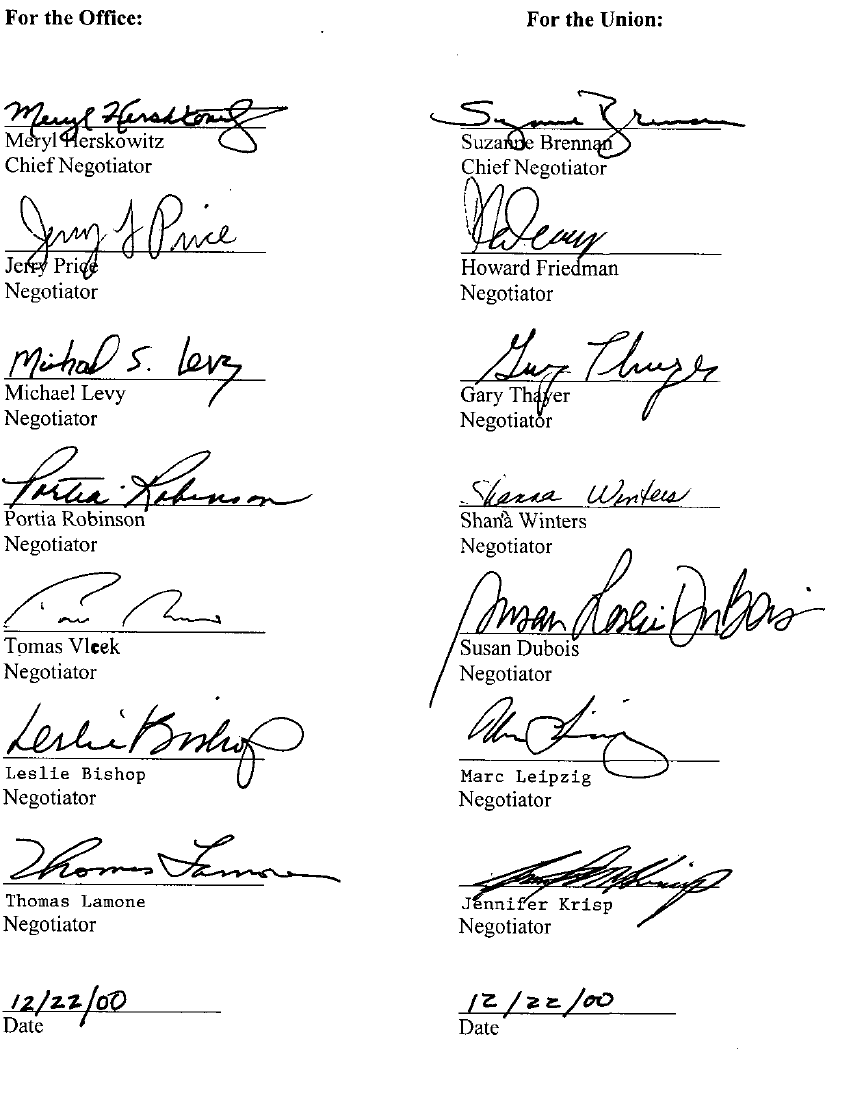
104

Contents
APPENDICES
Appendix A: MOU regarding the Agreement, agency head review, negotiability and appeals.
Appendix B:
Appendix B-1: List of provisions declared non-negotiable by Agency, if applicable.
Appendix B-2: MOU to revise provisions declared non-negotiable by Agency, if applicable.
Appendix B-3: Agency approval of MOU on revision of non-negotiable language, if applicable.
Appendix C:
GWPAS, attached for reference.
Appendix D:
Public Law 101-376(Civil Service Due Process Amendments) and legislative
history, attached for reference.
Appendix E:
Alternate Work Schedule Election Form.
Appendix F:
Awards scale, attached for reference.
Appendix G:
Appendix K of NTEU 243 Contract – Pilot Transit Subsidy.
Appendix H:
MOU regarding Pilot Transit Subsidy Program, Parking Fees, and Alternate Work
Schedules.
Appendix I:
MOU for transition
105

Appendices Contents
106

Appendices Contents
APPENDIX B
Article 35, Disciplinary Actions:
Section 2
The parties recognize the Agency’s discretion to determine an appropriate penalty in accordance with
Section 3 below. Unless inconsistent with established office policy, disciplinary actions shall generally
be progressive in nature and fairly relate to the offense.
Article 36, Adverse Actions:
Section 2
The parties recognize the Agency’s discretion to determine an appropriate penalty in accordance with
Section 3 below. Unless inconsistent with established office policy, adverse actions shall generally be
progressive in nature and fairly relate to the offense.
107

Appendices Contents
Appendix C
U.S. Department of Commerce
Performance Appraisal System
For the General Workforce
TABLE OF CONTENTS
Section
Page
Section 1. Legal Requirements and Authorities………………………………. 1
Section 2. Objectives………………………………………………………….. 1
Section 3. Coverage…………………………………………………………… 2
Section 4. Responsibilities……………………………………………………. 2
Section 5. Timetable for Performance Management
Activities…………………………………………………………. 6
Section 6. Performance Appraisal Process…………………………………… 7
Section 7. Relationship of Performance Appraisal
Of Other Personnel Actions……………………………………… 18
Section 8. Training and Information………………………………………….. 22
Section 9. Evaluation…………………………………………………………. 22
Section 10. Record Keeping…………………………………………………… 22
Section 11. Definitions………………………………………………………… 23
Appendix A
Appendix B
Appendix C
January 24, 1995
108

SECTION 1. LEGAL REQUIREMENTS AND AUTHORITIES
.01 This document implements the provisions of the following authorities:
a. The Civil Service Reform Act of 1978, P.L. 95-454, (5 U.S.C.
4301-4305); 5 CFR Part 430 Subpart B; and DAO 202-430.
b. Official Personnel Folder (5 U.S.C. 2951, 552, 4305, 4315,
1103, 1104, and 1302); 5 CFR, Part 293, Subpart C; and FPM
Chapter 293.
.02 The following citations are related to this plan:
a. Administrative Grievance System; 5 U.S.C. 1302, 3301, 3302,
And 7301; 5 CFR Part 771; and FPM Chapter 771.
b. Alcohol and Drug Abuse Regulations; 5 CFR Part 792 and FPM
Chapter 752.
c. Adverse Actions; 5 U.S.C. Chapter 75; 5 CFR Part 752; and FPM
Chapter 752.
d. Incentive Awards Programs; 5 U.S.C. Chapter 45; 5 CFR Part
451; and FPM Chapter 451
e. Pay Rates and Systems (General); Pay under the General
Schedule; 5 U.S.C. Chapter 53; 5 CFR Part 531; FPM Chapter 530;
FPM Chapter 531; 5 CFR Part 536; FPM Chapter 536; 5 CFR Part 550;
And FPM Chapter 550.
f. Grade Reductions or Removals Based on Unacceptable
Performance; 5 U.S.C. 4303 and 4305; and 5 CFR Part 432.
SECTION 2. OBJECTIVES
The Department’s General Workforce Performance Appraisal System
Serves as the basis for:
.01 Establishing critical elements and related performance
standards for each covered position which, to the maximum extent
feasible, permit the accurate evaluation of job performance on
the basis of objective criteria related to the position;
.02 Using performance plans to communicate Department goals and
objectives and to identify individual accountability for their
accomplishment;
.03 Using performance appraisal results as a basis for providing
information to employees on their performance and how it may be
improved; and for training, rewarding, reassigning, promoting,
reducing in grade, retaining, granting within-grade increases,
and removing employees; and
109

.04 Evaluating and improving individual and organizational
accomplishments.
SECTION 3. COVERAGE
.01 The policies contained in this document apply to all
Department of Commerce employees except the following:
a. Employees in the Senior Executive Service;
b. Presidential employees;
c. Administrative law judges appointed under 5 U.S.C. 3105;
d. Positions filled by noncareer executive assignments under 5
CFR Part 305;
e. Positions for which employment is not reasonable expected to
Exceed 120 calendar days in a consecutive 12-month period;
f. Employees outside the United States who are paid in
Accordance with local native prevailing wage rates;
g. Employees covered by the Foreign Service Act of 1980;
h. Individuals occupying positions not in the competitive
Service excluded from coverage by the Office of Personnel
Management (OPM) under the provisions of 5 U.S.C. 4301 (2)(G); and
i. Expert and consultants
.02 An employee who is serving on a detail continues to occupy
the position from which detailed.
.03 General workforce employees whose service is temporarily
interrupted by service in any Federally-sponsored program (e.g.,
Intergovernmental Personnel Act) which calls for the employee’s
Return to the same or like position continues to be covered by
The General Workforce Performance Appraisal System while on the
Federally-sponsored assignment.
.04 Schedule C employees, as authorized by 5 CFR Part 213.3301,
are covered by this system except that they are not afforded the
rights required by 5 U.S.C. 4302 (b)(6) and 4303.
SECTION 4. RESPONSIBILITIES
.01 Heads of Operating Units or Departmental Offices
may elect
to use three- or five-level rating scales in accordance with
Sections 6.03a.4 and 5.
110

.02 Appointing authorities must:
a. Ensure that their operating unit instructions on the General
Workforce Performance Appraisal System are consistent with
current laws, applicable Office of Personnel Management rules and
regulations, Departmental policies, and valid collective
bargaining agreements.
b. Provide managers and supervisors of covered employees with
adequate training, supplemented by periodic updates covering
their duties and responsibilities under the General Workforce
Performance Appraisal System.
c. Ensure that covered employees are informed of their rights
and responsibilities under the system;
d. Provide managers and supervisors with clear instructions on
procedures for identifying critical elements and related
performance standards within their respective organizations;
e. Communicate overall missions, objectives, goals, and long-
range plans and activities to all levels within the organization;
f. Assure the opportunity exists for employee participation in
the development of performance plans;
g. Maintain appropriate records and submit required data and
reports on the operation of the General Workforce Performance
appraisal System;
h. Ensure that performance appraisal results are used by
Managers and supervisors in making personnel decisions regarding
Training, rewarding, reassigning, promoting, reducing in grade,
Retaining, and removing employees;
i. Encourage the use of cash awards, honorary awards, and other
Official commendations, when appropriate, to reward and motivate
Covered employees;
j. Determine the effectiveness of the system by instituting a
Formal monitoring and evaluation program, and
k. Promptly initiative corrective actions in the performance
Appraisal program when such actions are warranted.
.03 Approving officials must:
a. Review critical (and non-critical) elements and standards in
Place in their organizations to ensure that they are integrated
Into the total management process and are consistent with overall
Organizational objectives;
111

b. Review, sign and date performance plans when developed to
ensure equity and consistency within their organizations;
c. Resolve conflicts between rating officials and employees
Over the content of performance plans;
d. Review performance appraisals and proposed ratings to ensure
That evaluation criteria are objective and job-related, and that
Actual accomplishments support the rating;
e. Respond in writing within 10 working days to employee written
Comments on ratings;
f. Assign, sign, and date final performance ratings (including
Documenting and reasons for changing ratings); and
g. Approve/recommend performance-related personnel actions,
Including awards, when warrented.
04. Rating officials (supervisors) or general workforce
Employees must:
a. Inform employees of th eoverall mission, objective, goals,
Long-range plans, and activities of the work unit and parent
Organization and inform employees of their related duties and
Responsibilities;
b. Encourage employee participation in developing performance
Plans;
c. Provide employees with written performance plans which
Identify the critical (and non-critical) elements and performance
Standards related to their specific duties, responsibilities, and
Expected levels or performance;
d. Collect data to determine if performance standards are being
Met;
e. Conduct and document at lease one formal progress review
Around the midpoint of the appraisal period and additional
Reviews as necessary;
f. Modify performance plans as necessary;
g. Participate in the pre-appraisal discussion, if one is
Requested by the employee;
h. Complete performance appraisals which includes determining,
Documenting, and evaluating employees actual accomplishments,
i. Confer with approving officials about their organization’s
112

performance and about the ratings they plan to assign their
employees, and get the approving official’s approval before
discussing those ratings with employees;
j. Determine preliminary ratings for employees, and discuss the
final appraisal with the employees;
k. Sign and date performance plans, performance appraisals, and
ratings; and
l. Recommend personnel actions (including awards) and/or
training based on the employee’s level of performance of work in
relation to the performance standards.
.05 General Workforce employees should:
a. Work with their supervisors in developing their performance
Plans;
b. Collect data to demonstrate that performance standards are
Being met;
c. Compare accomplishments with appropriate performance
Standards;
d. Participate in the mid-cycle progress review and request
Additional reviews, as necessary;
e. Participate in the performance appraisal process with the
Rating official (including scheduling a pre-appraisal meeting if
They wish);
f. Sign and date performance plans, performance appraisals an d
Ratings, to acknowledge receipt;
g. Prepare written comments when disputing a rating; and
h. Seek development opportunities to enhance performance.
.06 Human Resources Offices must:
a. Communicate the purpose and procedures of the General
Workforce Performance Appraisal system and its relationship to
The overall personnel management system to supervisors, general
Workforce employees, and appropriate exclusive bargaining
Representatives;
b. Provide instruction on how to identify critical (and
Non-critical) elements and establish performance standards;
c. Provide training and/or orientation on the operation of the
113

System for employees who are responsible for, or subject to, the
System;
d. Coordinate and submit required reports on the operation of
The system; and
e. Participate in the development and implementation of a
Monitoring and evaluation program of the system.
SECTION 5. TIMETABLE OF PERFORMANCE MANAGEMENT ACTIVITIES.
.01 Employees covered by this system are normally appraised
annually under one of the following fixed appraisal periods:
October 1 – September 30 or June 1 – May 31. Appendix C of this
Document specifies operating unit/Departmental Office appraisal
Periods.
.02 The minimum performance appraisal period is 120 days.
.03 Performance plans for all covered employees must be
established and approved at the beginning of the appraisal
period, normally within 30 days of the beginning of the period.
.04 When an employee enters a covered position or changes
positions after the start of the appraisal period, a performance plan must be
established and approved within 30 days of the
effective date of the appointment to the new position.
.05 When an employee is detailed or temporarily promoted to a
covered position within the Department and is expected to serve
in the position for 120 days or more, he or she must have an
approved performance plan within 30 days of the beginning of the
detail or temporary promotion.
.06 Interim summary performance ratings are required when an
employee changes positions after serving in a covered position
for at least 120 days, or when an employee serves on a detail or temporary
promotion within the Department of at least 120 days
during the appraisal period. The interim rating must be
completed within 30 days of the change of position or end of the
detail or temporary promotion.
.07 Appraisals and annual ratings of record must be completed
within 30 days of the end of the annual appraisal period, except
that (1) employees who are unratable at the end of the appraisal
period because they have not served in a covered position for at
least 120 days of the appraisal period, must be rated after they
have served for the minimum period (120 days); (2) Schedule A
employees of the Bureau of Census must receive their ratings
within 60 days of the end of the appraisal period; and (3)
employees who on the last day of the appraisal period have begun
114

But have not completed an opportunity period to improve
Performance to an acceptable level, as provided in 7.05c.3a, may
Have their ratings deferred until the completion of the
Opportunity period.
.08 Appointing authorities must complete the Department’s annual
performance plan completion report and forward it to the
Department by November 30 each year. Operating units with June 11
- May 31 appraisal periods must complete this report for
General workforce employees and forward it to the Department by
July 31 each year.
.09 Performance ratings of record for general workforce
employees are effective on the last day of the appraisal cycle
(September 30 and May 31) each year. For those employees who
enter into a covered position with less than 120 days remaining
in the appraisal period (see .07 above), the rating of record is
effective the first day of the first pay period after the
employee completes 120 days in the new position.
.10 When a rating official changes positions or leaves the
Department with less than 120 days remaining in the appraisal
Period, he/she must complete appraisals and ratings for his/her
Subordinate employees before the change of position or transfer
To another Department or agency. These ratings will serve as the
Employee’s rating of record for the appraisal period and the time
Remaining in the appraisal period will be included in the
Following appraisal period. Such ratings will be effective the
Date of the transfer of the supervisor.
SECTION 6. PERFORMANCE APPRAISAL PROCESS.
.01 Performance Planning
a. Approximately four weeks before the start of the appraisal
Period, rating officials (supervisors) and employees should
Begin developing written performance plans for the next appraisal
Period. The process should involve both the supervisor and
Employee. Performance plans must be recorded on Form CD-516,
“Classification and Performance Management Record.” Performance
plans must be completed and signed by the rating official,
approving official, and employee at the beginning of the
appraisal period, normally within 30 days. Performance plans
115
Must include:
1. Critical (and non-critical) elements which reflect the
Employee’s major duties and responsibilities and which are
Consistent with current job assignments and with the level
Of duties described in the employee’s position description.
(Although the Department discourages inclusion of non-critical
elements in performance plans, occasionally a rating official
may need to include some. If included, non-critical elements
should represent no more than 15 percent of the total plan;
additionally, no single non-critical element may be weighted more
than 10 percent nor weigh more than any critical element in the
plan.) Organizational objectives should, when appropriate, be
included in performance plans by incorporating objectives, goals,
program plans, work plans, or by other similar means that account
for program results. Elements may be drawn from the number of
sources including: mission and functional statements, position
descriptions, management-by-objectives (MBO’s) and other planning
documents, operating budget justifications, and affirmative
action plans. An employee’s responsibility for accomplishing
part or all of an MBO must be included as a critical element or
a major activity of al critical element. If the element relates
to a Secretarial level objective, it must be designated on the
CD-516 as critical and checked as an MBO. Elements must include
Only those aspects of the work over which the employee has
Control. An objective, specifying the overall result each
Element is expected to accomplish, along with the major
Activities the employee must undertake to accomplish each
Element, must be communicated in writing in the employee’s
Performance plan. For any job designated as supervisory, duties
Such as recommending or making personnel decisions, developing
And appraising subordinates, fulfilling equal opportunity and
Affirmative action responsibilities, and other supervisory duties
Must be addressed as a critical element (or as major activities
Of a critical element). Additionally, supervisors who fail
To meet performance appraisal deadlines as specified in
This document must have their own appraisals so documented.
Developing generic critical (and non-critical) elements is
Strongly encouraged.
2. Weights must be assigned to each element on the basis of
The amount of time required to accomplish the element and/or its
Importance. The total of the weights must be 100%. Assigning
Weights to the major activities listed under an element is not
Permitted. Non-critical elements may be included in performance
Plans, but must be assigned very low weights and represent
No more than 15 percent of the total plan. In no case may
A non-critical element be assigned a higher weight than any
Critical element included in the performance plan.
3. Performance standards must be used to evaluate levels of
116

Accomplishment for critical (and any non-critical) elements.
Standards should define performance in terms of results (what is
To be accomplished) and process (how it is to be accomplished).
(Note: The results may already be expressed under the major
activities listing. In such a case they do not need to be
repeated as standards since they are already specified for the
employee.) The generic performance standards (GPS) contained in
Appendices A and B, for use with five- or three-level rating
Scales, respectively, must be used to evaluate the performance of
All employees covered by this system. Supplemental standards, as
Needed,, should be developed for each critical ( and non-critical)
Element. Specific quantitative, timeliness, cost effectiveness,
And/or qualitative standards, if they apply to a particular
Critical element and if they will be used to evaluate an
Employee’s performance must be included as supplemental
Standards. (If these standards are specified in operational
Manuals or other documents made available to the employee, those
Documents may simply be referenced in the performance plan.)
Such standards need be written only at the Fully Successful level
And refer generically to different levels of quality, timeliness,
Quantity, and cost effectiveness.
b. If a rating official and covered employee disagree on
The contents of the performance plan, the rating official and
Employee should attempt to resolve the disagreement informally.
However, the approving official must make the final decision
Regarding the contents of the plan. The contents of performance
Plans may not be grieved.
c. When developing performance plans, the following factors
Should be considered:
1. Criticality/Relevance
. Have appropriate critical elements
Been identified? Are the elements derived from the overall
Mission of the work unit?
2. Comprehensiveness
. Does he plan cover all of the employee’s
Major duties and responsibilities?
3. Clarity
. Are critical elements and performance standards
Clearly and fully described?
4. Qualifications
. Can achievements be measured with the
Standards identified?
5. Consistency
. Are performance plans for similar positions
Comparable in all important aspects?
d. When an employee enters a covered position or moves from
One covered position to another after the start of the appraisal
117

Period, and when an employee serves on a detail of 120 days or
More, a performance plan must be established and approved for the
Employee, following the guidelines in .01a-c of this Section.
.02 Progress Reviews
a. At a minimum, rating officials must conduct a formal progress
Review with their employees at approximately the midpoint of the
Appraisal period. Covered employees may also request (or
Supervisors may schedule) additional progress reviews. The
Progress review must include discussion of :
1. The employee’s progress toward meeting the objectives of the
Elements included in his or her performance plan;
2. The identification of any performance deficiencies and
Recommendations on how to improve them by the rating official;
And
3. The need for changes in the plan based on changes in
responsibilities. A rating official must submit any recommended
changes in performance plans in writing to the approving official
and gain his/her approval of the changes. Those changes must
then be signed and dated by both officials and attached to the
plan. The employee must be given a copy of the changed plan.
b. There must be a record of the progress review. Both the
Supervisor and employee should date and initial the performance
plan to indicate the review took place.
c. Progress reviews should also be scheduled and conducted for
employees who enter covered positions after the start of the
appraisal period. There progress reviews should be completed
near the midpoint of the shortened appraisal period.
d. A progress review must also be initiated by the rating
official if an employee’s performance on one or more critical
elements falls below the Fully Successful level. In such a case
the rating official must discuss the instances of less than Fully
Successful performance and outline in writing what is required
by the employee to bring his or her performance up to the Fully
Successful level. If rating officials wish this review to serve
as the beginning of the formal opportunity period required by 5
U.S.C. 4302(b)(6), please see Section 7.05c.3.
.03 Appraisal
a. Every employee who occupies a covered position on the last
day of the appraisal cycle and who has been in a covered position
for at least 120 days during the appraisal cycle must receive an
Annual performance appraisal rating of record, in accordance with
118
The following:
1. Rating officials must confer with the approving official
about their organization’s performance and gain approval of
(including the approving official’s signature on Form CD 516)
the ratings they recommend for their employees before discussing
those ratings with employees.
2. The rating official initiates the appraisal by providing
advance notice of the employee of the date and time for the
formal appraisal meeting.
3. The employee may schedule a pre-appraisal meeting with the
rating official to:
a. Present his or her assessment of results achieved against the
Standards set in the performance plan;
b. Inform the rating official of aspects of his or her work of
which the rating official may not be aware; and
c. Identify objectives he or she would like to include in the
Performance plan for the next period.
during this pre-appraisal meeting, the rating official may ask
questions to clarify his or her understanding of the employee’s
Performance.
4. Once the advance notice of the formal appraisal meeting has
been given, and after any pre-appraisal meeting, the rating
Official (after conferring with the approving official) prepares
and discusses with the employee a written performance rating.
This rating must be based on an assessment of the employee’s
Performance against the standards set at the beginning of the
period (or as modified and documented during the progress review)
in the performance plan and must include a written rating for
each individual performance element based on one of the following
scales:
(a) Five-level element rating scale:
Outstanding (Level 5) = 5 points
Commendable (Level 4) = 4 points
Fully Successful (Level 3) = 3 points
Marginal (Level 2) = 2 points
Unacceptable (Level 1) = 1 point.
(b) Three-level element rating scale:
Outstanding (Level 5) = 5 points
Meets or Exceeds Expectations (Level 3) = 3 points
Does Not Meet Expectations (Level 1) = 1 point.
119

Note: The level “Meets or Exceeds Expectations” is equivalent to
the level “Fully Successful” as stated in 5 CFR, Part 430. The
level “Does Not Meet Expectations” is equivalent to the level
“Unacceptable” and subject to the same provisions regarding
demotion or removal as stated in 5 U.S.C. Chapter 43.
5. To obtain the overall summary rating, each element rating
must be multiplied by the weight assigned to that element (e.g.,
Element #1 is weighted at 30% and receives a rating of Fully
Successful or a 3; 3 x 30% = 90 points). No fractional scores or
weights may be used. The points assigned the individual elements
are then totaled to determine an overall summary rating based on
The following scales:
(a) Five-level summary rating scale (used only with a five-level
Element rating scale):
Outstanding (Level 5) 460 – 500 points
Commendable (Level 4) 380 – 459 points
Fully Successful (Level 3) 290 – 379 points
Marginal (Level 2) 200 – 289 points*
Unacceptable (Level 1) below 200 points*
(b) Three-level summary rating scale (used only with a three-
Level element rating scale):
Outstanding (Level 5) 420 – 500 points
Meets or Exceeds
Expectations (Level 3) 270 – 419 points
Does Not Meet
Expectations (Level 1) below 270 points*
*If a covered employee receives a less-than-Fully Successful
critical element rating in his/her position of record or in
an interim rating that becomes a final rating of record (see
Sections 6.03a.8. and 6.03b.), the employee’s performance
Rating must be no higher than the lowest critical element rating
Received no matter what point total the employee earns.
6. Summary ratings of Fully Successful in which all individual
elements are rated Fully Successful require only a summary
notation that the employee’s performance meets expectations and
that the rating was discussed with the employee. Individual
Element justifications must be done for elements rated below
Fully Successful. If any elements are rated above Fully
Successful, a written summary justification is required.
However, for employees required by the Secretary’s Diversity
Policy Tenets (July 21, 1994) to have a diversity critical
Element, a rating above Fully Successful on that element must be
justified separately, apart from any summary justification.
120

Also, a rating official may elect to write justifications for
individual element ratings. Furthermore, if the employee
requests written justification of any individual element rating,
the rating official must provide such justification.
7. Interim ratings for service in other covered positions within
the Department during the appraisal period must be considered
in determining the employee’s final rating of record. Interim
ratings are developed during the rating cycle to document the
Performance of an employee who changes positions or who is
detailed during the year provided the employee has served in
the position or on the detail for at least 120 days. Unless
the employee has changed positions with less than 120 days
remaining in the appraisal cycle, the final rating of record is
determined using the procedures in (a) through (d) below. If the
employee has changed positions with less than 120 days remaining
in the appraisal period, and has ser4ved in another covered
position for which an interim rating was done, use the procedures
in Section 6.03b. to determine the employee’s final rating of
record.
a. The rating official for the employee’s position of record
Appraises the employee on the work done in the position of record
if the employee has served in that position for at least 120 days
of the appraisal period. (If the employee has not served in the
position of record for 120 days, see Section 6.03a.9 or 6.03b as
appropriate.)
b. Double the score assigned for the position of record.
c. Add the doubled score to any other interim rating scores
received during the appraisal period.
d. Divide the total score from c. above by the number of
positions occupied for 120 days or more during the appraisal
cycle plus 1, e.g., if the employee occupied two positions for
120 days or more of the appraisal cycle, the total score in c.
would be divided by three. This number becomes the final rating
score. (Scores with decimals should be rounded to the next
highest number).
Example 1:
Interim rating score: 360 x 1 = 360
Position of record rating score: 480 x 2 = 960
1,320
1,320 ÷ 3 = 440
The recommended rating would be 440.
121

Example 2:
Interim rating score: 390 x 1 = 390
Interim rating score: 375 x 1 = 375
Position of record rating score: 450 x 2 = 900
1,665
1,665 ÷ 4 = 417
The recommended rating would be 417.
In computing a final performance rating using this formula, the
rating assigned by the supervisor of the position or record (the
one that is to be doubled) must be checked carefully to make sure
that a non-critical element is not given more weight (because
of the doubling) than any critical element in the other interim
ratings. (OPM regulations prohibit giving more weight to
Non-critical elements than to critical elements in deriving final
Ratings.) If, because of the doubling, the non-critical element
score exceeds that of any of the critical element scores, the
point score of the non-critical element must be reduced to its
original total (before the doubling) and the summary point total
adjusted appropriately.
e. If an employee receives a rating of Fully Successful or
higher in his/her current position or record, then his/her final
summary performance rating cannot be less than Fully Successful
even if he/she received a less-than-Fully Successful interim
rating for work performed on other assignments during the cycle.
8. If an employee has served in a covered position for more
than the minimum appraisal period in another Federal agency,
that agency is required to provide an interim summary rating of
performance and forward it to the Department’s employing office
with the Employee’s Official Personnel Folder. If the employee
transfers to the Department of Commerce with less than 120 days
remaining in the appraisal period, the employee’s interim rating
(prepared when he/she transferred) will become his/her rating of
record for the appraisal period. The time remaining in the
appraisal period will be included in the next appraisal period.
Thus, in such cases, the effective date of the transfer to the
department will serve as the beginning date of the employee’s new
Appraisal period. If no interim rating can be obtained from the
employee’s old agency, the employee’s current rating of record
will be extended. If the employee transfers before the last 120
days of the appraisal cycle, the rating official must consider
the interim rating when determining the employee’s rating of
record at the end of the appraisal cycle.
If an employee has served on a detail to another Federal agency
122
for 120 days or more during the appraisal cycle, or an assignment
in a Federally-sponsored program such as an IPA or Executive
Exchange, the personnel office must make a reasonable effort to
obtain an interim summary rating from the other agency on the
employees performance on the detail or assignment. If the
interim rating is obtained, it must be considered in deriving the
employee’s rating of record at the end of the appraisal cycle.
If the employee has served for the entire rating cycle on detail
to another agency and an appraisal of performance cannot be
obtained despite reasonable efforts, the employee’s current
rating of record must be extended. If the employee has no
current rating of record, he or she must be considered unratable
and treated as though Fully Successful.
9. The employee should sign the rating to indicate that it has
been discussed. (If the employee refuses to sign, the rating
official should so not). A copy must be given to the employee.
If the employee disagrees with the rating, he or she may comment
in writing to the approving official within five working days of
receipt of the appraisal and rating. The approving official must
respond in writing to these comments within 10 working days. If
the approving official changes a rating at this point, he/she
must document the reasons for the change on Form CD-516A and
provide a copy to the employee. (This documentation may also
serve as his/her response to the employee’s comments.)
10. An employee may request a reconsideration of his/her rating
by an official in a position higher than the approving official.
Such reconsideration requests must be processed under the
appropriate negotiated grievance procedure, if applicable.
Otherwise they must be processed under the Department’s
Administrative grievance procedure.
11. Annual performance ratings of record must be approved by the
operating unit official who manages the performance awards budget
for the organization.
12. The summary rating given at the end of the annual appraisal
period, or at the end of the extended appraisal period, in cases
where the employee has not served in a covered position for at
least 120 days of the appraisal period becomes the employee’s
rating of record. (See Section 6.03c)
b. If a covered employee has not served in his/her position of
record for 120 days of the appraisal period, but has served in
one other covered position (either a permanent position or on
detail) for which an interim rating was prepared that interim
rating will become the employee’s rating of record for the
appraisal cycle. If the employee has two interim ratings for the
appraisal period, add the two interim scores together and divide
by two to obtain the average score. Translate the average score
123

- 16 -
into the appropriate adjective rating. The time remaining in the appraisal period
will be included in the new appraisal period. Thus when an employee changes
positions in the last 119 days of
the appraisal period, the effective date of the change of
position also serves as the beginning date of the employee's new appraisal period.
c. Employees who are serving in covered positions on the last
day of the appraisal period, but who are unratable because they
have not served for at least 120 days during the appraisal period
in a covered position must be given an annual rating of record in
accordance with the provisions of paragraph .03a. above as soon
as they have served for the minimum period. An employee may be
unratable because of entry into a covered position within the
last 119 days of the appraisal period; time in a non-pay status;
long-term training; service on a Federally-sponsored program such
as an Intergovernmental Personnel Act or President's Executive
Exchange assignment for which appraisal information is not
available; the employee's supervisor leaving the agency where
no other higher level supervisor can reasonably appraise the
employee's performance; service on detail to another Federal
agency for which performance appraisal information is not
available; or approved absence creditable under 5 CFR 531.406.
d. The current ratings of record of employees who are unratable
on the last day of the appraisal period are extended if they
are not then working in a covered position which can provide
the basis for appraisal (e.g., they are continuing on long-term
training) and are not expected to return to such a position
within 120 days. If these employees have no ratings of record,
they are treated as though Fully Successful.
e. Interim Summary Ratings
.
1. When an employee who has served in a covered position for 120
days or more in the appraisal period changes to another covered
position within the Department, an interim rating must be
completed by the employee's former supervisor and signed by the
appropriate approving official. Interim ratings must also be
completed when an employee completes a detail or temporary
promotion within the Department of 120 days or more in a covered
position. In such cases the rating must be based on the elements
and standards established for the position the employee is
leaving. Copies of the interim rating must be given to the
employee, the gaining supervisor, and the servicing human
resources office of the gaining organization.
2. When an employee transfers from Commerce to another Federal
agency after serving in a covered position in Commerce for 120
days or more, the employee's supervisor and approving
official must complete and interim rating. The interim rating
- 17 -
124
must be transferred with the employee's OPF to the gaining agency
or department for consideration in the employee's next rating of
record.
3. Interim ratings are not ratings of record for reduction in
force or other purposes, except where indicated in this document.
f. The following summary performance ratings and no other
ratings constitute ratings of record:
1. The annual performance appraisal rating provided for in .03a.
of this Section;
2. An improved rating given following an opportunity to
demonstrate acceptable performance as provided in 5 CFR
351.504(e)(1);
3. A rating given in connection with a within-grade increase
determination as to acceptable level of competence that is
inconsistent with the employee's current rating of record or when
for in paragraph 7.02 of this document;
of a within-grade increase determination as provided by 5 CFR
531.409(c); and
5. A rating given after the minimum appraisal period when an
h. As provided in Executive Order 5396, the performance
i. The Department does not prescribe a distribution of ratings
Department assures that only employees whose performance exceeds
- 18 -
the employee does not have a rating of record as recent as the
completion of the latest performance appraisal cycle, as provide
4. A rating based on an appraisal period following the delay
employee is unratable at the end of the appraisal cycle, as
provided for in .03c. of this Section.
No other summary rating given to an employee of the Department
constitutes a rating of record.
g. When an employee is rated below the Fully Successful level,
the rating official must attempt to help the employee to improve
his/her performance. Assistance may include, but is not limited
to formal training, on-the-job training, counseling, and closer
supervision.
appraisal and resulting rating of a disabled veteran may not be
lowered because the veteran has been absent from work to seek
medical treatment.
and does not permit a distribution to be prescribed. The
normal expectations are rated at levels above Fully Successful by
the approving officials' review, by sampling of plans and ratings
125

by the servicing human resources office, by Departmental PME
reviews, and by other reviews as required by regulation.
SECTION 7. RELATIONSHIP OF PERFORMANCE APPRAISAL TO OTHER
PERSONNEL ACTIONS
.
promoting, reducing in grade, retaining and removing employees,
Performance appraisal results must be used as a basis for
making personnel decisions on training, rewarding, reassigning,
and granting within-grade increases.
.01 Awards
.
a. Performance awards, when granted, must be based on an
employee's performance rating of record for the appraisal period
for which the award is granted.
b. A quality step increase (QSI) may be granted only to an
employee who receives an Outstanding summary performance rating.
As provided by 5 U.S.C. 5336, a QSI may not be granted to an
employee who has received one within the preceding 52 calendar
weeks. QSI's should be made effective as soon as possible after
the annual performance appraisal is finally approved.
c. The Performance Awards component of the Department's
Performance Management Plan describes the procedures for
making award determinations and for funding awards, and the uses
of performance awards.
d. DAO 202-451, "Incentive Awards," and related Personnel
Bulletins provide detailed policy guidance for all types of
awards.
.02 Within-grade Increases
.
a. Federal Wage System
. An employee who is otherwise eligible
b. General Schedule
receives a within-grade increase if his or her performance is
satisfactory or above, as provided in 5 U.S.C. 5343; i.e., the
employee's most recent rating of record is Fully Successful or
above.
. An employee who is otherwise eligible
is at an acceptable level of competence. This means that an
the employee has continued to perform his or her responsibilities
receives a within-grade increase when hi or her performance
employee's most recent performance rating is at least Fully
Successful and that during the period of time since that rating
in a manner warranting an increase in basic pay. When an
acceptable level of competence determination is not consistent
with the employee's last performance rating of record or when
an employee does not have a rating of record as recent as
- 19 -
126

the completion of the latest performance appraisal cycle (as
specified under 5 CFR 531.404), an additional and more
current performance rating must be prepared, which becomes the
rating of record for purposes of granting or dying the within-
grade increase only.
.03 Promotion Actions
.
a. Competitive Promotions
. Selecting officials must give due
weight to the performance appraisals of job applicants in making
selection decisions under the Merit Assignment Program.
b. Career Ladder Promotions
. To receive a career ladder
promotion, an employee's most recent performance rating of record
must be Fully Successful or higher.
.04 Probationary Periods
.
a. Initial Appointments
. Supervisors of probationary employees
serving initial appointments must determine if the probationers'
performance, conduct, and general traits of character warrant
retention in their positions beyond the probationary period.
Supervisors must evaluate probationers' performance with
reference to the critical elements and standards of their
positions.
b. Initial Appointments to Supervisory Positions
. Performance
requirements for probationary supervisors should be set according
to DAO 202-430, "Performance Appraisal," and documented on Form
CD-516, "Classification and Performance Management Record." An
evaluation of Fully Successful or higher on all critical elements
of the performance plan is required for retention in the
supervisory position beyond the probationary period. (See also
DAO 202-412, "Supervisory and Management Development.")
.05 Actions Based on Unacceptable Performance
.
a. An employee whose performance is unacceptable must be
reassigned, removed, or changed to a lower grade.
b. An action based on unacceptable performance may be taken at
any time, either during or at the end of the appraisal cycle,
provided the requirements of paragraph 7.05.c. are met.
DAO 202-432, "Reduction in Grade and Removal Based on
c. Except for the exclusions stated in Section 2 of
Unacceptable Performance," before an employee may be removed
or demoted for unacceptable performance under the provisions of
Title 5, Chapter 43, the employee is entitled to:
1. Be informed in writing of the critical element(s) on which
- 20 -
127
his or her performance is deficient;
2. Be assisted to improve his or her performance to an
should be preceded by some informal, oral feedback to the
of these warnings and meet (at least in part) their obligation
to assist the employee to improve, by including the following in
their notices:
acceptable level; and
3. Be given the opportunity to demonstrate acceptable
performance; as follows:
a. An employee whose performance is unacceptable must be
notified in writing that his or her performance is unacceptable,
and that the opportunity to improve is being given. The written
notice must also inform the employee of the critical elements on
which performance is unacceptable and the performance standards
required for retention. (This may be done simply by reference to
the performance standards in the performance appraisal plan; or
by defining a more specific set of tasks to be completed during
the opportunity period, with specific standards of timeliness,
quantity, or quality, etc. Such standards must be consistent
with, i.e., not more stringent than the more generic standards
stated in the plan.) This formal notice recorded in writing
employee about his or her unacceptable performance. However, an
oral warning preceding the written one is not required by this
Plan.
b. When the employee is notified in writing of his or her
unacceptable performance, the clock starts on the reasonable time
granted to demonstrate acceptable performance, unless a later
date is specified in writing. Neither the law nor regulation
specifies what that period of time must be. It depends on
the nature of the job, the level of the position, and the
consequences of unacceptable performance. In any case, the
period of time allowed must be commensurate with the requirements
of the position. The notice need not specify an exact period
(for example, 60 days). However, it is a good practice to
specify a minimum period to display improvement; e.g., not less
than 30 days.
c. Although OPM regulations require only that the job element(s)
on which performance has been unacceptable and the performance
standards for retention in the job be identified at the outset
of the opportunity to improve, managers may increase the efficacy
(1) Specific examples, arranged by performance element, of past
incidents (within the last year) of unacceptable performance;
(2) Where relevant, a description of the negative consequences
of the performance deficiencies;
- 21 -
128

(3) A suggestion of steps the employee may take which would be
expected to lead to improve performance, e.g., better work
organization, time management, more thorough proofreading, more
follow-up;
(4) A statement of the steps the agency intends to take (or
to offer) to assist the employee to improve, e.g., to sponsor
training, offer counseling or personal assistance, or monitor
work more closely; and
(5) An explicit statement of the possible consequence of failure
level in the organization than the one who prepared the action.
.06 Performance at the Marginal Level (Level 2)
to improve within a reasonable period of time, i.e., removal,
demotion, or reassignment.
d. Reduction in Grade or Removal Based on Unacceptable
Performance. If an employee's performance is unacceptable during
the opportunity period, the employee must be reassigned, reduced
in grade, or removed. Except for the exclusions stated in
Section 2 of DAO 202-432 an employee who is being reduced in
grade or removed under the provisions of Title 5, Chapter 43
is entitled to the following before being removed or reduced
in grade: (1) a 30-day advance written notice of the proposed
action identifying specific instances of unacceptable performance
and the critical elements on which performance is unacceptable;
(2) at least seven calendar days to respond to the notice orally
and/or in writing and to furnish affidavits in support of the
reply; (3) to be represented; and (4) to receive a written
decision specifying the reasons for the action taken. The
decision must have the concurrence of an official at a higher
.
a. Continued performance at the Marginal level by an employee
jeopardizes the attainment of organizational goals and must be
corrected.
b. An employee whose performance is Marginal must be notified in
writing that his/her performance is deficient. The employee and
his/her supervisor must develop a written plan within 30 days
detailing the actions each will take to attempt to bring the
employee's performance to the Fully Successful (or above) level.
The plan must include bimonthly (one every two months) progress
reviews that are fully documented as to the employee's progress.
The plan must be continued until the employee's performance
improves to Fully Successful (and is documented as such in a
formal progress review) or he/she is rated Unacceptable.
c. An employee whose performance is Marginal may be reassigned.
- 22 -
.07 Reduction in Force
.
129

a. For RIF purposes, ratings considered ratings of record are:
(1) the rating given at the end of the appraisal period (normally
on an annual basis); (2) the rating given at the end of an
extended appraisal period (extended because the employee did not
serve 120 days in his/her current position); (3) the improved
rating following an opportunity to demonstrate acceptable
performance as provided in 5 U.S.C. 4302(b)(6).
b. An employee must not be assigned a new rating of record for
the sole purpose of affecting his/her RIF retention standing.
SECTION 8. TRAINING AND INFORMATION
.
communicating the purposes and procedures of the General
.01 Servicing human resources offices are responsible for
Workforce Performance Appraisal System by establishing
appropriate training and orientation programs. These
programs must emphasize performance plan development,
supervisory/management responsibility for carrying out the
program, and the linkage between performance ratings and employee
recognition and other personnel decisions.
.02 Information on changes in the operation of the General
Workforce Performance Appraisal System is conveyed to Department
management and affected employees through Office of Human
Resources Management issuances and newsletters.
SECTION 9. EVALUATION OF THE SYSTEM
.
.01 The Office of Human Resources Management assesses the
effectiveness of the General Workforce Performance Appraisal
System in the Department of Commerce through its ongoing
Personnel Management Evaluation Program. Commerce organizations
are evaluated on their technical compliance with laws, Office of
Personnel Management regulations, and Department policy.
Evaluations focus on the adequacy of performance plans and
rating as well as on each organization's performance rating
distribution as related to its accomplishments as reflected in
the Department's Management by Objectives Program.
.02 Operating units and Departmental Offices are encouraged
to establish internal evaluation systems to assess how well the
General Workforce Performance Appraisal System is working in
their organizations.
SECTION 10. RECORD KEEPING
.
.01 Performance appraisal records and related documents will be
maintained in accordance with the provisions of this document,
- 23 -
130

the Privacy Act, Freedom of Information Act, other legislative
and regulatory requirements, and negotiated agreements.
.02 Performance ratings of record and the performance plans on
which those ratings were based must be retained for four years.
.03 Performance records that are superseded, e.g., through an
administrative or judicial procedure, must be destroyed.
.04 Except were prohibited by law, automated records may be
retained longer than four years for purposes of statistical
analysis as long as the data are not used in any action affecting
the employee when the manual record has been or should have been destroyed.
.05 When an employee transfers from on operating unit into
another also within the Department, or to another Federal agency,
the following performance records must be transferred with the
employee's OPF: (1) performance ratings of record that are four
years old or less; (2) the plan on which the most recent rating
of record is bases; and (3) the interim rating prepared when the
employee changes positions.
.06 Disclosure of performance-related information must be made
only as permitted by the Privacy act.
SECTION 11. DEFINITIONS
.
Acceptable Performance
is performance that meets an employee's
performance standards at the level of performance above Level 1
(Unacceptable or equivalent), i.e., Level 2 in the critical
element at issue on a five-level rating scale, Level 3 on a
three-level scale.
Agency
is the Department of Commerce.
Appointing Authority
is a Secretarial Officer or the head of a
primary operating unit or an official so designated by the
Secretary of Commerce.
Appraisal
is the act of process of evaluating the performance of
an employee against the prescribed performance standard(s).
Appraisal Period
means the period of time established by the
Department's General Workforce Performance Appraisal System for
which an employee's performance will be reviewed.
Approving Official
is normally the supervisor who assigns,
controls, and is responsible for the work of the rating official,
usually the rating official's immediate supervisor. However,
operating units or Departmental offices may designate a higher
- 24 -
131

level official in the management chain as the approving official
Critical Element
provided this designation does not conflict with any other
provision of this document. The approving official is
responsible for assigning the final performance rating.
is a component of an employee's position
consisting of one or more duties and responsibilities, which
contributes toward accomplishing organizational goals and
objectives and which is of such importance that unacceptable
performance on the element would result in unacceptable
performance in the position
Fully Successful
is Level 3 of an element rating scale and
reflects good, sound performance, i.e., the expected level of
performance.
Generic Performance Elements
are performance elements which apply
to a group of employees in an organization.
Generic Performance Standards
(GPS) are performance standards
which define work behaviors or activities which, if engaged in by
employees, lead to a certain level of quality in products or
services. The GPS are written so that they may apply universally
to large groups of employees.
Interim rating
is a summary rating developed during a rating
cycle to document the performance of an employee who is changing
positions (if the employee served in the position for 120 days or
more) or completing a detail or temporary promotion of 120 days
or more. The interim rating, except where stipulated in this
document, is not a rating of record but is factored into the
final summary assigned the employee at the end of the rating
cycle. The interim rating is completed on Form CD-516,
"Classification and Performance Management Record," by the losing
supervisor, signed by the losing approving official, and
forwarded to the gaining supervisor. A copy is also given to the employee. Form
CD-516C, "Final Performance Rating Using Interim
Ratings," should be used to assign the final summary rating when
interim ratings must be considered.
Major Activity
is a task, duty, or project which needs to be
accomplished in support of a critical element.
Non-critical Element
is a component of an employee's job which
does not meet the definition of a critical element, but is
Opportunity to Demonstrate Acceptable Performance
sufficiently important to warrant written appraisal.
is a reasonable
performance at the level above Level 1.
chance for the employee whose performance has been determined to
be at Level 1 in one or more critical elements to demonstrate
- 25 -
132

Performance
is an employee's accomplishment of assigned work as
specified in the critical and non-critical elements of the
employee's position.
Performance Award
is a performance-based cash payment to an
employee based on the employee's rating of record. A performance
award does not increase base pay.
Performance Management
is the systematic process by which the
Department integrates performance, pay, and awards systems with
its basic management functions for the purpose of improving
individual and organizational effectiveness in accomplishment of
Department mission and goals.
Performance Plans
are documents that define the critical (and
non-critical) elements against which a covered employee's
performance will be appraised and establish performance standards
for those elements.
Performance Standards
are statements of the expectations or
Pre-appraisal Meeting
requirements established by management for a critical (or non-
critical) element at a particular rating level. A performance
standard may include, but is not limited to, factors such as
quality, quantity, timeliness, and manner of performance.
is a meeting with the rating official
scheduled at the option of the employee prior to the formal
can: (1) present an assessment of his or her own performance
objectives he or she would like to include in the next cycle's
performance plan.
Progress Review
appraisal meeting. At the pre-appraisal meeting the employee
during the appraisal period; (2) cover aspects of his or her work
of which the rating official may not be aware; and (3) identify
is a formal meeting between the rating official
and employee at which the employee's progress toward meeting the
objectives in his or her performance plan is discussed. The need
for any changes to the plan may also be discussed at this meeting
as well as any performance deficiencies the supervisor has noted
along with recommendations for improving them.
Rating
(also referred to as "summary rating") is the written
record of the appraisal of each critical and non-critical element
and the assignment of a summary rating level.
Rating Official
is the person responsible for informing the
covered employee of the critical elements of his/her position,
establishing performance standards for those elements, appraising
performance and assigning the recommended performance rating.
Normally, this is the employee's immediate supervisor.
- 26 -
133

Rating of Record
is the summary rating, under 5 U.S.C. 4302,
specified for special circumstances.
Unacceptable
required at the time specified in the Department's General
Workforce Performance Appraisal System or at other times
is Level 1 of the rating scale. It reflects
unacceptable performance in accordance with 5 U.S.C. 4301(3).
134
FORM CD-516B LF US DEPARTMENT OF COMMERCE
(REV 1-94)
APPENDIX A
DAO 202-430 GENERIC PERFORMANCE STANDARDS
in the performance plan (Summary ratings are the employee's work is of such significance that get the job done well inmore than one way while
terms for the rater to assign a particular rating the employee's usfulness. ment are consistently above average. Work pro-
specific examples of accomplishments which adapts quickly to new priorities and changes in problem-solving skill and insight into work methods
Occasionally, when rating some elements, a In meeting element objectives, the employee established deadlines. He or she uses ontingency
within a critical element and at the marginal level The employee seeks additional work or special with co-workers, clients, as appropriate, and his ot-
the rating form citing specific accomplishments with routinely and with exceptional skill. Problems which surface aredealth with supervisory
the rating official. Such standards are included in prevent misunderstandings. Complicated or contro- fectiveness leading to improved understanding of
such standards within the context of the GPS and comes are achieved. sympathet consideration because they are well-
with others and handles difficult situations with The employee is a good leader. Establishes
The employee has performed so well that organ- ages independence and risk-taking among subordi- ment in dealing with subordinates considering
often ahead of established schedules and with The employee has shown a comprehensive under- duties while also handling any difficult special as-
complex ideas clearly in a wide range of difficult The effective planning of the employee has duels.
INSTRUCTIONS GENERAL WORK FORCE erating procedures, task assignments, or program
The generic performance standards (GPS) are This is a level of rare, high-quality performance. activities. The employee has developed or im-
the primary basis for assigning element ratings in The quality of quantity of the employee's work plemented workable and cost-effective approaches
the Department of Commerce. The GPS are to be substantially exceed fully successful standards and to meeting organizational goals.
applied to each critical (and non-critical) element rarely leaves room for improvement. The impact of The employee has demonstrated an ability to
assigned by using a point scale after each element organizational objectives were accomplished that handling difficult and unpredicted problems. The
has been rated). otherwise would not have been. The accuracy and employee produces a high quantity of work often
When evaluating an element the rater should thoroughness of the employee's work on this ahead of established schedules with less than nor-
1 Read carefully each performance standard level element are exceptionally reliable. Application of mal supervision.
beginning with the fully successful one (it is technical knowledge and skills goes beyond that The employee writes and speaks clearly on dif-
considered the base level standard) expected for the position. The employee signif- ficult subjects to a wide range of audiences.
2 Determine which level best describes the cantly improves the work processes and products
employee's performance on the element (Each for which he or she is responsible. Thoughful ad-
GENERAL WORK FORCE
and every criterion in the standards does not herence to procedures and formats as well as sug- This is a level of unusually good performance.
have to be met by the employee in absolute gestions for improvement in these areas increase The quantity and quality of work under this ele-
level. The sum of the employee's performance This person plans so that work follows the most ducts rarely require even minor revision. Thor-
of the element must in the rater's judgement, logical and practical sequence. Inefficient back- oughness and accuracy of work are reliable. The
meet the assigned level's criteria) tracking is avoided. He or she develops contin- knowledge and skill the employee applies to this
3 Provide in writing, on the appraisal form, gency plans to handle potential problems and element are clearly above average demonstrating
support the assigned rating level. procedures and programs without losing sight of and techniques. The employee follows required
Element ratings of fully successful do not the longer-term purposes of the work. These procedures and supervisory guidance so as to take
require full written documentation unless the strengths in planning and adaptability result in full advantage of existing systems for accomp-
employee requests it. To assign a fully successful early or timely completion of work under all but the lishing the organization's objectives.
element rating, the rating official need only most extraordinary circumstances. Exceptions The employee plans the work under this ele-
documents in writing that (1) the fully successful occur only when delays could not have been ment so as to proceed in an efficient, orderly
standards were met, and (2) that the rating was anticipated. The employee's planning skills result in sequence that rarely requires backtracking and
discussed in detail with the employee cost-savings to the government. consequently leads to completion of the work by
rating official may determine that an employee's handles interpersonal relationships with exceptional planning to anticipate and prevent problems and
performance on an element was not consistent. sill, anticipating and avoiding potential causes of delays. Exceptions occur when delays have auses
For example, the employee may have performed at conflict and actively promoting cooperation with outside the employee's work planning.
the commendable level on several major activities clients, co-workers and he or her supervisor. The employee works effectively on this element
on several others. In such a case, the rating official assignments related to this element at increasing her supervisory, creating a highly successful coop-
must consider the overall effect of the employee's levels of difficulty. The quality of such work is high erative effort. He or she seeks out additional work
work on the element and make a judgement as to and is done on time without disrupting regular or special assignments that enhance accomp-
the appropriate rating level she/she will assign. The work. Appropriate problems are brought to the lishment of this element and pursues them to suc-
rationale for the decision must be documented on supervisor's attention. Most problems are dealt cessful conclusion without discrupting regular work
which support the decision. The employee's oral and written expression are intervention to correct problems occurs rarel
y.
Any additional standards that are included in exceptionally clear and effective. They improve The oral and written expression applied to this
the performance plan must also be considered by cooperation among participants in the work and element are noteworthy for their clarity and ef-
performance plans to supplement the GPS, no versial subjects are presented or explained effec- the work by other employees and clients of the
supplant them. Rating officials should consider tively to a variety of audiences so that desired out- organization. Work products are generally given
ic
rate elements accordingly. presented.
SUPERVISORY*
OUTSTANDING The employee is a strong leader who works well SUPERVISORY*
SES
This is a level of rare high quality performance. dignity and effectiveness. The employee encour- sound working relationships and shows goodjudge-
zational goals have been achieved that would not nates, yet takes responsibility for their actions. their views. He/she provides opportunties for staff
have been otherwise. The employee's mastery of Open to the views of others. The employee to have a meaningful role in accomplishing organ-
technical skills and thorough understanding of the promotes cooperation among peers and subor- izational objectives and makes special efforts to
mission have been fundamental to the completion dinates while guiding, motivating, and stimulating improve each subordinate's performance.
of program objectives. positive responses. The employee's work perfor-
The employee has exerted a major positive in- mance demonstrates a strong commitment to fair
FULLY SUCCESSFUL
fluence on management practices, operating pro- treament, equal opportunity, and the affirmative
SES
cedures and program implementation which has action objectives of the organization. This is the level of good, sound performance.
contributed substantially to organizational growth The employee has contributed positively to organi-
and recognition. Preparing for the unexpected, the
COMMENDABLE zational goals. All critical element activities that
employee has planned and used alternative ways of
SES could be completed are. The employee effectively
reaching goals. Difficult assignments have been This is a level of unusually good performance. applies technical skills and organization knowledge
managed intelligently and effectively. The employee It has exceeded expectations in critical areas and to get the job done.
has produced an exceptional quantity of work, shows sustained support of organizational goals. The employee successfully carries out regular
little supervision. standing of the objectives of the job and the pro- signments. The employee plans and performswork
If writing or speaking, the employee presents cedures for meeting them. according to organizational priorities and sche-
communications situations. Desired results are at- improved the quality of management practices op-
tained.
The employee also works well as a team mem- personnel. When needed as input into another productivity or morale, or organizational effective-
ber, supporting the group's efforts and showing an work process the work may not be finished with ness. The marginal employee does not provide
ability to handle a variety of interpersonal situa- such quality. Quantity and timeliness that other strong leadership or take the appropriate initiative
135
tions. work can proceed as planned. to improve organizational effectiveness. For exam-
This is the level of good, sound performance. quantity does not represent what is expected of
lines. Priorities are duly considered in planning and -Failure to respond to client needs; and/or
so their form and content are acceptable and reg- There is much in the employee's performance often require major revision because they are in-
vision. acceptable work. These deficiencies cannot be products, or it produces technically inadequate
The employee speaks and writes clearly and overlooked since they create adverse conse- products or results. Lack of adherence to required
other personnel. When needed as input into to inadequate work products.
their skills effectively. diate serious consequences, over time, they are ation with clients, supervisor, and/or co-workers or
SES generally is finished within expected timeliness direction and therefore, cannot operate adequately
level which may result in removal from the position. achievement of the purposes of the communication Most of the following deficiencies are typically,
es for the organization or create burdens for other extended period of time affect adversely employee
The employee communicates clearly and effect- Although the work products are generally of ple he/she too often fails to make decisions or ful-
ively. useable quality , too often they require additional fill supervisory responsibilities in a timely manner
All employees at this level and above have fol- work by other personnel. The work products do not to provide sufficient direction to subordinates on
lowed a management system by which work is consistently and/or fully meet the organization's how to carry out program, to give clear assign-
planned, tasks are assigned, and deadlines are needs. Although mistakes may be without im- ments, and/or performance requirements, and/or to
met. mediate serious consequences, over time they are show an understanding of the goal's of the organi-
detrimental to the organization. zation or subordinates' roles in meeting those
GENERAL WORK FORCE A fair amount of work is accomplished, but the goals.
The quality and quantity of the employee's work Fully Successful employees. Output is not sus-
UNSATISFACTORY
under this element are those of a fully competent tained consistently and/or higher levels of output
SES
employee. The performance represents a level of usually result in a decrease in quality. The work This is the level of unacceptable performance.
accomplishment expected of the great majority of generally is finished within expected timeframes Work products do not meet the minimum require-
employees. The employee's work products fully but significant deadlines too often are not met. ments of the critical element.
meet the requirements of this element. Major revi- The employee's written and oral communi- Most of the following deficiencies are typically,
sions are rarely necessary, most work requires only cations usually consider the nature and complexity but not always characteristic of the employee's
minor revision. Tasks are completed in an accurate, of the subject and the intended audience. They work:
thorough, and timely way. The employee's tech- convey the central points of information important -Little or no contribution to organizational
ical skills and knowledge are applied effectively to to accomplishing the work. However, too often the goals;
specific job tasks in completing work assignments. communications are not focused, contain too much -Failure to meet work objectives;
He or she adheres to procedures and format re- or too little information, and/or are conveyed in a -Inattention to organizational priorities and ad-
quirements and follows necessary instructions from tone that hinders achievement of the purpose of the ministrative requirements;
supervisors. communications. The listener or reader must que- -Poor work habits resulting in missed dead-
The employee's work planning is realistic and stion the employee at times to secure complete lines, incomplete work products;
results in comp of work by established dead- information or avoid misunderstandings. -Strained work relationships;
performing assigned responsibilities. Work reflects
GENERAL WORK FORCE -Lack of response to supervisor's corrective ef-
a consideration of costs to the government, when This level of performance, while demonstrating forts.
possible. some positive contributions to the organization,
In accomplishing element objectives, the em- shows notable deficiencies. It is below the level
GENERAL WORK FORCE
ployee's interpersonal behavior toward supervisors, expected for the position, and requires corrective The quantity and quality of the employee's
co-workers, and user's promotes attainment of work action. The quality, quantity, or timeliness of the work under this element are not adequate for the
objectives and poses no significant problems. employee's work is less than Fully Successful, position. The employee's work products fall short of
The employee completes special assignments jeopardizing attainment of the element's objective. requirements of the element. They arrive late or
ular duties are not disrupted. The employee per- that is useful. However, problems with quality, complete or inaccurate in content. The employee
forms additional work as his/hr workload permits. quantity, or timeliness are too frequent or too fails to apply adequate technical knowledge to
Routine problems associated with completing as- serious to ignore. Performance is inconsistent and complete the work of this element. Either the
signments are resolved with a minimum of super- problems caused by deficiencies counterbalance knowledge applied cannot produce the needed
effectively. quences for the organization or create burdens for procedures, instructions, and formats contributes
SUPERVISORY* another work process, the work may not be Because the employee's work planning lacks lo-
The employee is a capable leader who works finished with such quality, quantity, and timeliness gic or realism, critical work remains incomplete or
successfully with others and listens to suggestions. that other work can proceed as planned. is unacceptably late. Lack of attention to priorities
The employee rewards good performance and Although the work products are generally of causes delays or inadequacies in essential work,
corrects poor performance through sound use of useable quality, too often they require additional the employee has concentrated on incidental mat-
performance appraisal systems, performance-based work by other personnel. The work products do not ters.
incentives, and when needed, adverse actions and consistently and/or fully meet the organization's The employee's behavior obstructs the suc-
slects and assigns employees in ways that use needs. Although mistakes may be without imme- cessful completion of the work by lack of cooper-
The employee's work performance shows a detrimental to the organization. by loss of credibility due to irresponsible speech or
commitment to fair treatment, equal opportunity, A fair amount of work is accomplished but the work activity.
and the affirmative action objectives of the organ- quantity does not represent what is expected of In dealing with special projects, the employee
ization. Fully Successful. Employee's Output is not sus- either sacrifices essential regular work or fails to
tained consistently, and/or higher levels of output complete the projects. The employee fails to adapt
MARGINAL usually result in a decrease of quality. The work to changes in priorities, procedures, or program
This level of performance, while demonstrating but significant deadlines too often are not met. in relation to changing requirements.
some positive contributions to the organization, The employee's written communication usually The oral and written expression the employee
shows notable deficiencies. It is below the level considers the nature and complexity of the subject uses in accomplishing the work of this element
expected for the position and requires corrective and the intended audience. It conveys the central lacks the necessary clarity for successful comple-
action. The quality, quantity, or timeliness of the points of information important to accomplishing tion of required tasks. Communication failures in-
employee's work is less than Fully Successful, the work. However, too often the communication is terfere with completion of work.
jeopardizing attainment of the element's objective. not focused, contains too much or too little infor-
The employee's work under this element is at a mation, and/or is conveyed in a tone that hinders
SUPERVISORY*
There is much in the employee's performance In communication to co-workers, the listener must but not always common characteristics of the em-
that is useful. However, problems with quality, question the employee at times to secure complete ployee's work:
quantity, or timeliness are too frequent or too information or avoid misunderstandings. -Inadequate guidance to subordinates;
serious to ignore. Performance is inconsistent and -Inattention to work progress; and
problems caused by deficiencies counterbalance
SUPERVISORY* -Failure to stimulate subordinates to meet
acceptable work. These deficiencies cannot be Inadequacies surface in performing supervisory goals.
overlooked since they create adverse consequenc- duties. Deficiencies in areas of supervision over an
* Supervisory standards must be applied to
SES and General Work Force supervisors.
136

APPENDIX C
Operating Unit Appraisal Cycles
Following are the Appraisal cycles of Department of Commerce
operating units.
October 1 - September 30:
All operating units except Office of Inspector General.
June 1 - May 31:
Office of Inspector General.
November 1 - October 31:
NOAA Wage Marine Employees.
137

Appendices Contents
APPENDIX D
2 PAGE
1st DOCUMENT of Level 1 printed in FULL format.
UNITED STATES CODE SERVICE
ADVANCE LEGISLATIVE SERVICE
(c) 1990 THE LAWYERS CO-OPERATIVE PUBLISHING COMPANY
Public Law 101-376
101st Congress
[H.R. 3086]
States of America in Congress assembled.
SECTION 1. SHORT TITLE.
"(1) 'employee' means --
101 P.L. 376; 1990 H.R. 3086; 104 Stat. 461
SYNOPSIS:
An Act
To amend title 5, United States Code, to grant appeal rights to members of the
excepted service affected by adverse personnel action, and for other purposes.
AUG. 17, 1990 -- PUBLIC LAW 101-376
TEXT:
Be it enacted by the Senate and House of Representatives of the United
[*1]
This Act may be cited as the "Civil Service Due Process Amendments".
[*2]
SEC.2. EXCEPTED SERVICE APPEAL RIGHTS.
(a) IN GENERAL. -- Section 7511 of title 5, United States Code, is amended to read
as follows:
"@ 7511. Definitions; application
"(a) For the purpose of this subchapter --
"(A) an individual in the competitive service --
"(i) who is not serving a probationary or trail period under an initial
appointment; or
"(ii) who has completed 1 year of current continuous service under other than a
temporary appointment limited to 1 year or less;
"(B) a preference eligible in the excepted service who has completed 1 year of
current continuous service in the same or similar positions --
"(i) in an Executive agency; or
"(ii) in the United States Postal Service or Postal Rate Commission; and
"(C) an individual in the excepted service (other than a preference eligible) --
"(i) who is not servicing a probationary or trail period under an initial
appointment pending conversion to the competitive service; or
"(ii) who has completed 2 years of current continuous service in the same or
similar positions in an Executive agency under other than a temporary
3 PAGE
101 P.L. 376, *2; 1990 H.R. 3086;
104 Stat. 461
138
"(2) 'suspension' has the same meaning as set forth in section 7501(2) of this
title;
"(b) This subhcapter does not apply to an employee --
appointment limited to 2 years or less;
"(3) 'grade' means a level of classification under a position classification
system;
"(4) 'pay' means the rate of basic pay fixed by law or administrative action for
the position held by an employee; and
"(5) ' furlough' means the placing of an employee in a temporary status without
duties and pay because of lack of work or funds or other nondisciplinary reasons.
"(1) whose appointment is made by and with the advice and consent of the Senates
"(2) whose position has been determined to be of a confidential, policy-
determining, policy-making or policy-advocating character by --
"(A) the President for a position that the President has excepted from the
competitive service;
"(B) the Office of Personnel Management for a position that the Office has
excepted from the competitive service; or
"(C) the President or the head o fan agency for a position excepted from the
competitive service by statute;
"(3) whose appointment is made by the President;
"(4) who is receiving an annuity from the Civil Service Retirement and
Disability Fund, or the Foreign Service Retirement and Disability Fund, based on
the service of such employee;
"(5) who is described in section 8337(h)(1), relating to technicians in the
National Guard;
"(6) who is a member if the Foreign Service, as described in section 103 of the
Foreign Service Action of 1980;
"(7) whose position is with the Central Intelligence Agency, the General
Accounting Office, or the Veterans Health Services and Research Administration;
"(8) whose position is within the United States Postal Service, the Postal rate
Commission, the Panama Canal Commission, The Tennessee Valley Authority, the
Federal Bureau of Investigation, the National Security Agency, the, Defense
Intelligence Agency, or an intelligence activity of a military department covered
under section 1590 of title 10, unless subsection (a)(1)(B) of this section or
section 1005(a) of title 39 is the basis for this subchapter's applicability; or
"(9) who is described in section 5102(c)(11) of this title.
"(c) The Office may provide for the application of this subchapter to any position
or group of positions excepted from the competitive service by regulation of the
Office which is not otherwise covered by this subchapter.".
(b) ACTIONS BASED ON UNACCEPTABLE PERFORMANCE. --Section 4303(e) of title 5, United
States Code, is amended to read as follows:
"(e) Any employee who is --
"(1) a preference eligible;
"(2) in the competitive service; or
"(3) in the excepted service and covered by subchapter II of chapter 75,
and who has been reduced in grade or removed under this section is entitled to
4 PAGE
101 P.L. 376, *2; 1990 H.R. 3086;
104 Stat. 461
appeal the action to the Merit Systems Protection Board under section 7701.".
139
(c) APPLICABILITY. -- The amendments made by this section shall apply with respect
to any personnel action taking effect on or after the effective date of this Act.
[*3]
SEC. 3. ANNUITANT STATUS NOT A BAR TO APPEALING ONE'S REMOVAL.
Section 7701 of title 5, United States Code, is amended --
(1) by redesignating subsection (j) as subsection (k); and
(2) by inserting after subsection (i) the following:
"(j) In determining the appealability under this section of any case involving
a
removal from the service (other than the removal of a reemployed annuitant),
neither an individual's status under any retirement system established by or under
Federal statute nor any election made by such individual under any such system may
be taken into account.".
[*4]
SEC. 4. EFFECTIVE DATE.
This Act and the amendments made by this Act shall become effective on the date of
the enactment of this Act, and, except as provided in section 2(c), shall apply
with respect to any appeal or other proceeding brought on or after such date.
Speaker of the House of Representatives.
Vice President of the United States and President of the Senate.
140
8 PAGE
21
ST
ITEM of Level 1 printed in FULL format.
Congressional Record – House
not spoken by a Member of the House on the floor.
SEC. 2. EXCEPTED SERVICE APPEAL RIGHTS.
Monday, November 6, 1989
101
st
Cong. 1
st
Sess.
135 Cong Rec H 8001
REFERENCE: Vol. 135 No. 154
TITLE: CIVIL SERVICE DUE PROCESS AMENDMENTS
SPEAKER: MR. GILMAN; Mrs. MORELLA; MRS. SCHROEDER; Mr. SIKORSKI
TEXT:
Text that appears in UPPER CASE identified statements or insertions which are
[*H8001] Mr. SIKORSKI. Mr. Speaker, I move to suspend the rule and pass
the bill ( H.R. 3086) to amend title 5, United States Code, to grant appeal rights
to members of the excepted service affected by adverse personnel actions, and for
other purposes, as amended.
The Clerk read as follows:
H.R. 3086
BE IT ENACTED BY THE SENATE AND HOUSE OF REPRESENTATIVES OF THE UNITED STATES OF
AMERICA IN CONGRESS ASSEMBLED,
SECTION 1. SHORT TITLE.
This Act may be cited as the “Civil Service Due Process Amendments”.
(a)In General. – Section 7511 of title 5, United States Code, is amended to read
as follows:
@ 7511. Definitions; application
"(a) For the purpose of this subchapter –
"(1) ‘employee’ means –
"(A) An individual in the competitive service –
"(i) who is not serving a probationary or trail period under an initial
appointment; or
"(ii) who has completed 1 year of current continuous service under other than a
temporary appointment limited to 1 year or less;
141
"(B) a preference eligible in the excepted service who has completed 1 year of
current continuous service in the same or similar positions --
9 PAGE
135 Cong Rec H 8001, *H8001
"(i) in an Executive agency; or
"(ii) in the United States Postal Service or the Postal Rate Commission; and
"(C) an individual in the expected service (other than a preference eligible)
who has completed 1 year of current continuous service in the same or similar
positions in an Executive agency under other than a temporary appointment limited
to 1 year or less;
"(2) 'suspension' has the same meaning as set forth in section 7501(2) of this
title;
"(3) 'grade' means a level of classification under a position classification
system;
"(4) 'pay' means the rate of basic pay fixed by law or administrative action for
the position held by an employee; and
"(4) who is receiving an annuity from the Civil Service Retirement and
Disability Fund, or the Foreign Service Retirement and Disability Fund, based on
the service of such employee;
"(5) 'furlough' means the placing of an employee in a temporary status without
duties and pay because of lack of work or funds or other nondisciplinary reasons.
"(b) This subchapter does not apply to an employee --
"(1) whose appointment is made by and with the advice and consent of the Senate;
"(2) whose position has been determined to be of a confidential, policy-
determining, policy-making or policy-advocating character by --
"(A) the President for a position that the President has excepted from the
competitive service;
"(B) the Office of Personnel Management for a position that the Office has
excepted from the competitive service; or
"(C) the President or the head of an agency for a position excepted from the
competitive service by statute;
[*H8002] "(3) whose appointment is made by the President;
"(5) who is described in section 8337(h)(1), relating to technicians in the
National Guard;
"(6) who is a member of the Foreign Service, as described in section 103 of the
Foreign Service Act of 1980;
"(7) whose position is within the Central Intelligence Agency, the General
Accounting Office, or the Veterans Health Services and Research Administration;
PAGE 10
135 Cong Rec H 8001, *H8002
142
"(8) whose position is within the United States Postal Service, the Postal Rate
Commission, the Tennessee Valley Authority, the Federal Bureau of Investigation, or
the National Security Agency, unless subsection (a)(1)(B) of this section or
section 1005(a) of title 39 is the basis for this subchapter's applicability; or
"(9) who is described in section 5102(c)(11) of this title.
"(c) The Office may provide for the application of this subchapter to any
position or group of positions excepted from the competitive service by regulation
of the Office which is not otherwise covered by this subchapter.".
Section 1204(e)(1) of title 5, United States Code, is amended by adding at the
end of the following:
135 Cong Rec H 8001, *H8002
(b) Actions Based on Unacceptable Performance. -- Section 4303(e) of title 5,
United States Code, is amended by striking "who is a preference eligible or is in
the competitive service and".
(c) Applicability. -- The amendments made by this section shall apply with
respect to any personnel action taking effect on or after the effective date of
this Act.
SEC. 3. ANNUITANT STATUS NOT A BAR TO APPEALING ONE'S REMOVAL.
Section 7701 of title 5, United States Code, is amended --
(1) by redesignating subsection (j) as subsection (k); and
(2) by inserting after subsection (i) the following:
"(j) In determiningg the appealability under this section of any case involving
a removal from the service (other than the removal of a reemployed annuitant),
neither an individual's status under any retirement system established by or under
Federal statute nor any election made by such individual under any such system may
be taken into account.".
SEC. 4. LOCATION OF MSPB HEARINGS.
"(c) Whenever it considers alternative places for conducting a hearing or other
proceeding brought by or on behalf of an employee, former employee, or applicant
for employment, the Board shall, to the extent practicable, select the place
closest to the location of the position held, formerly held, or sought by the
individual involved, unless the total administrative costs to the Government in
conducting such proceeding would be lesser elsewhere.".
SEC. 5. EFFECTIVE DATE.
This Act and the amendments made by this Act shall become effective on the date
of enactment of this Act, and, except as provided in section2(c), shall apply with
respect to any appeal or other proceeding brought on or after such date.
The SPEAKER pro tempore. Is a second demanded?
PAGE 11
Mrs. MORELLA. Mr. Speaker, I demand a second.
143
The SPEAKER pro tempore. Without objection, a second will be considered as
service employees who have completed 1 year of service in an executive agency, but
specifically excludes the following groups; First, Presidential appointees; second,
certain reemployed annuitants; third, National Guard technicians; fourth, members
ordered.
There was no objection.
The SPEAKER pro tempore. The gentleman from Minnesota (Mr. Sikorski) will be
recognized for 20 minutes, and the gentlewoman from Maryland (Mrs. Morella) will be
recognized for 20 minutes.
The Chair recognizes the gentleman from Minnesota (Mr. Sikorski).
GENERAL LEAVE
Mr. SIKORSKI. Mr. Speaker, I ask unanimous consent that all Members may have 5
legislative days to revise and extend their remarks on H.R. 3086, the bill
presently under consideration.
The SPEAKER pro tempore. Is there objection to the request of the gentleman from
Minnesota?
There was no objection.
Mr. SIKORSKI. Mr. Speaker, I yield myself such time as I may continue.
Mr. Speaker, H.R. 3086 extends administrative due process rights to certain
Federal employees in the excepted service. Who are these so-called excepted
service employees? Most Federal employees are "competitive service" hired only
after examination and ranking by the Office of Personnel Management. Others,
however, are "excepted" from the competitive service either because there is no
practical way to test peoople entering these positions or because certain
occupations already require a minimum proficiency as a prerequisite to licensing.
Examples of excepted service employees include attorneys, teachers, chaplains,
scientists, and other specialists. There are between a quarter and a half million
of the excepted service civil servants working for us.
The fact that an employee is not in the competitive services does not mean that
the employee did not go through extensive competition. Any attorney who has tried
to get a job at the Department of Justice will tell you hiring is extremely
competitive. And it certainly shouldn't mean that public employees should be fired
at whim and without recourse.
Nor can employees in excepted service positions be fired without notice. The
requirements of constitutional due process and numerous agency grievance procedures
usually require that excepted service employees be given notice and the opportunity
to defend themselves before removal.
The key difference between the protections available to competitive service
employees and veterans preference employees, on the one hand, and non-veterans,
excepted service employees, on the other, is the right to appeal an adverse action
to the Merit Systems Protection Board for independent review. H.R. 2086 eliminates
that difference.
PAGE 12
135 Cong Rec H 8001, *H8002
As amended, H.R. 3086 extends procedural protections to most excepted
144
of the Foreign Service; fifth, employees of the Central Intelligence Agency, The
General Accounting Office, and the Veterans Health Services and Research
Administration; sixth, employees, other than preference eligible, of the U.S.
Postal Service, the Postal Rate Commission; and seventh, the Tennessee Valley
Authority, the Federal Bureau of Investigations, and the National Security Agency.
What rights are we talking about? Specifically, the procedural protections
provided by this legislation are spelled out in chapters 43 and 75 of title 5,
United States Code. They are no big deal -- unless you're on of the employees
affected. In cases involving removal, suspension for more than 14 days, reductions
in grade or pay, or furlough for 30 days or less, the employee must be given 30
days advance written notice of the proposed action, an opportunity to respond in
writing, a written decision containing specific reasons for the adverse action or
the specific instances of unacceptable performance, and an appeal to the Merit
Systems Protection Board -- basic rights.
Why are we proposing this? Besides being the right and proper thing to do, last
year's Supreme Court decision in United States versus Fausto makes this legislation
all the more urgent. In that decision, the Supreme Court cutoff an alternative
method of judicial review for excepted service employees, saying that Congress, In
passing the Civil Service Reform Act of 1978, had intended to deprive excepted
service employees, other than those who were veterans preference eligible, of the
rights to challenge adverse actions. This bill explicitly provides those rights.
This bill simply provides that over a quarter million hard working Americans
working for the Federal Government as loyal employees will be assured basic due
process rights. They work right next to other civil servants, sometimes with the
same title, same pay, same grade, on the same project, in the same office but
without the same rights of notice and appeal if their boss comes down on them.
That's not fair and that's why similar measures passed the House under suspension
of the rules during both the 99th and 100th Congresses and I urge my colleagues to
once again support this measure.
I would also like to commend Representatives Schroeder, Dymally, Horton, and
Morella for their hard work on this legislation and a host of legislation affecting
the civil servants who work for the taxpayers of America.
[*H8003] U.S. Congress,
Congressional Budget Office,
Washington, DC., November 6, 1989.
Hon. William D. Ford,
Chairman, Committee on Post Office and Civil Service, U.S. House of
Representatives, Washington, D.C.
Dear Mr. Chairman: The Congressional Budget Office has reviewed H.R. 3086,
the Civil Service Due Process Amendments, as ordered reported by the House
Committee on Post Office and Civil Service, October 25, 1989. We estimate that
PAGE 13
135 Cong Rec H 8001, *H8003
implementation of this bill would cost about $2 million annually, beginning in
1991, assuming appropriation of the necessary sums.
According to information for the Office of Personnel Management, the bill would
increase by about 200,000 to 300,000 the number of Executive Branch employees
eligible to appeal adverse actions to the Merit Systems Protection Board (MSPB).
Under current law, most veterans' preference eligibles and employees in the
competitive service can appeals adverse actions to the MSPB, which handles an
145
average of 4,500 initial appeals and petitions for review annually. Assuming the
same proportion of excepted service employees would appeals to the MSPB as
competitive service employees, enactment of this bill would require the MSPB to
make an additional 500 to 900 decisions per year. The increased workload would
result in addition costs of about $1 million in 1991, the first full year of
implementation, gradually rising to about $1.1 million in 1994.
Extending appeal rights also would result in federal agencies having to ward
back pay to excepted service personnel who are successful in their appeals. Based
on experience with the appeals of Postal Service employees, we estimate that back
pay for employees affected by this bill is likely to be about $1 million per year.
Other costs associated with defending agencies' actions during MSPB appeals are not
expected to be significant.
No costs would be incurred by state or local governments as a result of
enactment of this bill.
If you wish further details on this estimate, we will be pleased to provide
them. The CBO staff contact is James Hearn, who can be reached at 226-2860.
Sincerely,
Robert D. Reischauer,
Director
Mr. Speaker, I reserve the balance of my time.
Mrs. MORELLA. Mr. Speaker, I yield myself such time as I may consume.
Mr. Speaker, I rise in support of H.R. 3086, a bill to amend title 5 of the
United States Code, to grant appeal rights to members of the excepted service
affected by adverse personnel actions, and for other purposes.
This is a bipartisan bill sponsored by members of the Post Office and Civil
Service Committee and passed unanimously by the committee. I want to thank the
sponsor of the bill and chairman of the Subcommittee on Civil Service, the
gentleman from Minnesota [Mr. Sikorski] for his active role in the swift passage of
the bill which will affect about 500,000 professional employees of the Federal
government.
Mr. Speaker, presently, those who are in the excepted service, that is, those
who are not in the competitive service -- such as attorneys, doctors, scientists,
teachers, chaplains -- are not given the right to appeal adverse personnel actions.
This bill would not be applicable to those enumerated in section 2 of the bill,
such as political appointees, foreign service, and intelligence agency personnel.
Appeal rights are given to those Federal employees in the competitive service. It
is my firm belief that every employee
PAGE 14
135 Cong Rec H 8001, *H8003
in the Federal Government should have the same protection.
Mr. Speaker, we are at a period when the Federal Government is finding it
difficult to attract promising, top-flight employees because the private sector is
able to compensate these men and woman at a much higher salary level. The very
minimum we should be able to offer attorneys, doctors, scientists, chaplains, and
others in the excepted service is a certain amount of fairness in appeal rights.
Due process is one of our inalienable rights. Attorneys throughout our country
plead due process even for the most heinous of criminals but our own attorneys in
Federal Government cannot avail themselves of this right when it involves adverse
action or assessment of their jobs.
146
I am pleased to have been one of the original cosponsors of this measure and I
recommend unanimous passage of H.R. 3086.
MR. GILMAN. MR. SPEAKER, I RISE IN SUPPORT OF H.R. 3086 AND I COMMEND THE
CHAIRMAN OF THE CIVIL SERVICE SUBCOMMITTEE, MR. SIKORSKI AND THE RANKING MINORITY
MEMBER MRS. MORELLA FOR CRAFTING THIS IMPORTANT LEGISLATION. I ALSO WANT TO THANK
THE CHAIRMAN OF THE FULL COMMITTEE, MR. FORD, FOR HELPING TO BRING THIS BILL TO THE
FLOOR.
WE PASSED THIS SAME MEASURE IN THE 99TH AND 100TH CONGRESS. EVERY YEAR WE GO
THROUGH THIS AND EVER YEAR IT MAKES AS MUCH SENSE AS IT DID THE YEAR BEFORE THE
EXTEND COVERAE TO EXCEPTED SERVICE EMPLOYEES. THIS RIGHT EXISTS FOR FEDERAL
EMPLOYEES IN THE COMPETITIVE SERVICE AND THERE IS NO REASON WHY EXCEPTED SERVICE
EMPLOYEES SHOULD BE EXCLUDED.
H.R. 3086 GRANTS APPEAL RIGHTS BASED ON ADVERSE ACTIONS AS WELL AS APPEAL AND
PROCEDURAL RIGHTS FOR EXCEPTED SERVICE EMPLOYEES BEFORE THE MERIT SYSTEMS
PROTECTION BOARD (MSPB) FOR ACTIONS BASED ON UNACCEPTABLE PERFORMANCE.
CURRENTLY, ONLY MEMBERS OF THE COMPETITIVE SERVICE AND PREFERENCE ELIGIBLE
EMPLOYEES IN THE EXCEPTED SERVICE HAVE APPEAL RIGHTS. HOWEVER, SUCH GROUPS AS
DOCTORS, TEACHERS, ATTORNEYS, CHAPLAINS, SCIENTISTS AND OTHERS DO NOT. H.R. 3086
CORRECTS THIS MISTAKE.
ACCORDINGLY, I URGE MY COLLEAGUES TO SUPPORT H.R. 3086.
MRS. SCHROEDER. MR. SPEADER, I WANT TO CONGRATULATE THE GENTLEMAN FROM MINNESOTA
(M. SIKORSKI) FOR HIS HARD WORK ON H.R. 3086, THE CIVIL SERVICE DUE PROCESS
AMENDMENTS. IN THE LAST 10 MONTHS NOT ONLY HAS HE GUIDED THIS BILL THROUGH
CONGRESS, BUT HE ALSO ENGINEERED THE PASSAGE OF THE WHISTLEBLOWER PROTECTION ACT,
THE HATCH ACT, AND MANY OTHER BILLS. SINCE BECOMING CHAIRMAN OF THE CIVIL SERVICE
SUBCOMMITTEE, HE HAS PRESIDED OVER MORE HEARINGS THAN JUDGE WAPNER.
I ALSO WANT TO COMMEND THE GENTLEMAN FROM CALIFORNIA [MR. DYMALLY]. HE IS THE
TRUE LEADER IN THE FIGHT TO GIVE EXCEPTED SERVICE EMPLOYEES THE RIGHT TO APPEAL
ADVERSE ACTIONS. WE ARE PASSING THIS BILL TODAY BECAUSE OF HIS COMMITMENT TO
FAIRNESS AND DUE PROCESS.
H.R. 3086 EXTENDS ADMINISTRATIVE NOTICE AND APPEAL RIGHTS TO EXCEPTED
SERVICE EMPLOYEES. EXCEPTED SERVICE EMPLOYEES WORK BESIDE COMPETITIVE SERVICE
EMPLOYEES BUT ARE DENIED DUE PROCESS RIGHTS BECAUSE THEY ARE HIRED THROUGH A
DIFFERENT PROCESS.
H.R. 3086 GIVES EXCEPTED SERVICE EMPLOYEES -- ATTORNEYS, TEACHERS, SCIENTISTS,
AND CHAPLAINS -- THE RIGHT TO APPEAL TO THE MERIT SYSTEMS PROTECTION BOARD (MSPB)
ADVERSE ACTIONS AND ADVERSE PERFORMANCE BASED APPRAISALS. THIS RIGHT IS ENJOYED BY
MEMBERS OF THE COMPETITIVE SERVICE AND PREFERENCE ELIGIBLE EMPLOYEES.
PAGE 15
135 Cong Rec H 8001, *H8003
EXCEPTED SERVICE EMPLOYEES WORK ALONG-SIDE COMPETITIVE SERVICE EMPLOYEES,
CONTRIBUTE TO THE SAME RETIREMENT SYSTEM, AND FACE THEY SAME INSECURITY WHEN THERE
IS A REDUCTION IN FORCE. BUT THEY HAVE NO RECOURSE OR DUE PROCESS RIGHTS WHEN
CHARGED WITH MISCONDUCT. IT IS TIME WE PROVIDE THEM WITH THIS NECESSARY PROTECTION.
I URGE MY COLLEAGUES TO SUPPORT H.R. 3086, THE CIVIL SERVICE DUE PROCESS AMENDMENTS
ACT OF 1989.
Mrs. MORELLA. Mr. Speaker, I yield back the balance of my time.
147
Mr. SIKORSKI. Mr. Speaker, I have no further requests for time, and I yield back
the balance of my time.
The SPEAKER pro tempore (Mr. Jontz). The question is on the motion offered by
the gentleman from Minnesota (Mr. Sikorski) that the House suspend the rules and
pass the bill, H.R. 3086, as amended.
The question was taken, and (two-thirds having voted in favor therof) the rules
were suspended, and the bill, as amended, was passed.
A motion to reconsider was laid on the table.
148
The PRESIDING OFFICER. The bill will be stated by title.
The assistant legislative clerk read as follows:
(a)In General. – Section 7511 of title 5, United States Code, is amended to read
as follows:
"(A) An individual in the competitive service –
2 PAGE
14TH ITEM of Level 1 printed in FULL format.
Congressional Record – Senate
Monday, July 10, 1990;
(Legislative day of Tuesday, July 10, 1990
101st Cong. 2nd Sess.
136 Cong Rec S 11134
REFERENCE: Vol. 136 No. 100
TITLE: CIVIL SERVICE DUE PROCESS AMENDMENTS
SPEAKER: Mr. BOREN; Mr. DOLE; MR. PRYOR
TEXT:
[*S11134] Mr. BOREN. Mr. President, I ask unanimous consent that the Senate
proceed to the immediate consideration of Calendar Order 547, H.R. 3086, the civil
service due process reform bill.
A bill (H.R. 3086) to amend title 5, United States Code, to grant appeal rights
to members of the excepted service affected by adverse personnel actions, and for
other purposes.
The PRESIDING OFFICER. Is there objection to the immediate consideration of the
bill?
There being no objection, the Senate proceeded to consider the bill which had
been reported from the Committee on Governmental Affairs with an amendment to
strike all after the enacting [*S11135] clause, and insert I lieu thereof the
following:
SECTION 1. SHORT TITLE.
This Act may be cited as the "Civil Service Due Process Amendments".
SEC. 2. EXCEPTED ERVICE APPEAL RIGHTS.
@ 7511. Definitions; application
"(a) For the purpose of this subchapter –
"(1) ‘employee’ means –
149
3 PAGE
"(B) a preference eligible in the excepted service who has completed 1 year of
current continuous service in the same or similar positions --
"(3) whose appointment is made by the President;
136 Cong Rec S 11134, *S11135
"(i) who is not serving a probationary or trail period under an initial
appointment; or
"(ii) who has completed 2 year of current continuous service under other than a
temporary appointment limited to 1 year or less;
"(i) in an Executive agency; or
"(ii) in the United States Postal Service or the Postal Rate Commission; and
"(C) an individual in the expected service (other than a preference eligible) --
"(i) who is not serving a probationary or trial period under an initial
appointment pending conversion to the competitive service; or
"(ii) who has completed 2 years of current continuous service in the same or
similar positions in an Executive agency under other than a temporary appointment
limited to 2 years or less;
"(2) 'suspension' has the same meaning as set forth in section 7501(2) of this
title;
"(3) 'grade' means a level of classification under a position classification
system;
"(4) 'pay' means the rate of basic pay fixed by law or administrative action for
the position held by an employee; and
"(5) 'furlough' means the placing of an employee in a temporary status without
duties and pay because of lack of work or funds or other nondisciplinary reasons.
"(b) This subchapter does not apply to an employee --
"(1) whose appointment is made by and with the advice and consent of the Senate;
"(2) whose position has been determined to be of a confidential, policy-
determining, policy-making or policy-advocating character by --
"(A) the President for a position that the President has excepted from the
competitive service;
"(B) the Office of Personnel Management for a position that the Office has
excepted from the competitive service; or
"(C) the President or the head of an agency for a position excepted from the
competitive service by statute;
150
4 PAGE
136 Cong Rec S 11134, *S11135
"(4) who is receiving an annuity from the Civil Service Retirement and
Disability Fund, or the Foreign Service Retirement and Disability Fund, based on
the service of such employee;
"(5) who is described in section 8337(h)(1), relating to technicians in the
National Guard;
"(6) who is a member of the Foreign Service, as described in section 103 of the
Foreign Service Act of 1980;
"(7) whose position is within the Central Intelligence Agency, the General
Accounting Office, or the Veterans Health Services and Research Administration;
"(8) whose position is within the United States Postal Service, the Postal Rate
Commission, the Tennessee Valley Authority, the Federal Bureau of Investigation, or
the National Security Agency, unless subsection (a)(1)(B) of this section or
section 1005(a) of title 39 is the basis for this subchapter's applicability; or
"(9) who is described in section 5102(c)(11) of this title.
"(c) The Office may provide for the application of this subchapter to any
position or group of positions excepted from the competitive service by regulation
of the Office which is not otherwise covered by this subchapter.".
(b) Actions Based on Unacceptable Performance. -- Section 4303(e) of title 5,
United States Code, is amended by striking "who is a preference eligible or is in
the competitive service and".
(c) Applicability. -- The amendments made by this section shall apply with
respect to any personnel action taking effect on or after the effective date of
this Act.
SEC. 3. ANNUITANT STATUS NOT A BAR TO APPEALING ONE'S REMOVAL.
Section 7701 of title 5, United States Code, is amended --
(1) by redesignating subsection (j) as subsection (k); and
(2) by inserting after subsection (i) the following:
"(j) In determiningg the appealability under this section of any case involving
a removal from the service (other than the removal of a reemployed annuitant),
neither an individual's status under any retirement system established by or under
Federal statute nor any election made by such individual under any such system may
be taken into account.".
SEC. 4. EFFECTIVE DATE.
This Act and the amendments made by this Act shall become effective on the date
of enactment of this Act, and, except as provided in section2(c),
shall apply with respect to any appeal or other proceeding brought on or after
151
5 PAGE
136 Cong Rec S 11134, *S11135
such date.
AMENDMENT NO. 2436
(Purpose: To specify employees who may appeal certain personnel actions to the
Merit Systems Protection Board.)
Mr. BOREN. Mr. President, on behalf of Senator Pryor, I send to the desk an
amendment to the committee substitute.
The PRESIDING OFFICER. The clerk will report.
The assistant legislative clerk read as follows:
The Senator from Oklahoma [Mr. BOREN], for Mr. Pryor, proposes and amendment
numbered 2436.
Mr. BOREN. Mr. President, I ask unanimous consent that reading of the amendment
be dispensed with.
The PRESIDING OFFICER. Without objection, it is so ordered
The amendment is as follows:
On page 10, strike out line 12 through 16 and insert in lieu thereof the
following:
(b) Actions Based on Unacceptable Performance. -- Section 4303(e) of title 5,
United States Code, is amended to read as follows:
"(e) Any employee who is --
"(1) a preference eligible:
"(2) in the competitive service; or
"(3) in the excepted service and covered by subchapter II of chapter 75,
and who has been reduced in grade or removed under this section is entitled to
appeal the action to the Merit Systems Protection Board under section 7701.".
Mr. PRYOR. Mr. President, The bill, as amended, amends section 7511 of title 5,
United States Code, to extend procedural protections to certain employees in the
excepted service who have completed 2 years of current continuous service in an
Executive agency. The bill covers such occupations as attorneys, physicians,
teachers, chaplains, and scientists.
The procedural protections are as follows: in cases involving removal,
suspension for more than 14 days, reduction in grade or pay, or furlough for 30
days or less, the employee must be given 30 days advance written notice of the
proposed action, an opportunity to respond in writing, a written decision
containing specific reasons for the adverse action or the specific instances of
unacceptable performance and an appeal to the Merit Systems Protection Board
(MSPB).
152
6 PAGE
136 Cong Rec S 11134, *S11135
The Office of Personnel Management originally opposed H.R. 3086. However, after
reviewing their position, OPM Proposed certain changes to the bill which would
eliminate its objections. OPM recommended that there should be a 2-year waiting
period before excepted service personnel would receive the procedural protections;
that excepted service personnel in probationary or trail positions should not be
eligible for the protection, and that the Panama Canal
[*S11136] The PRESIDING OFFICER. The question is on agreeing to the
amendment.
The amendment (No. 2436) was agreed to.
Mr. DOLE. I move to lay that motion on the table.
The motion to lay on the table was agreed to.
The PRESIDING OFFICER. If there be no further amendment to the proposed the
question is on agreeing to the committee amendment in the nature of a substitute,
as amended.
The PRESIDING OFFICER. The question is on the engrossment of the committee
amendment and third reading of the bill.
The amendment was ordered to be engrossed and the bill to be read a third time.
7 PAGE
Commission, the Defense Intelligence Agency and other intelligence officers and
employees of the military departments should be excluded from coverage from
H.R. 3086.
The subcommittee has agreed to accept these suggestions. The 2-year waiting
period excepted service personnel will ensure that the agency can fully judge an
employee's performance and yet vest these employees with important job protections.
The exclusion for probationary or trial positions is intended to address specific
job situations. Presidential management interns and veterans readjustment
appointees currently serve for a 2-year probationary period. Under H.R. 3086, for
the 2 years those employees spend as excepted service, they will not be eligible
for procedural protections. However, immediately upon their conversion to the
competitive service, the employee will be eligible for appeal rights without having
to wait another year. The probationary exclusion will cover situations such as
students in certain cooperative education program. These students can serve in the
excepted service for 4 years during their schooling. Again, if converted to the
competitive service, appeals rights will be immediately available.
Excluding employees in the Panama Canal Commission and the Defense Intelligence
Agency simply follow the pattern set out in the House-passed bill.
Mr. BOREN. Mr. President, I move to reconsider the vote.
The committee amendment, as amended, was agreed to.
The bill was read a third time.
The PRESIDING OFFICER. The bill having been read the third time, the question
is, Shall it Pass?
136 Cong Rec S 11134, *S11136
153
So the bill (H.R. 3086) was passed.
Mr. BOREN. Mr. President, I move to reconsider the vote.
Mr. DOLE. I move to lay that motion on the table.
The motion to lay on the table was agreed to.
154
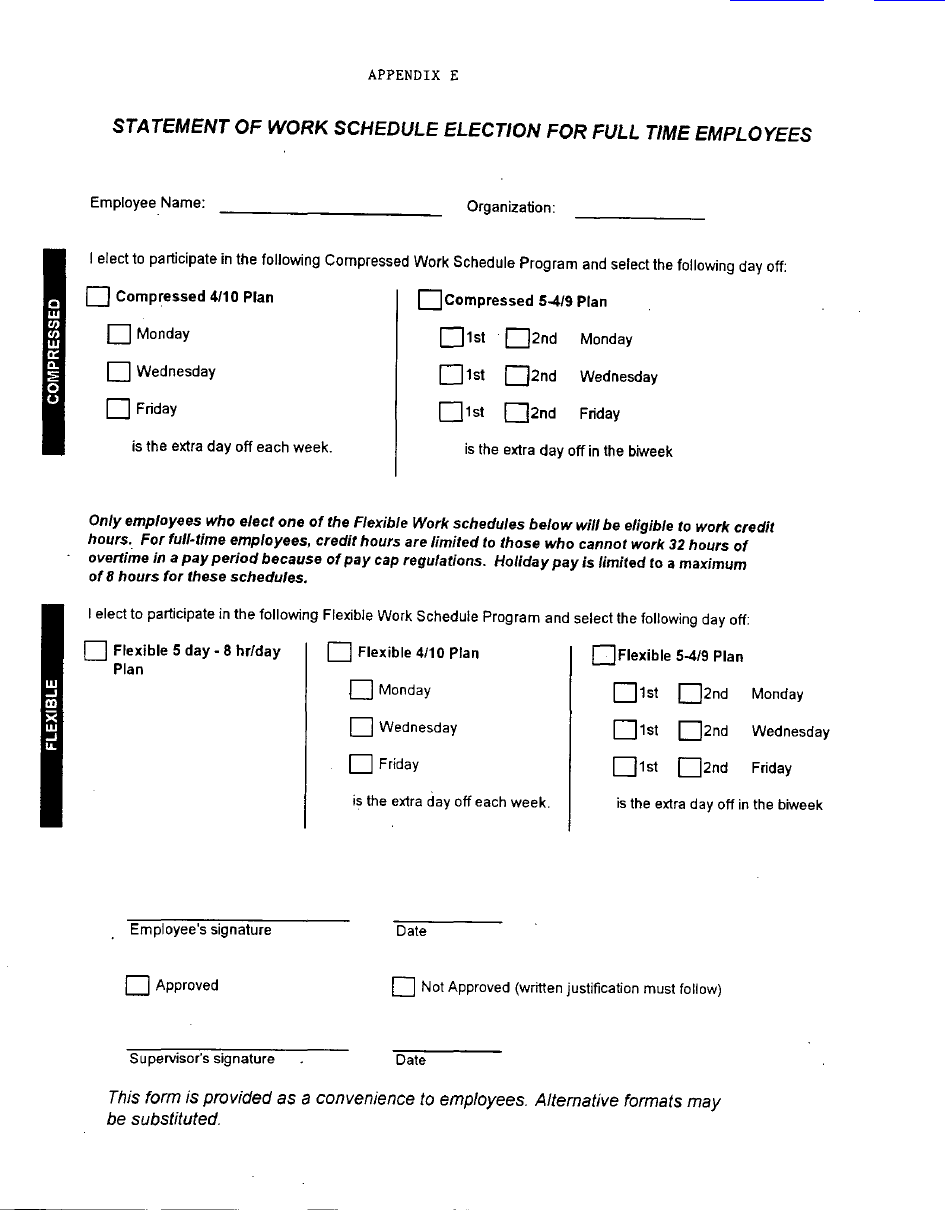
Appendices Contents
155
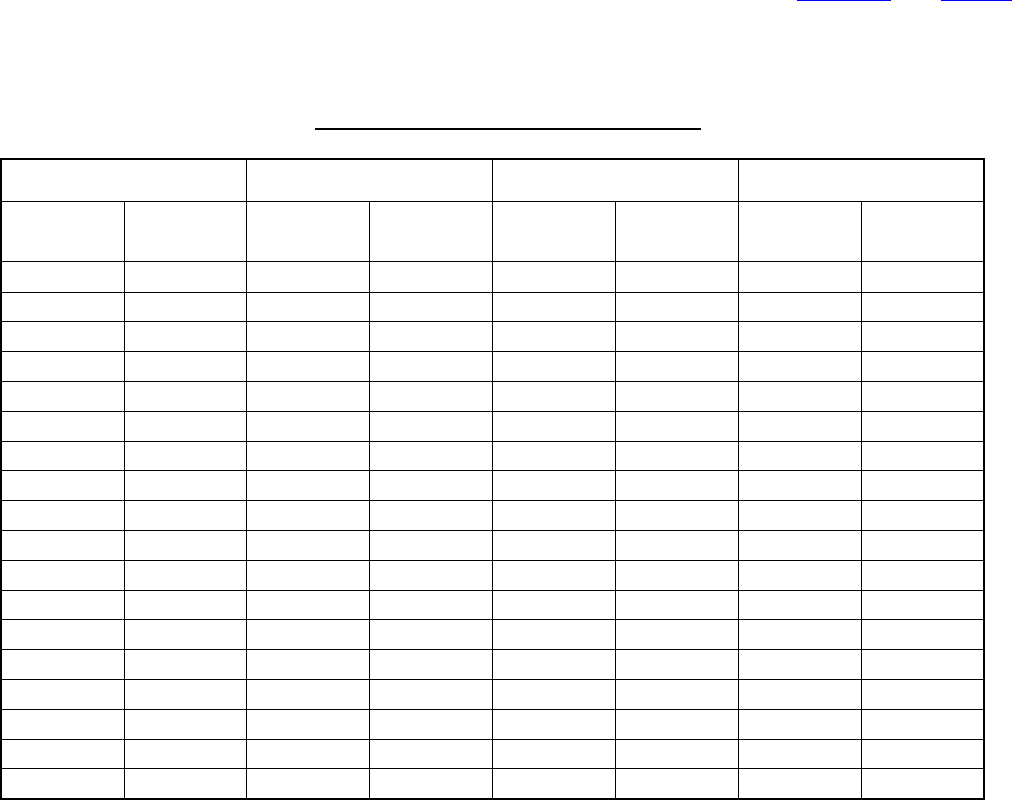
Appendices Contents
PRODUCTIVITY AWARDS SCALE
APPENDIX F
GS-12
GS-14 GS-13
GS-11
Points per
1/2 year
1/2 year
award
Points per
1/2 year
1/2 year
award
1/2 year
award
Points per
1/2 year
Points per
1/2 year
1/2 year
award
1650 $10,000.00 1650 $10,000.00 1650 $10,000.00 1650 $10,000.00
1600 $9,000.00 1600 $9,000.00 1600 $9,000.00 1600 $9,000.00
1550 $8,000.00 1550 $8,000.00 1550 $8,000.00 1550 $8,000.00
1500 $7,000.00 1500 $7,000.00 1500 $7,000.00 1500 $7,000.00
1450 $6,000.00 1450 $6,000.00 1450 $6,000.00 1450 $6,000.00
1400 $5,000.00 1400 $5,000.00 1400 $5,000.00 1400 $5,000.00
1350 $4,000.00 1350 $4,000.00 1350 $4,000.00 1350 $4,000.00
1300 $3,500.00 1300 $3,000.00 1300 $3,000.00 1300 $3,000.00
1250 $3,000.00 1250 $2,500.00 1250 $2,500.00 1250 $2,500.00
1200 $2,500.00 1200 $2,000.00 1200 $2,000.00 1200 $2,000.00
1100 $2,000.00 1100 $1,500.00 1100 $1,500.00 1100 $1,500.00
1000 $1,500.00 1000 $1,000.00 1000 $1,000.00 1000 $1,000.00
900 $1,000.00 900 $750.00 900 $750.00 900 $750.00
800 $750.00 800 $500.00 800 $500.00 800 $500.00
700 $500.00 700 $400.00 700 $400.00 700 $400.00
600 $300.00$300.00 600 $300.00 600 600 $300.00
500 $200.00 500 $200.00 500 $200.00 500 $200.00
400 $100.00 400 $100.00 400 $100.00 400 $100.00
156
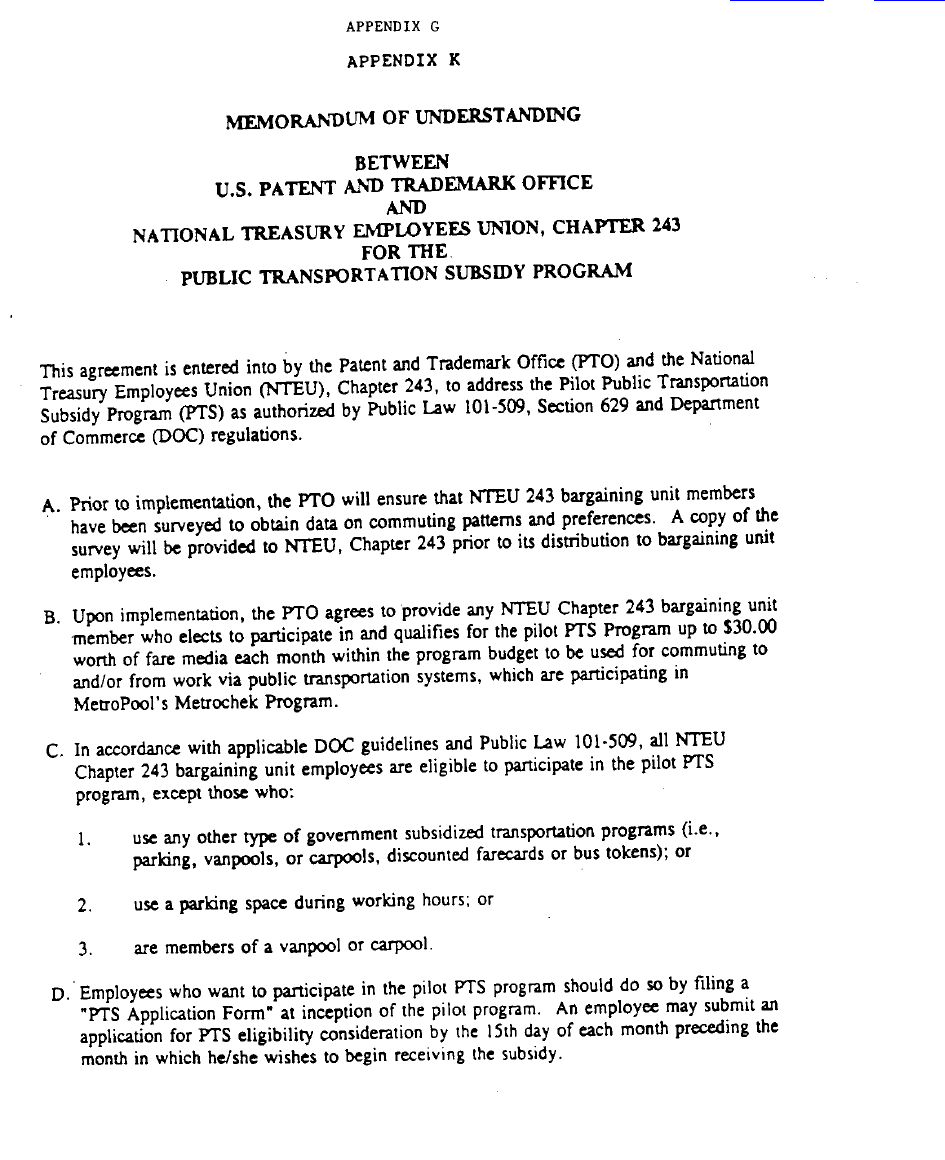
Appendices Contents
157
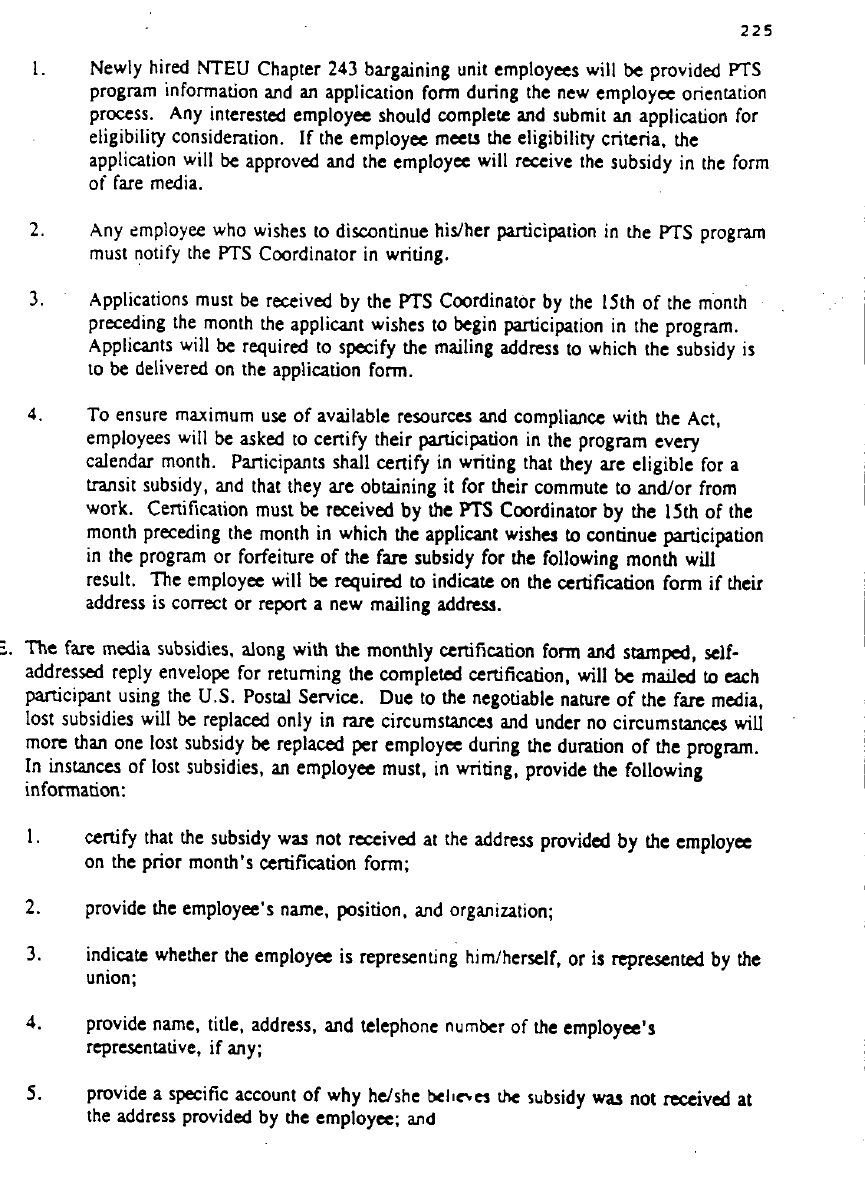
158
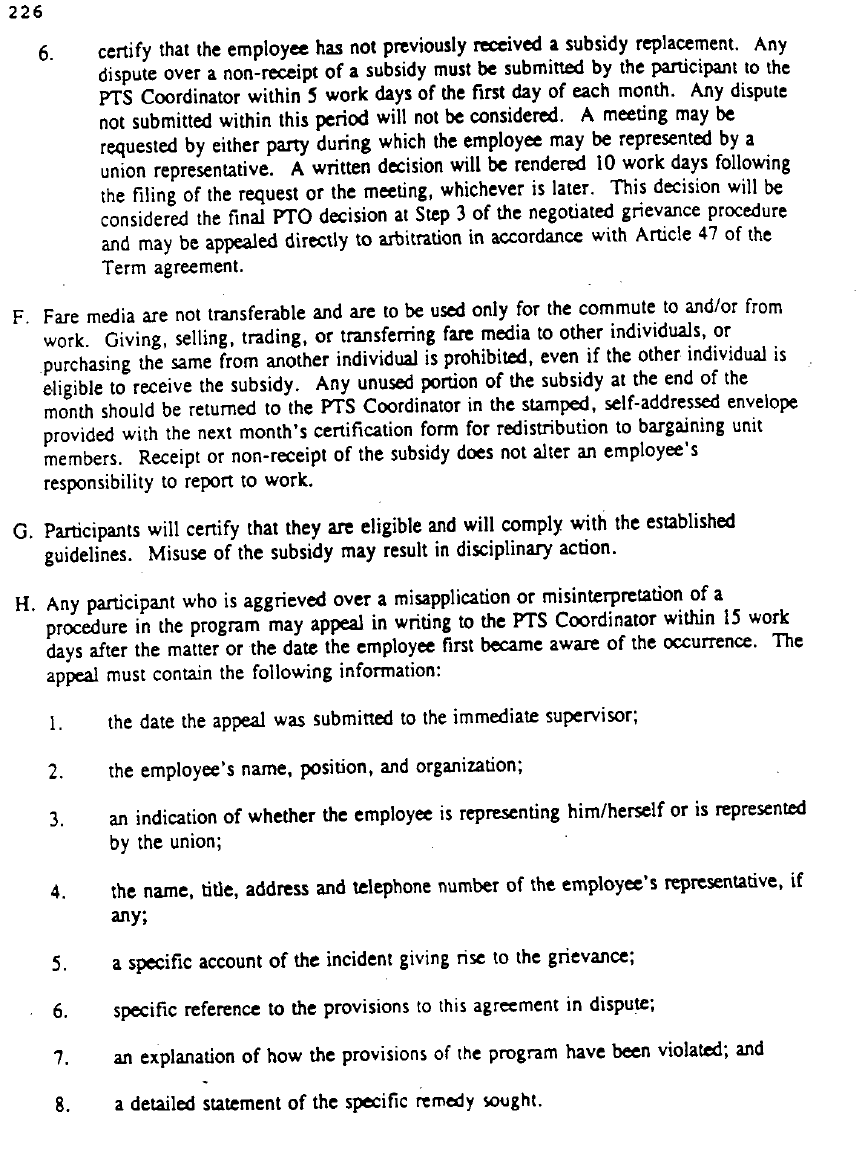
159
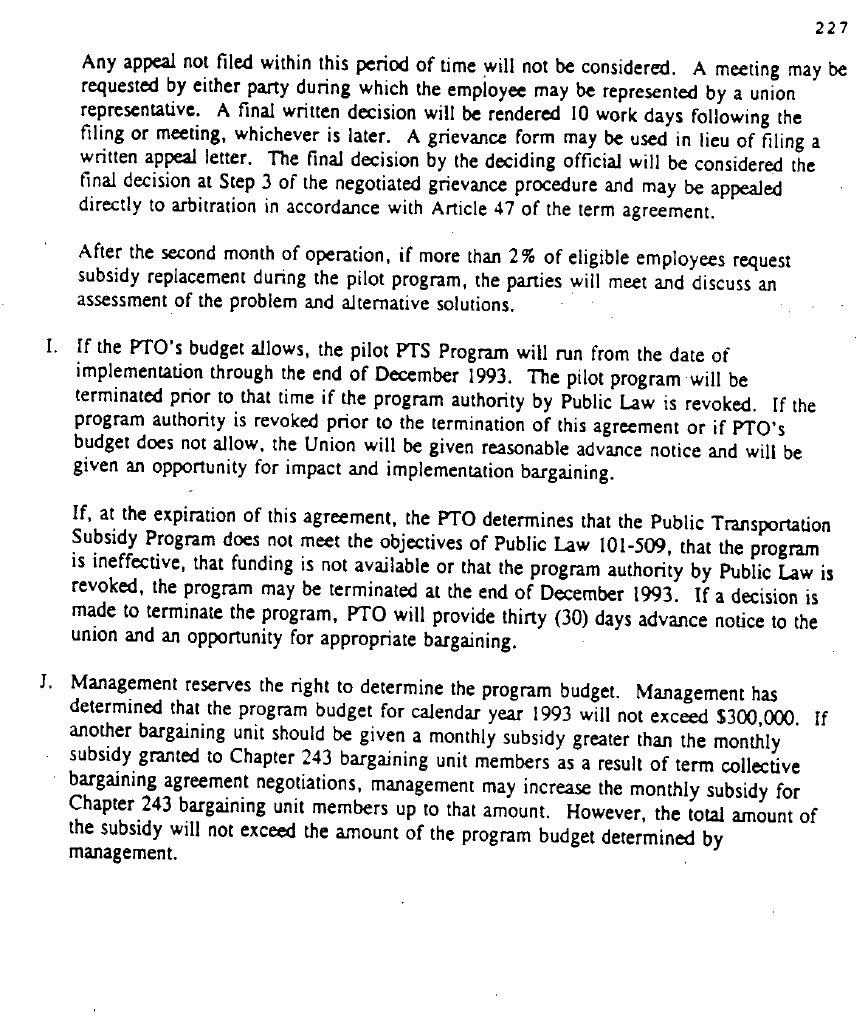
160
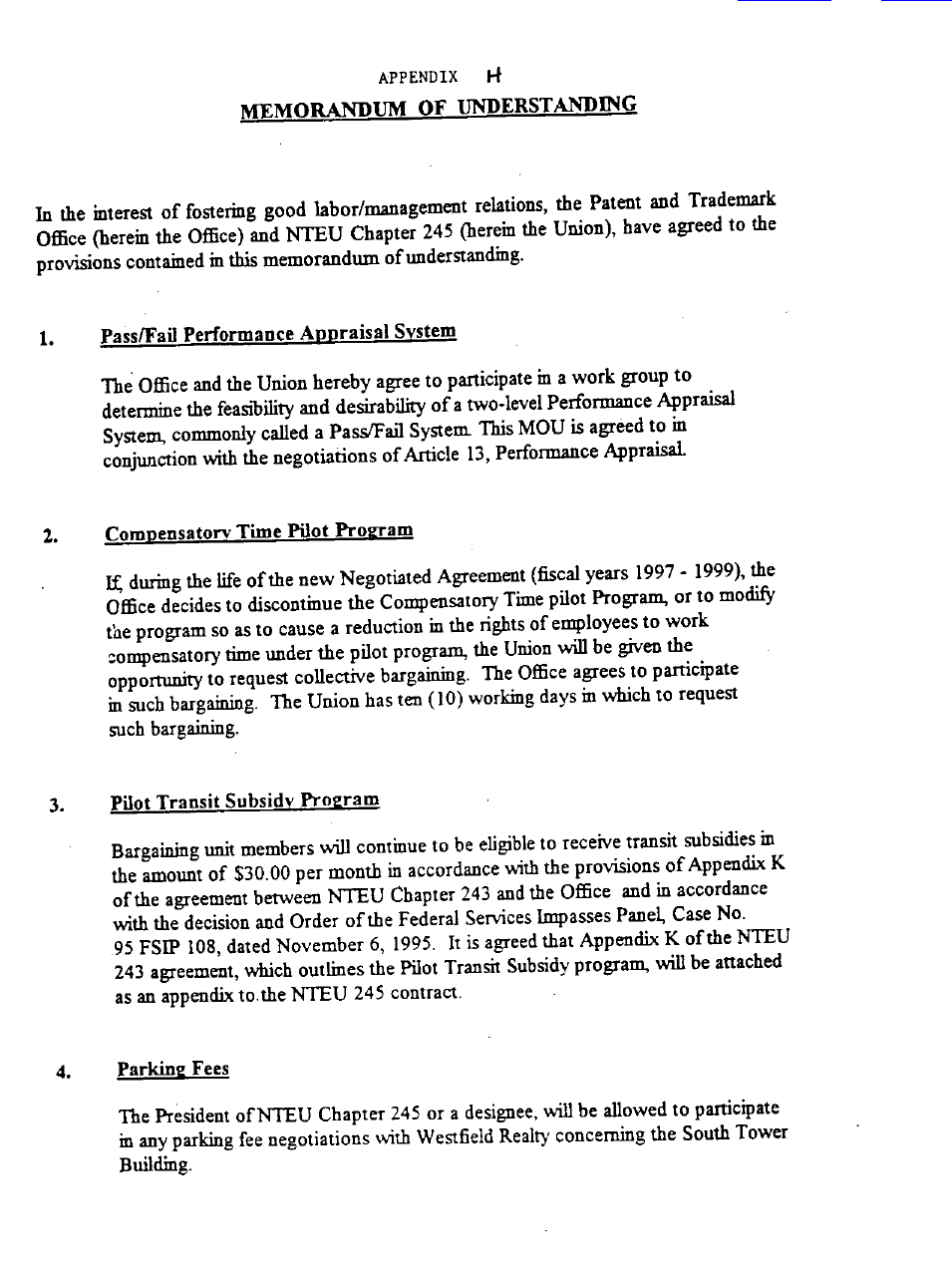
Appendices Contents
161

162
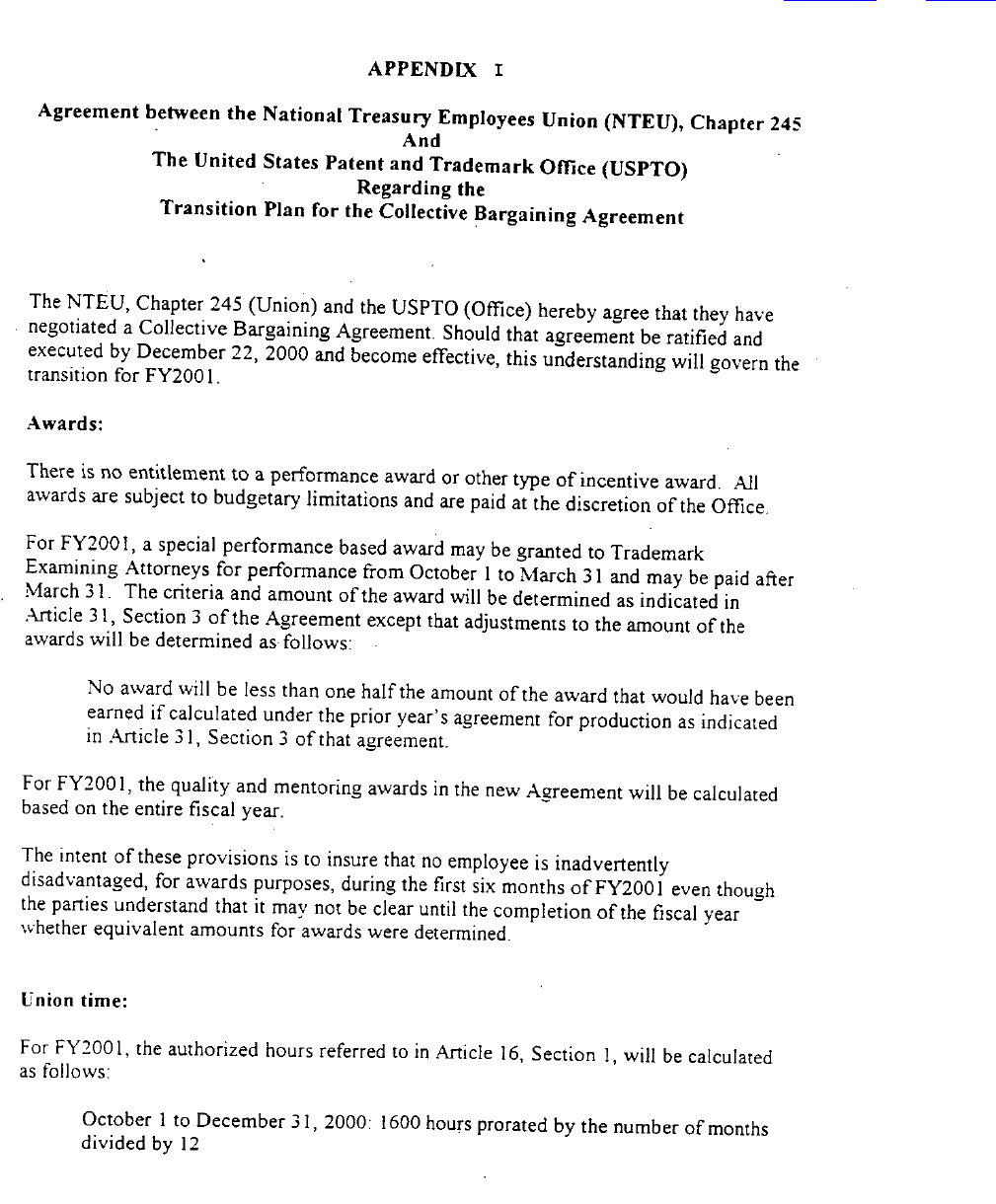
Appendices Contents
163
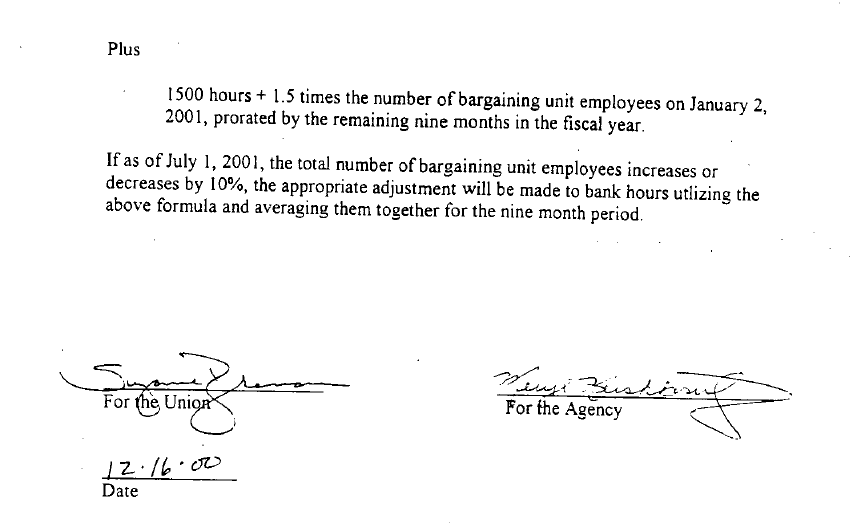
164

Contents
INDEX
SUBJECT ARTICLE SECTION PAGE
Address, providing home 8 4 16
Administrative leave due to weather
Or emergency 18 8(C) 61
Adverse Actions
- aggravating circumstances 36 3 100
Annual leave 18 2 54
- appeal 36 6 102 -
copy to union 36 7 102
- discussions with employee 36 8 102
- final decision 36 5(C) 102
- furloughs 36 1(A) 100
- mitigating circumstances 36 3 100
- notice to employee 36 4(A) 101
- off-duty misconduct 36 9 102
- oral reply 36 5(B) 101
- progressive discipline 36 3 100
- proposal, contents of 36 4(A) 101
- reductions in pay 36 1(A) 100
- relation to offense 36 2 100
- removals 36 1(A) 100
- reply by employee 36 5(A) 101
- right to representation 36 4(B) 101
- suspensions 36 1(A) 100
Agreement
- amendment to 2 3 5
- copies for union 20 2 64
- distribution of
- to bargaining unit members 20 1 64
- to the union 20 2 64
- duration of 21 1 65
- effect of past practice on 3 2 6
- effective date of 21 1 65
- PTO policy and 3 3 6
- Purpose 1 4
- renewal of 21 1 65
- reproduction of 20 1 64
- termination, procedures for 21 1 65
- to whom applies 2 2 5
165
- advances of leave 18 2(B) 54
- planned leave 18 2(B) 54
- SF – 71 18 2(E) 55
- unplanned leave 18 2(D) 55
- when granted 18 2(A) 54
Appearance of employee 8 6 16
Arbitration
- grievance 11 11(D) 26
- non-arbitrable matters 11 7 24
- procedures 11 14 27
Automated equipment 28 82
- downtime 28 4 82
Bargaining Unit
Building, see Physical Facilities
- impact and implementation bargaining 28 6 82
- inspection and maintenance 28 3 82
- new equipment 28 1(A) 82
- search time data 28 1(B) 82
- system evaluations 28 1(C ) 82
- training 28 5 82
- work environment 28 2 82
Automation, see Automated Equipment
Awards, see Performance Based Awards
- positions excluded 2 1 5
- recognition 2 1 5
Behavior of employee 8 6 16
Bereavement, leave for 18 7 60
Bulletin boards, union use of 17 1,2 51
Career development details 19 62
- administration of 19 2(A) 62
- announcement
- multiple details 19 2(B) 62
- substance 19 2(B) 62
- time frame 19 2(A) 62
- time until commencement of detail 19 2(B) 62
- definition and purpose 19 1 62
- notice to applicants 19 5 63
- notice to Union of selectees 19 4 63
- selection factors 19 3(B) 62
- selection preference 19 3(A) 62
- selection procedures 19 3(B) 62
- work projects 19 6,7 63
Child Care 24 71
Compensatory time 18 4 55
Complaints against employees 7 4(A),(B) 12
Compliments of employees 7 4(D) 13
Complying with
laws and regulations 8 1 16
166
policies 6 6 10
office hours 8 2 16
Alternate work schedules 26 1-8 74-80
- options 26 4 75
Computers, see Automated Equipment
Consultation with union, management 6 2 10
Core hours 26 3 75
Courses, seminars
- accreditation for Office sponsored
training 22 5(C) 67
- announcement of 22 2(A),(C) 66
- applicant initiated interviews 22 7 67
- compensatory time for 22 3(B) 66
- list of courses, distribution of 22 1,5(A) 66
- non-production time for 22 3(A) 66
- publications and technical material 22 6 67
- reimbursement for 22 5(A),(B) 67
- requests for 22 2(C ) 66
- restrictions on training time 22 4 66
- selection for 22 2(A) 66
- Union officers 16 7 49
Definitions 4 7
Desk audit 7 8(C ) 14
Details, see Career Development Details
Disciplinary actions
- administrative challenge 35 6 98
- aggravating circumstances 35 3 97
- copy to Union 35 7 99
- counseling 35 1(B) 97
- oral reply 35 5(B) 98
- discussions with employee 35 8 99
- falsifying records 8 8 16
- fifth amendment 7 12 15
- final decision 35 5(C ) 98
- grievance procedure 35 6 98
- mitigating circumstances 35 3 97
- notice to employee 35 4(A) 98
- off-duty misconduct 35 9 99
- progressive discipline 35 3 97
- proposal, contents of 35 4(A) 98
- refusal to answer inquiry 7 12 15
- relation to offense 35 2 97
- reply by employee 35 5(A) 98
- right to representation 35 4(B) 98
- suspensions 35 1(A) 97
- untruthful answer 8 9 17
- Weingarten meeting 7 7 13
- Written reprimands 35 1(A) 97
Dress of employee 8 6 16
167
Duration and Amendment 21 65
Dues withholding
- eligibility 32 1 90
- procedures 32 2 90
- revocation by employee 32 3 91
- termination by the Office 32 4 91
- procedures for revocation 32 5 92
- procedures in event of underpayment 32 5 92
- procedures in event of overpayment 32 6 92
- adjustments to salary 32 7 92
- waiver of overpayment 32 7 92
- magnetic dues withholding tapes 32 8 92
- NTEU financial programs 32 8 92
- fees for service 32 9 93
Employees
- behavior 8 6 16
- complying with laws and regulations 8 1 16
- complying with policies 6 6 10
- contact with the public 8 7 16
- dress 8 6 16
- employee assistance program 13 3(B) 39
- obligations 8 16
- rights 7 12
Employment, see Part-time, Outside
Equal employment opportunity
- affirmative action plan 29 3 83
- complaint procedure 29 3 83
- complaints, numbers and types of 29 4(B) 83
- counselor system 29 5 83
- distribution of EEO counselor lists 29 7 84
- informal EEO counseling 29 6 83
- posting of EEO counselor lists 29 7 84
- Federal EEO Program 29 1 83
- protected classes 29 2 83
- work force composition 29 4(A) 83
Extension of time in grievance 11 15 29
Facilities, see Physical Facilities, Union Facilities
Facsimile machine, union use of 17 6 51
Falsification of records
Office records 8 8 16
Flexitime 26 1-3 74-75
- core hours 26 3 75
Formal meetings 9 4,5 13
Fund raising drives 7 5 13
Grievance
- combining multiple grievances 11 8 24
- definition 11 3 22
- extension of time limits 11 15 29
168
- failure to meet requirements,
effects of 11 6 23
- multiple grievances, combining 11 8 24
- non-grievable matters 11 4 23
- declaration of 11 7 24
- non-grievance, informal discussion 11 9 24
- negotiated agreements and 11 2(A) 22
- termination 11 5 23
- agency head review 33 6 95
- start of negotiations 33 2(D) 94
- requesting 18 3(B) 55
- procedure 11 24
- who may use them 11 2(B) 22
- rights of parties and union 11 13 26
- representation 11 13 26
- self-representation 11 10 24
- steps in processing grievance 11 11 24
GWPAS, and performance appraisal 13 1 37
Impact and Implementation bargaining
- clarification meeting 33 2(B) 94
- collective bargaining agreement and 33 5 95
- disapproval of agreement 33 7 95
- distribution of MOU’s 33 4 95
- emergency 33 1 94
- groundrules 33 3 94
- joint labor team negotiations 33 1 94
- memoranda of understanding 33 4 95
- notice to Union 33 2(A) 94
- proposals for 33 1 94
- union counterproposal 33 2(C ) 94
Information
- access to 7 9 14
- personal, confidentiality 10 8 21
Investigation of employee 7 12 15
Laws, precedence of 3 6
Leave, see also specific type of leave 18 53-61
Leave
- abuse, refraining from 8 2 16
Letter of reprimand 18 8(A) 61
Management
- obligations 6 10
- rights 5 9
Maternity leave 18 3 55
- length of absence 18 3(A),(C) 55
- medical certificate for 18 3(B),(C) 55
- modification of job duties 18 3(E) 55
- sick leave and 18 3(A),(B) 55
- type of leave used 18 3(A) 55
169
Meeting space, union use of 17 3 51
Office space, see Physical Facilities
- approval 25 2(A) 72
- failure to request approval 25 4 73
- notification of 15 6 47
- when authorized 15 1 47
Military leave 18 8(C) 61
Negotiation with union 6 2 10
Newly hired attorney list 6 4 10
Off duty misconduct 7 11 15
Office hours, complying with 8 2 16
Official personnel folder 7 6 13
Oral admonishments
Orientation session 9 6 18
Outside Employment
- changed circumstances 25 2(B) 72
- government equipment (use of) 25 5 73
- prohibition criteria 25 1 72
- requests for approval 25 3 72
Overtime
- announcement of 15 1 47
- assignment of 15 4,5 47
- disciplinary action and 15 2,3 47
- falsification of records 15 2 47
- grievance procedure and 15 4 47
- scheduling of 15 6 47
- training for 15 4 47
Part-time employment 23 68
Past practices superceded 3 2 6
Paternity leave 18 3(D) 55
Paycheck, see Salary
Performance appraisal 13 37
- appeal
- from action to remove non-veteran 13 3(E)(2) 39
- from action to remove veteran 13 3(E)(1) 39
- to approving official 13 1(F) 37
- arbitrator may change score 13 5 41
- changing performance plan
- notification of change 13 1(B)-(D) 37
- temporary change 13 1(D) 37
- extraordinary business
emergency 13 1(D) 37
- Civil Service Due Process
Amendments
170
- Exceptions 13 3(E) 39
- criteria used in rating
- performance during appraisal period 13 1(I) 37
- observation of rating official 13 1(J) 38
- supplemental standards 13 1(K) 38
- disagreements over rating 13 1(F) 37
- distribution of PAP (timing) 13 1(G) 37
- employee assistance program (OEAP) 13 3(B) 39
- extension of due date of official rating 13 1(J) 38
- extraordinary business emergency 13 1(D) 37
- GWPAS and 13 1 37
- Narrative for all scores above FS 13 4 41
- Performance improvement period (PIP) 13 3(F) 39
- Reduction in grade or removal 13 3(D) 39
- Notice in writing of 13 3(H)(1-4) 40
- removal of record 13 3(N) 41
- representation for oral reply 13 3(J) 40
- resignation in lieu of removal 13 3(M) 41
- unacceptable performance 13 3 39
- copy of decision to union 13 3(O) 41
- contents of actions 13 3(L) 41
- evidence to support removal
or reduction in grade 13 3(I) 40
- meetings with employee/union 13 3(G) 39
- notice requirements 13 3(H)(1-4) 40
- oral replies (summary) 13 3(K) 40
- performance improvement period 13 3(F) 39
(PIP)
- period covered in action for removal 13 3(L) 41
- proposed action 13 3(H)(1-4) 40
- reduction in grade or removal 13 3(D) 39
- removal of record 13 3(N) 41
- union representations 13 3(J) 40
- unacceptable performance, notice of 13 3(A) 39
- transfers to different offices (perf) 13 3(C ) 39
- unfair rating 13 1(H) 37
- union role
- in developing perform. Plans 13 1(E) 37
- in meeting with employee 13 3(G) 39
- within grade increase
- criteria for earning 13 2(A) 38
- denial of 13 2(B)-(E) 38
- work details and 13 1(A) 37
Performance awards
- budgetary limitations 31 1 86
- change in PAP and 31 7 88
- discretion of Office 31 1 86
- duration 31 1 86
- eligibility for 31 2(A)(B)(C) 86
171
- incentive awards 31 1 86
- quality step increases 31 8 88
- shortage of funds 31 6 88
- when paid 31 3(B),4(C),5(B)86-88
Personal computer, union use of 17 4 51
Personnel folder, official 7 6 13
Photocopy machine, union use of 17 5 51
- painting and cleaning 14 6 44
Position descriptions, changes to 7 8 14
Physical Facilities
- administrative leave (excused) 14 12 45
- air conditioning 14 11(A) 45
- assignment of office space 14 10 45
- decorating and maintaining space 14 3 44
- govt-wide space utilization regs 14 2(H) 44
- health and safety committee 14 14 46
- health and safety inspections 14 7 44
- heating and cooling 14 11(A) 45
- illnesses and injuries 14 8 45
- injuries and illnesses 14 8 45
- library (access to) 14 5 44
- lighting, heating, cooling 14 11(A) 45
- maintaining and decorating space 14 3 44
- new equipment data 14 13 46
- office size 14 2(A) 42
- office space (assignment of) 14 10 45
- reallocation of existing space 14 2(B) 42
- rule and regulations 14 1 42
- safety inspections 14 7 44
- smoking rules 14 4 44
- space utilization regulations 14 2(C ) 42
- ventilation, heating and cooling 14 11(A) 45
- workers compensation claims 14 9 45
Policies given to employees 6 6 10
Preamble 1 4
Previous agreements superceded 3 2 6
Professionalism 22 66
Prohibited union actions 10 5 20
Promotion
- career ladder promotions 12 7 34
- competitive promotions 12 3(A) 30
- delays in promotions 12 12 35
- disadvantageous position 12 5 34
172
- duration of certificate 12 4(K)(7) 33
- excessive number 12 4(K)(2) 32
- grievances 12 4(N) 34
- information regarding selection 12 4(L) 33
- interview with selecting official 12 4(K)(8) 33
- leave 12 8 35
- “Merit Assign Program Cert” 12 4(K) 32
Public contact, employee behavior 8 7 16
Rating, see Performance Appraisal
- minimum requirements 12 4(C ) 31
- more than one vacancy 12 4(K)(3) 32
- non-tmo employee selection 12 4(K)(6) 33
- notice to applicants 12 4(E) 31
- number of candidates 12 4(K)(1) 32
- panel for ranking 12 4(G) 31
- personnel actions (requests for) 12 11 35
- posting and distribution 12 4(A) 30
- priority for TMO employees 12 4(K)(4) 32
- promotion 12 4(K)(9) 33
- “Qualified and “Best Qualified” 12 4(H) 31
- ranking factors 12 4(D) 31
- ranking of applicants 12 4(G) 31
- reassignment 12 3(C ) 30
- reassignments/staffing imbalance 12 13 36
- requests for transfers 12 10 35
- right of Office to 12 2 30
- selection criteria 12 1 30
- selection report for union 12 4(M) 33
- staffing goals and hiring plans 12 9 35
- substance of 12 4(B) 31
- temporary assignments 12 6(B) 34
- temporary promotions 12 3(B) 30
- temporary promotions 12 6(A) 34
- vacancy announcement
Questions – truthful answers to 8 9 17
Reassignment, see Promotion
Receipt of Pay 27 81
Reduction – in – force
- attrition, instead of RIF 30 1 85
- impact and implem. barg. 30 3 85
- Union notification of RIF 30 2 85
Regulations
- Depart. Of Commerce, precedence 3 1 6
- Govt wide, precedence 3 1 6
- Right to make 5 4 9
Religious observances, leave for 18 6 60
173
Reorganizations
- consulting with union 6 3 10
Representation in grievance 11 13 26
Reproduction and Distribution 20 64
Resignation 7 10 14
- in lieu of removal 13 3(M) 41
- proposed discipl or adverse action 7 10(C ) 14
- withdrawing 7 10 14
Salary
- direct deposit
- electronic funds transfer
- emergency salary payments
- processing errors
- replacement salary checks
Seminars, see Courses
Smoking, see Physical facilities
Standards of conduct for Union 10 2 20
Tardiness, infrequent, see also Office hours 18 8 61
Telephone
- messages 8 3 16
- number of union president 6 7 11
- providing home number 8 4 16
Time used by Union
- adverse action hearing 16 12 48
- approval procedure 16 8(A),9 49
- arbitration hearing 16 2(H)(2) 48
- basic negotiations groundrules 16 2 48
- counseling of employees 16 1(A) 48
- denial of 16 9 49
- discrimination complaints 16 1(A) 48
- grievance
- preparation for 16 1(A),10 48-50
- grievant 16 10 50
- witnesses 16 11 50
- presentation of 16 1(D), 11 48-50
- observer at 16 1(D) 48
- impact and implementation
- impact and implementation barg. 16 2 48
- Interpretation of Agreement
- Interpretation of Agreement or CSRA 16 1(E) 48
- Investigation by management 16 12 50
- Meeting with Trademark
- Meeting with Trademark Advisory 16 1(F) 48
- Meetings with Office
174
- Office initiated 16 3 49
- Preparation for 16 1(B) 48
- Informal 16 1(B) 48
- meetings with unit members
- to discuss working conditions 16 4 49
- to discuss contract 16 7 49
- orientation 16 2(E) 48
- MSPB hearing 16 2(B) 48
- Notice for supervisor 16 9 49
- Official or “bank” time
- Amount 16 1 48
- Authorized uses of 16 1 48
- quarterly records 16 8(B) 49
- reasonable time
- when granted 16 2 48
- review of documents 16 1(C ) 48
- solicitation of dues or members 16 5 49
- timesheets and 16 8(A) 49
- training for Union officers 16 6 49
- unfair labor practices charge 16 2 48
Training, see Courses, Seminars
Transfers to different offices
- requests for transfers 12 10 35
- for improving performance 13 3(C ) 39
Trial period employees
- notice of performance 34 1 96
- right to terminate 34 3 96
- voluntary resignation 34 2 96
Unfair labor practice, advance notice 10 3 20
Union
- facilities 17 51
- bulletin boards 12 1,2 51
- facsimile machine 17 6 51
- meeting space 17 3 51
- personal computer 17 4 51
- photocopy machine 17 5 51
- printer 17 4 51
- obligations 10 20
- prohibited actions 10 20
- representative, right to 7 7 13
- rights 9 18
- standards of conduct 10 2 20
Union Representation and Official Time 16 48
Union time, see Time used by Union
Vacancy announcements, see Promotion
Weather, leave due to inclement 18 8(C ) 61
Weingarten meetings 7 7 13
175
Within grade increases
- criteria for earning 13 2(A) 38
- denial of 13 2(B)-(E) 38
Work projects, see Career Dev. Details
Work Schedules, see also Flextime
And Alternate work schedules 26 74
Work schedules and other barg. Units. 26 8 80
176
